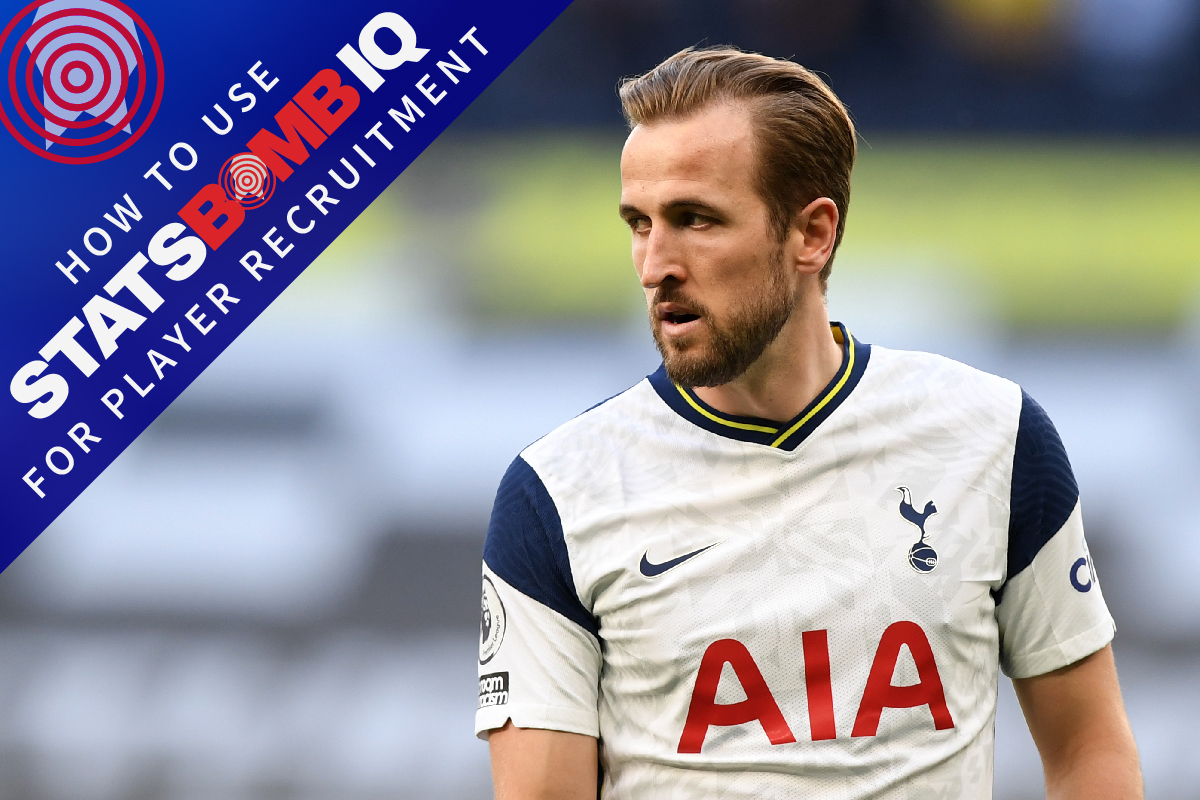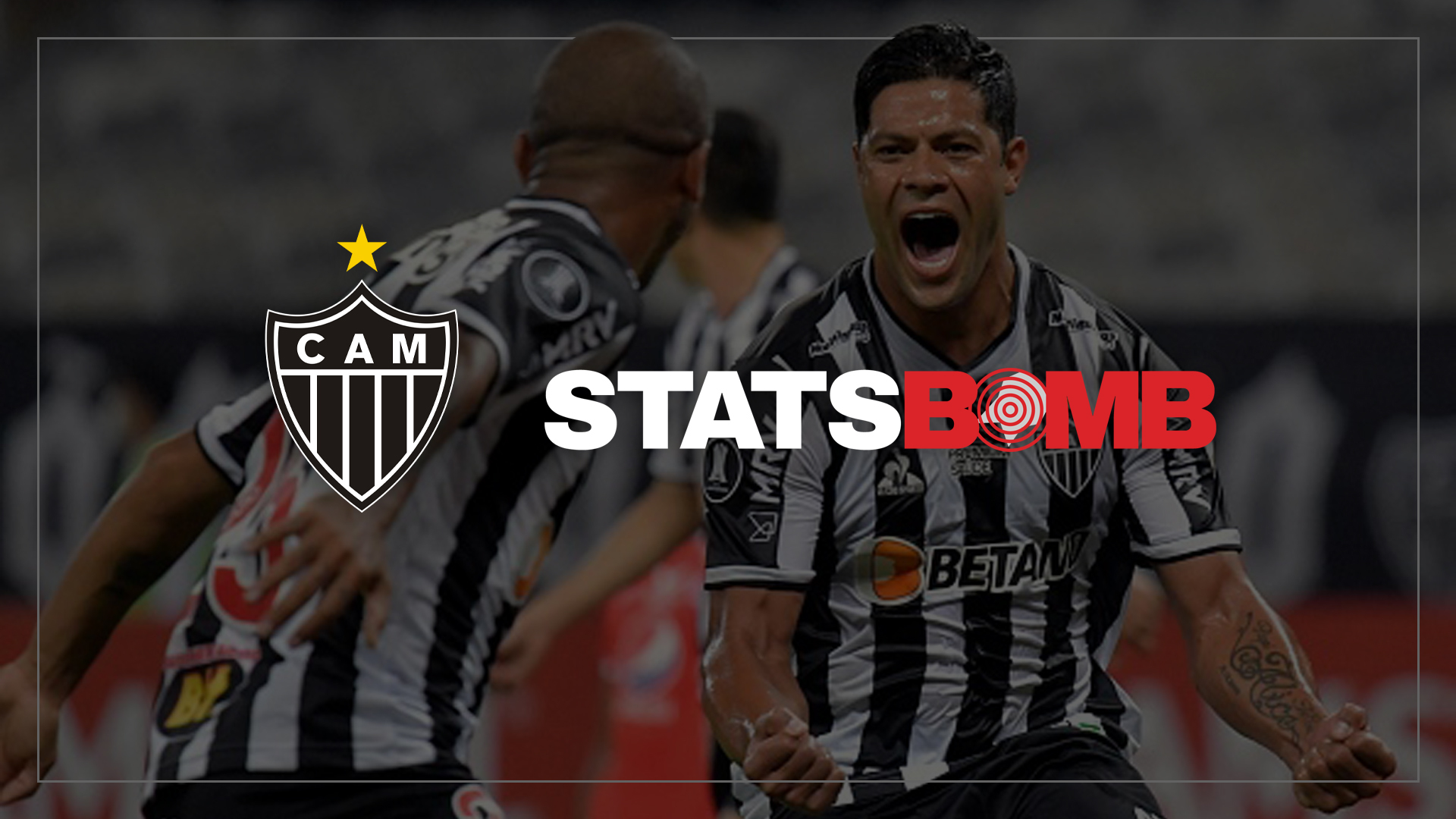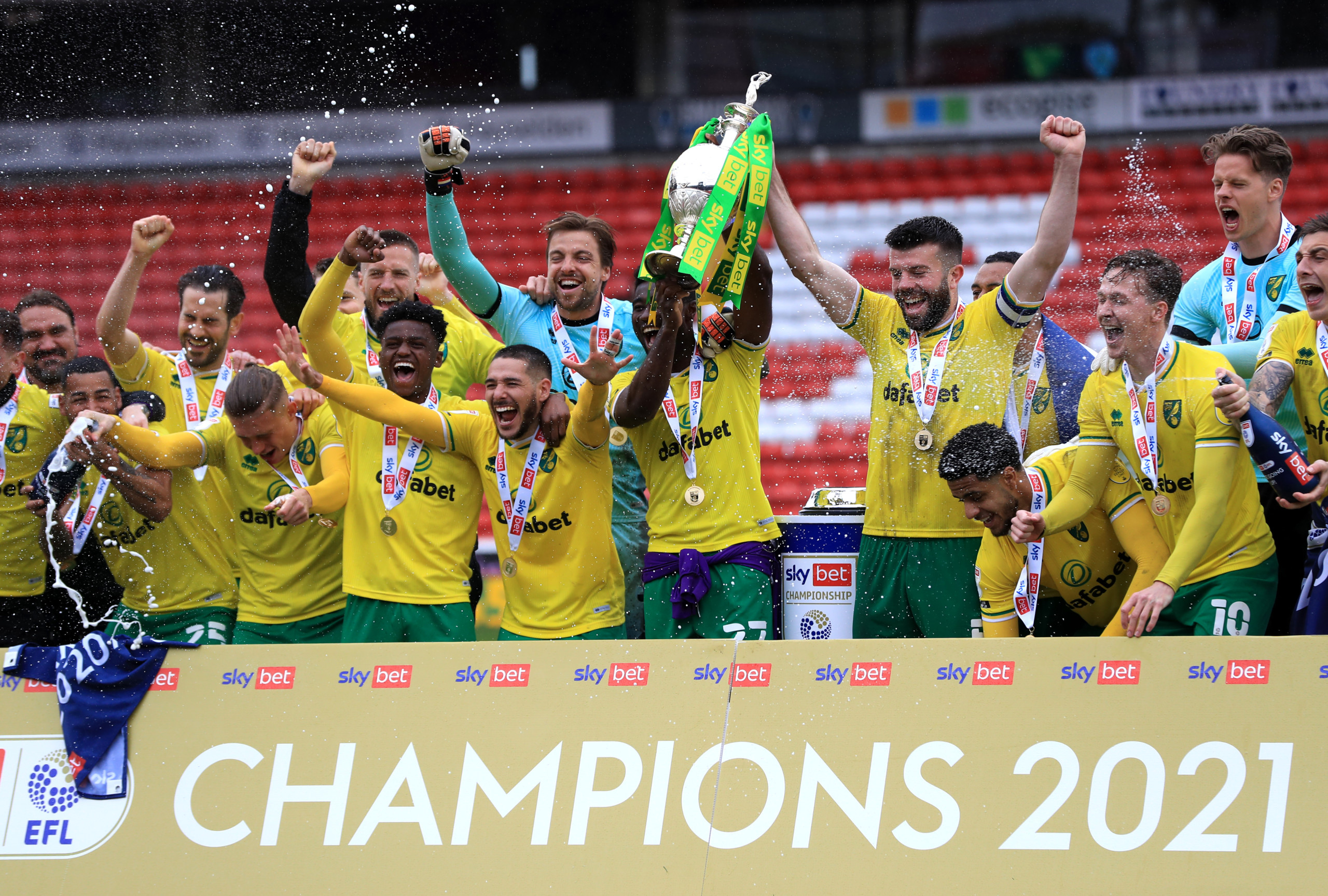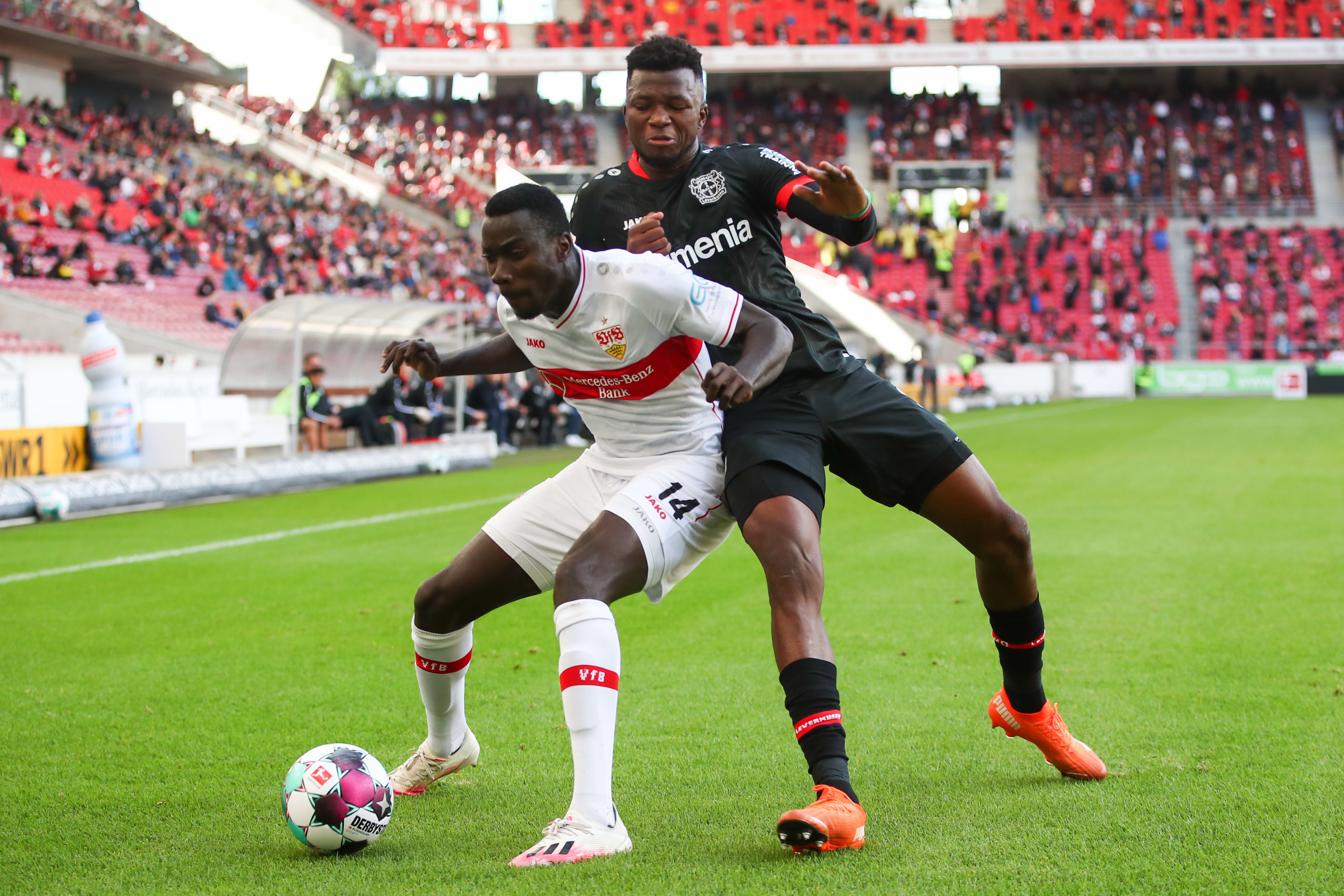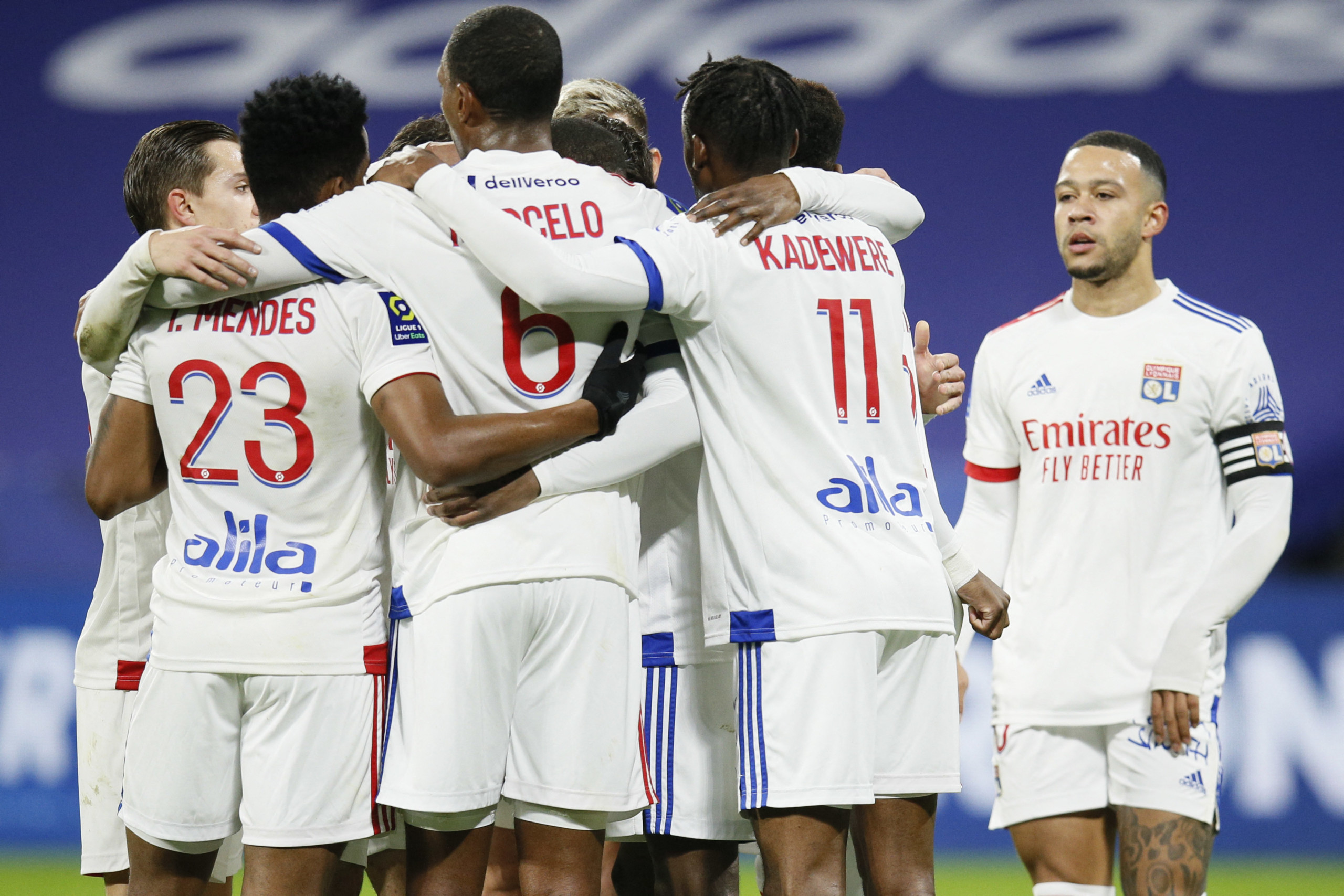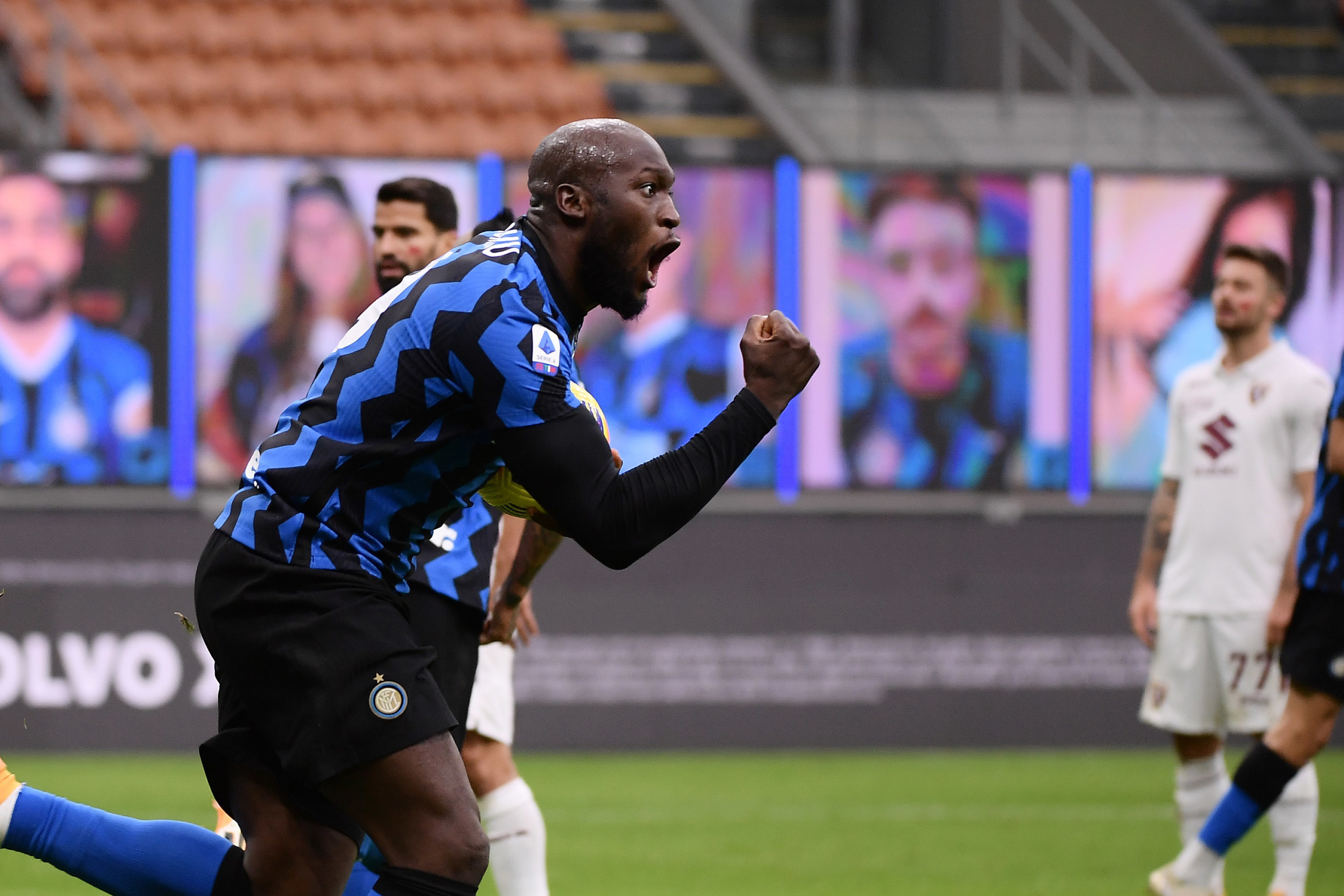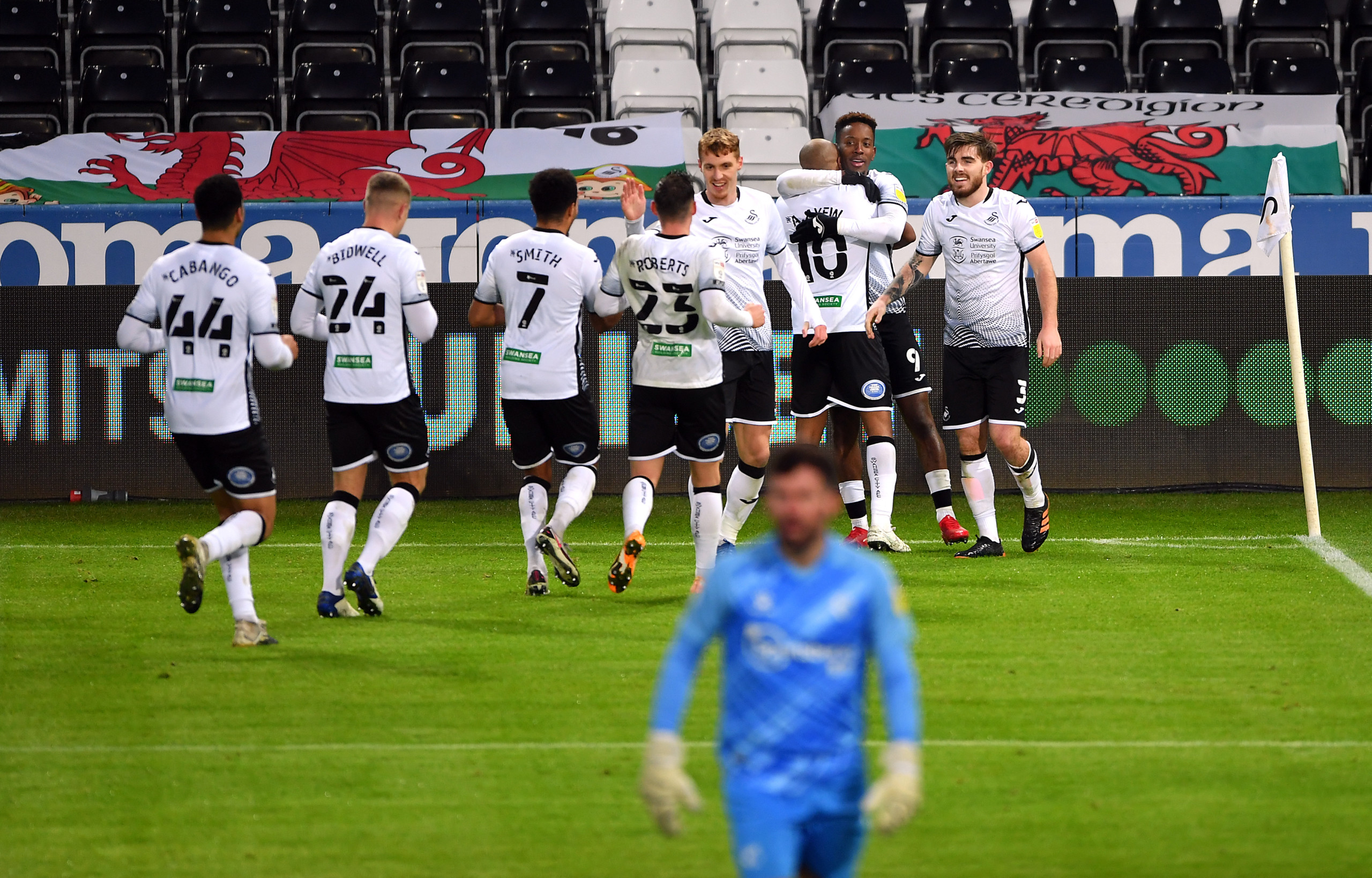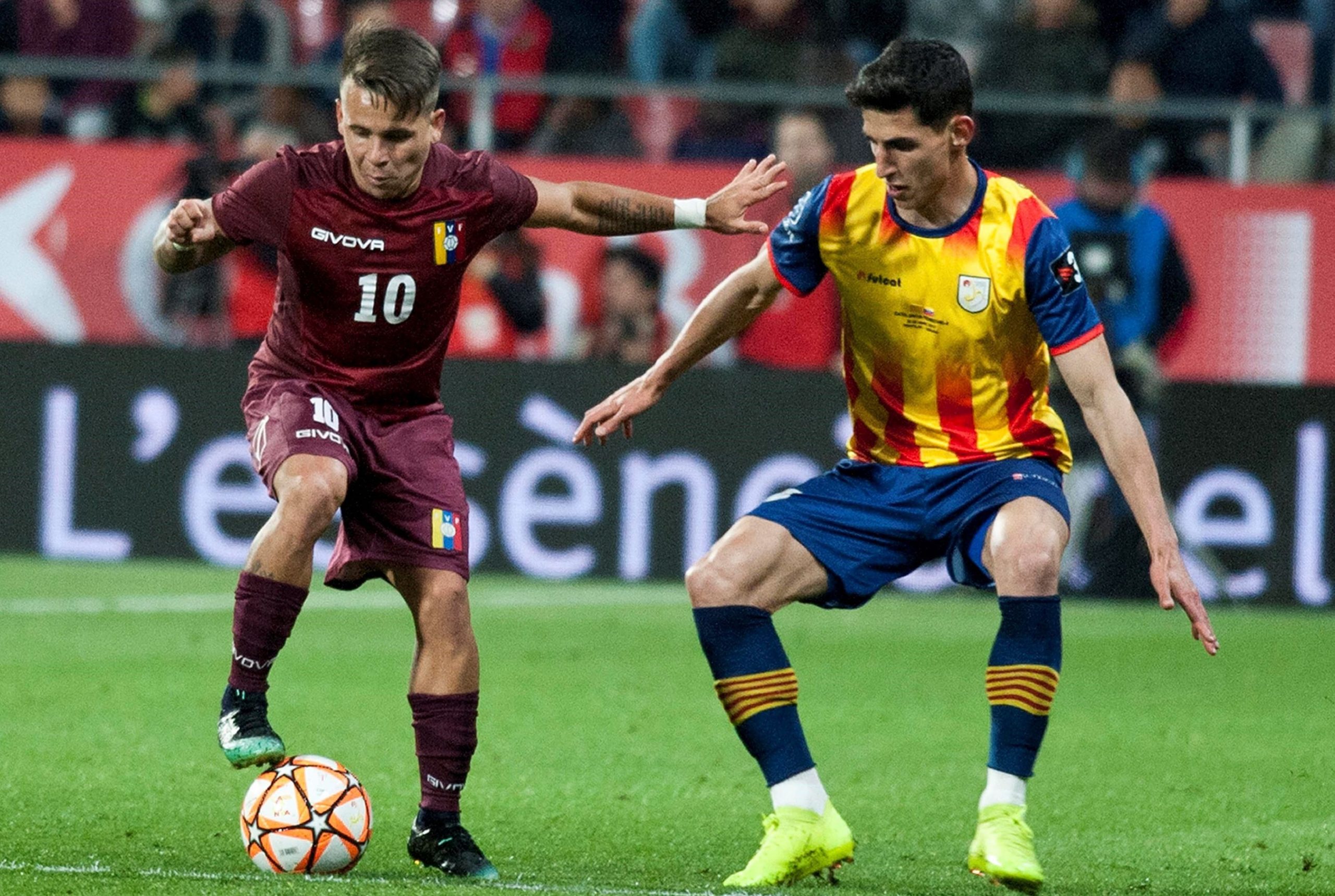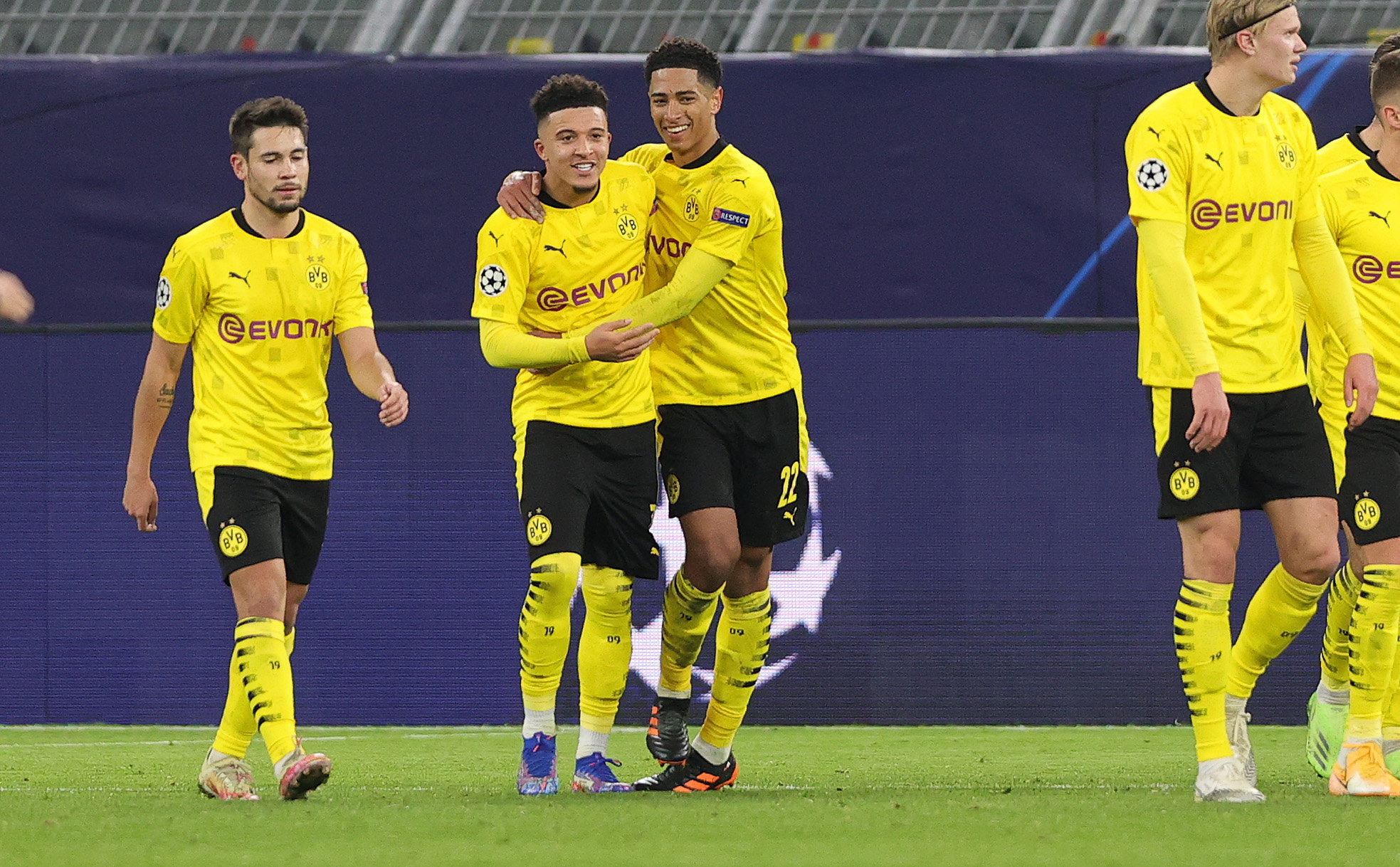Right now, dozens of clubs around the world will be using StatsBomb IQ to aid their player recruitment planning and shortlisting ahead of the summer transfer window. IQ is designed by analysts, for analysts, with the goal of making data-driven insights easily accessible and digestible. Most importantly, it saves valuable time and resources for the time-poor analyst and is flexible and customisable to each user's specific needs.
Data can be used at all stages of the recruitment process, from the initial shortlisting, down to more granular player assessments, to support qualitative live and video scouting and background personality checks. Yesterday, we showed how data can be used in the early stages of the recruitment process to create a shortlist of forwards that might be worth further scouting. Today we're going to do the same with centre backs, starting with Burnley's James Tarkowski.
It's well known that Burnley have a particular - and effective - approach to defending when out of possession. If their opposition has possession deep in their own half, particularly from goal kicks, Burnley will play a high line and look to force their opponents to play the ball long, where they know their centre backs will more often than not win their duels near the halfway line. This is shown in their Defensive Distance: the average distance from their own goal that a team makes a defensive action.
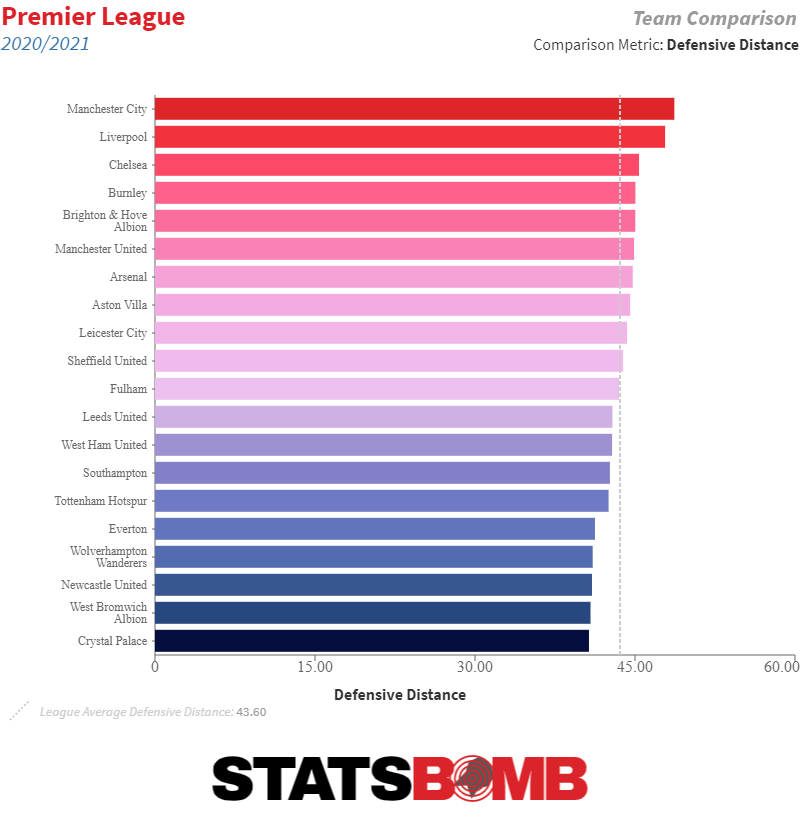
However, should the opposition break the initial press and start to progress into the middle third and beyond, Burnley look to drop in and decrease the space between the lines, keeping a compact shape and defending any balls that come into the box. Their prioritising of their shape over engaging the opposition is reflected in their Aggression % - the percentage of opposition pass receipts that are pressured, tackled, or fouled within two seconds - of 16%, the lowest in the league.
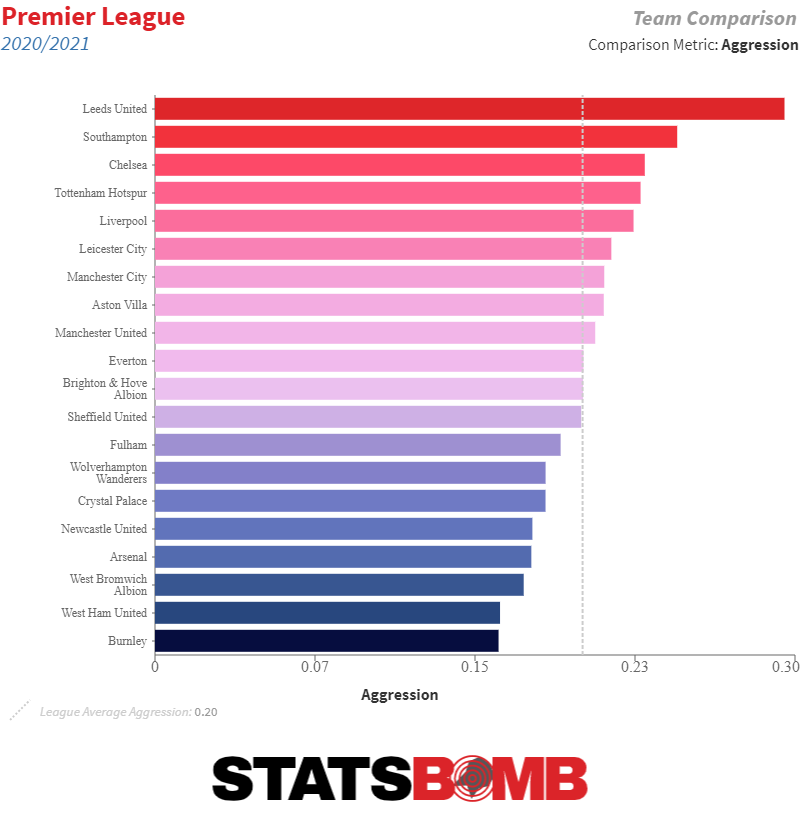
For Tarkowski, this means that his main responsibilities as a Burnley centre back can be condensed into: being strong in aerial duels, being strong in ground duels, and defending his penalty box well, with little-to-no expectation on him to be an effective player in possession. Given Tarkowski's importance to Burnley, and the fact he's been linked with moves away in previous windows, it'd be sensible for Burnley to be planning and searching for potential successors already. Let's use StatsBomb IQ to help us do this.
1) Create And Edit A Radar Template
The first thing to do is adjust the standard Centre Back radar template to include metrics that best reflect Tarkowski's player profile and give us the best chance of finding a player that could replace him.
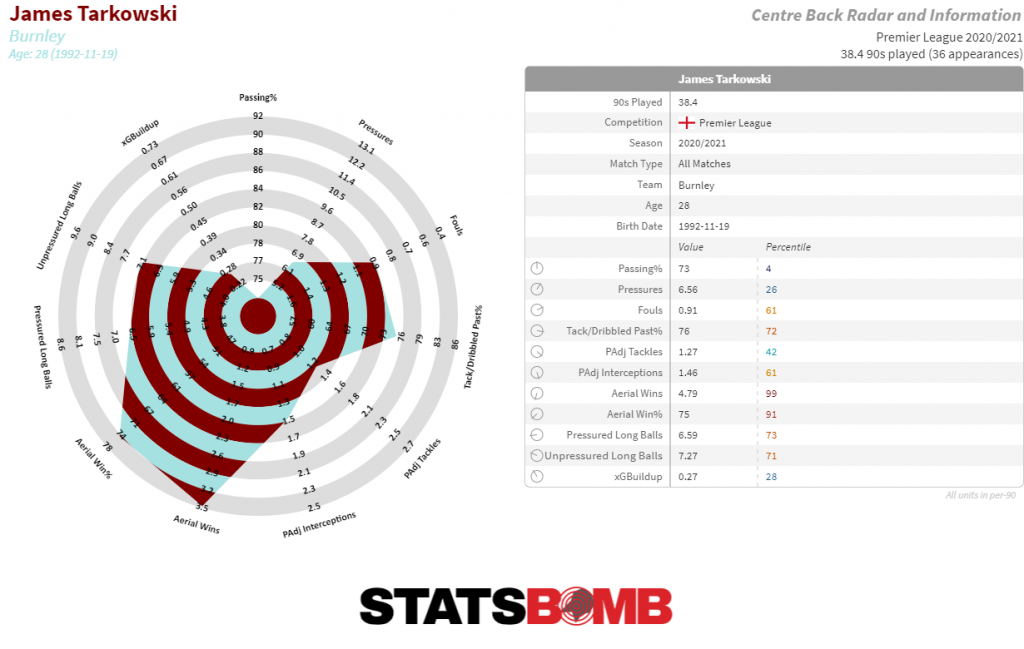
As mentioned, we're not expecting Tarkowski or his replacement to be highly effective in possession, so we'll remove Passing %, Pressured Long Balls, Unpressured Long Balls and xGBuildup from the standard radar template. In their place, we'll add:
- Average Defensive Action Distance: The average distance from the goal line that the player successfully makes a defensive action
- Clearances: Number of clearances made by a player
- Blocks/Shot: Blocks made per shot faced
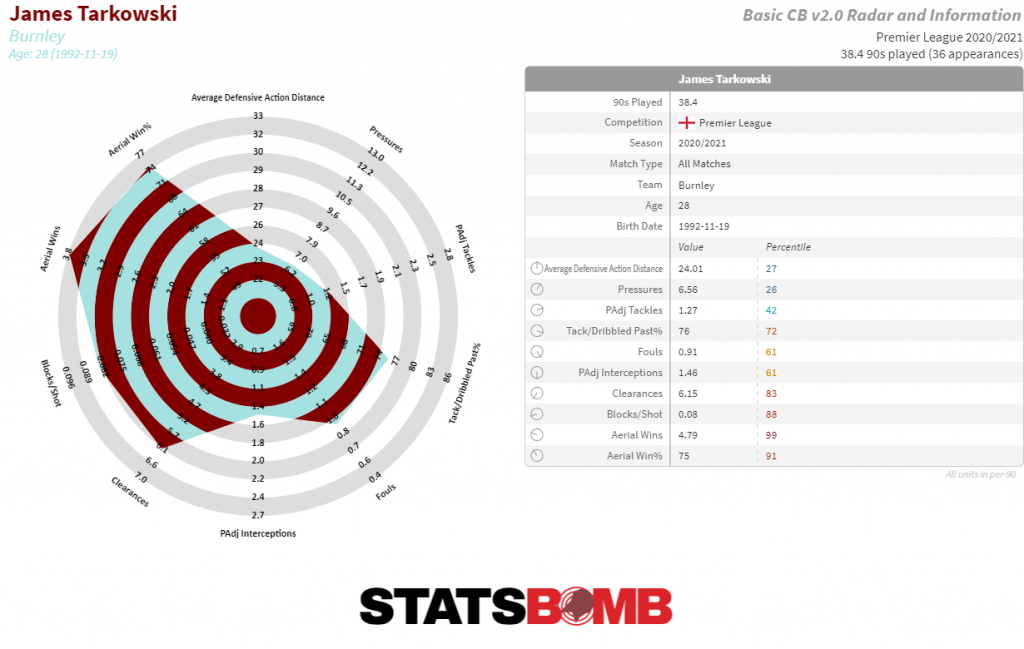
We can see that Tarkowski is an excellent performer in aerial duels (in the 99th percentile for Aerial Wins and 91st percentile for Aerial Win %), ground duels (72nd percentile for Tackle / Dribbled Past %*), and defending his box (88th percentile for Blocks / Shot and 83rd percentile for Clearances). *Tackle / Dribbled Past %: Percentage of time a player makes a tackle when going into a duel vs getting dribbled past.
When we're happy that the radar reflects the profile of player we'll be searching for, we can save the template for repeated future use. But how can we use this information to find a potential replacement?
2) Use StatsBomb's Similar Player Search Tool
The first thing to do in Similar Player Search is to set the filters for potential replacements. StatsBomb cover 80+ competitions worldwide, but Burnley tend to focus on a specific and limited number of markets when recruiting new players, mostly domestically. For the purposes of this exercise, we’re going to look at players from:
- Season: 2020/21
- Minutes Played: >=1200
- Competition: Big 5 European + English Championship
- Age: U-29
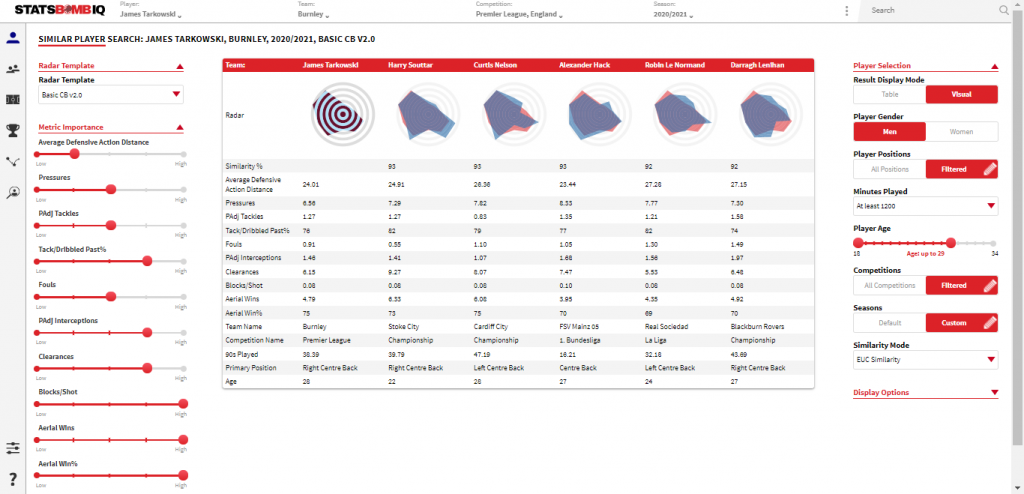
The top five most similar players make for interesting reading. Stoke's Harry Souttar has been praised for his performances in his first full season at Championship level and, at 22 years old, represents a centre back that could be of longer-term interest to a team that defends like Burnley. If Burnley were happy to look abroad, then not far below the top five players returned is Felix Uduokhai of Augsburg in the Bundesliga. Uduokhai not only has a similar profile to Tarkowski, but Augsburg also show up as a team that defends in a somewhat similar style to Burnley when comparing Burnley's defensive style to Big 5 + Championship teams in StatsBomb's Similar Team Search. At 23 years old, he could be another worth further investigation.
The list returned is 99 players long which can be exported for more detailed filtering, scouting and analysis.
3) Use IQ Scout
The second thing we can do to find players and create scouting shortlists is to use IQ Scout. IQ Scout is the recently upgraded scouting and recruitment tool within the StatsBomb IQ platform. We can use IQ Scout to find more players that may not have been flagged in our Similar Player Search, using filters to bring the list of players down to a manageable and relevant number. The first thing to do in IQ Scout is to select the radar template we’ve just created so we can filter our shortlist based on those metrics. Setting a benchmark of:
- >=70% Aerial Win %
- >= 3.0 Aerial Wins per 90 minutes
- <= 28.2 Average Defensive Distance (to find players used to defending in deeper areas)
- >= 0.05 Blocks/Shot
- >= 70% Tack/Dribbled Past %
… returns a shortlist of 12 players that we can be confident are worthy of further investigation and filtering.
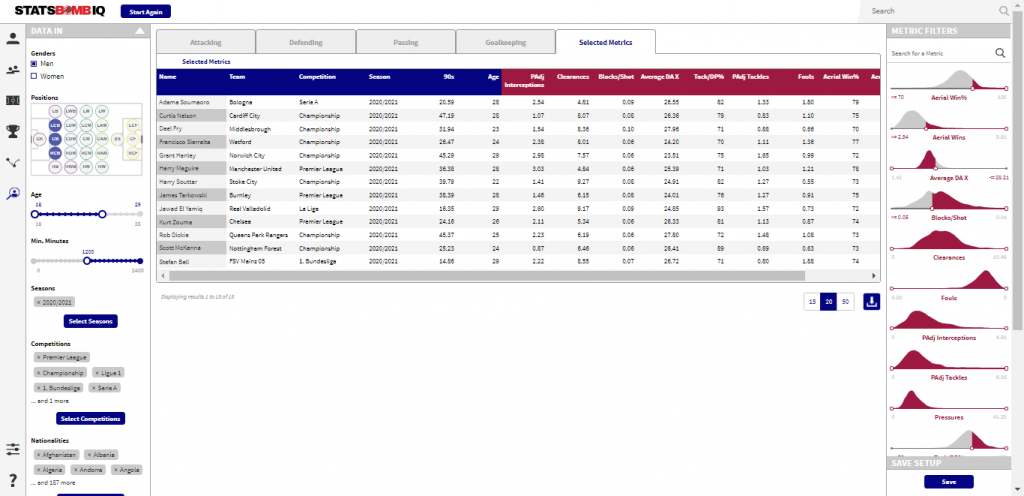
Loosening or altering the filters brings up a different set of names, as does adding more leagues to the search, allowing you to widen or reduce the pool of players before you export the shortlist which includes their performance data across every metric in the StatsBomb IQ Scout database.
Of course, IQ is flexible to each user's demands and scouting criteria, so let's take a quick look at an alternative profile of centre back to demonstrate this.
Magdalena Ericsson has just come off the back of a title-winning and Champions League silver medal winning season with Chelsea. Ericsson's very capable on the ball, playing a crucial role in the early stages of build-up for Chelsea as well as possessing ability to progress the play herself through incisive passing or ball carrying.
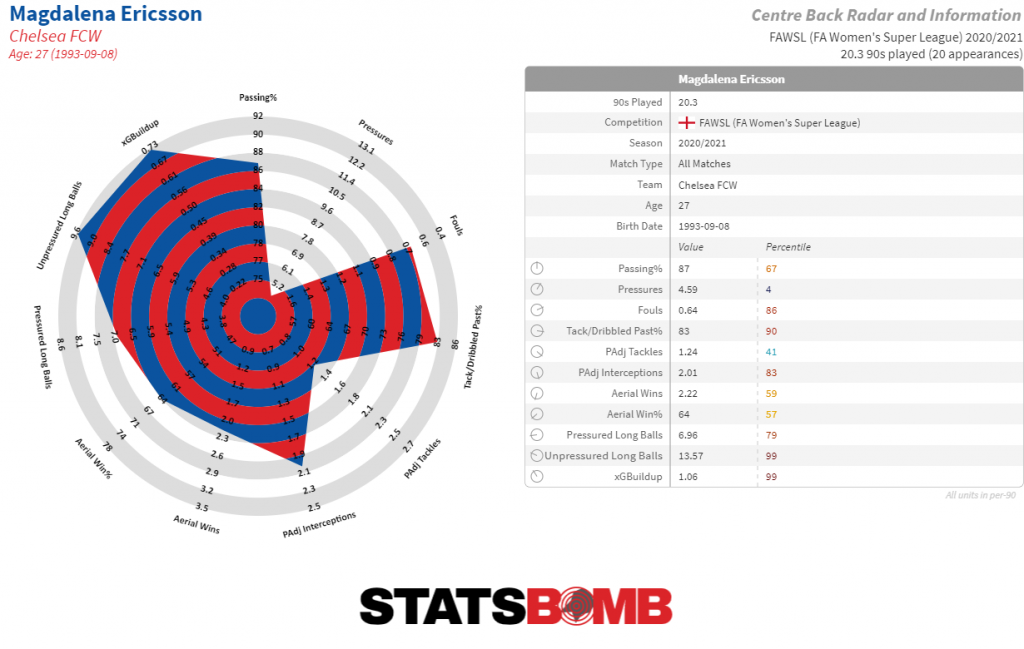
Assuming on-ball ability is the most important attribute we want to search for in this exercise, we can create a new player template that is designed to highlight and emphasise this. We'll remove Fouls, Pressures, Pressured Long Balls, Unpressured Long Balls, pAdj Tackles and pAdj Interceptions. In their place we'll add:
- pAdj Tackles & Interceptions: Number of tackles and interceptions adjusted proportionally to the possession volume of a team
- Open Play Passes: Number of attempted passes in open play
- Being Pressured Change in Pass%: How does passing % change when under pressure? This is calculated as Pressured Pass % minus Pass %
- Deep Progressions: Passes and dribbles/carries into the opposition final third
- Carries: A player controls the ball at their feet while moving or standing still
- Carry %: Percentage of a player's Carries that were successful
- Carry Length: Average Carry length.
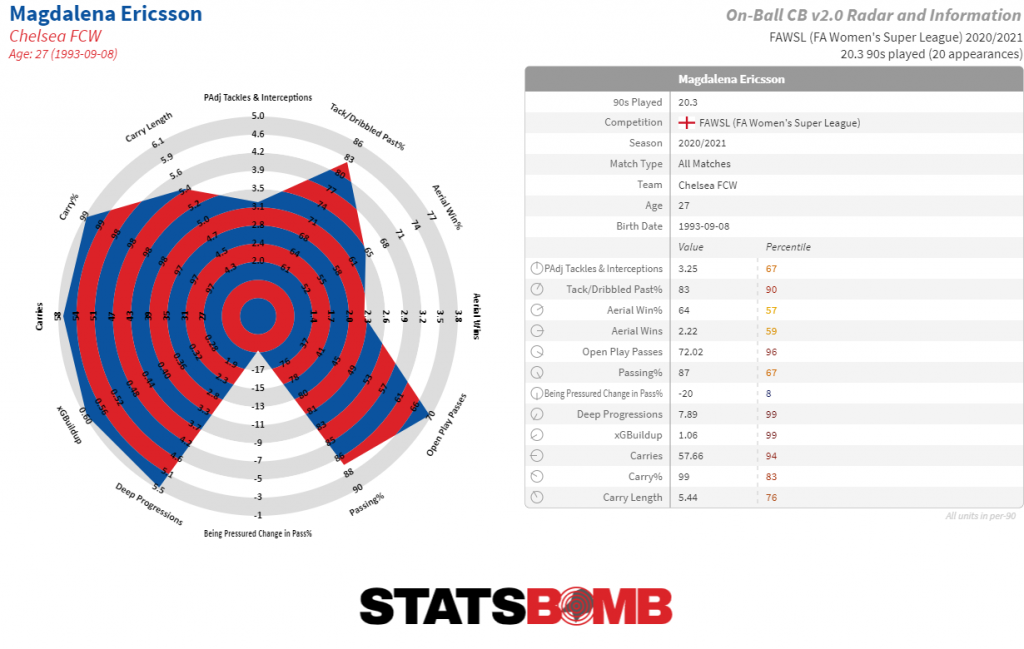
The new radar clearly highlights Ericsson's profile in possession: one that is heavily involved in the build-up (72 Passes In Open Play per 90) and moving the play forwards (7.9 Deep Progressions per 90). Using this template in the Similar Play Search with the following filters:
- Age: U-26
- Minutes Played: min. 900
- Season: 2020/21
- Competition: Big 5 European Leagues
... returns a list of 100 players, with the five most similar players seen below:
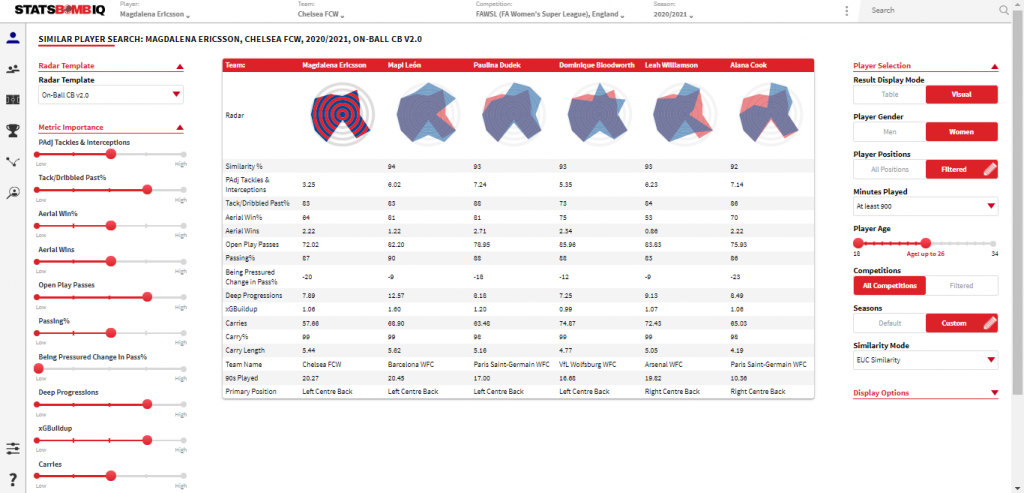
Heading into IQ Scout and applying the same preliminary filters as before with the addition of:
- >= 75% Tackled / Dribbled Past %
- >= 60% Aerial Win %
- >= 45 Open Play Passes per 90 minutes
- >= 2.8 Deep Progressions per 90 minutes
... returns a list of 10 players, ones we can be confident will be a reasonably close fit to the ball-playing centre back profile we're looking for and worthy of further analysis and scouting, with the opportunity to add, remove or adjust additional filters to create a wider or more specific shortlist of players. That’s just a glimpse of how StatsBomb IQ can be used for player recruitment and shortlist creation, prior to the deeper analysis we can perform within IQ once we’ve identified our targets alongside live and video qualitative scouting and background personality and availability checks. Next week we’ll look at another position on the pitch to further demonstrate how StatsBomb IQ can be customised to fit the precise profile of player you're looking for.
If you’re a football club or organisation and would like a full demo of how StatsBomb IQ and Data can help you achieve your objectives, get in touch with us today.
Right now, dozens of clubs around the world will be using StatsBomb IQ to aid their player recruitment planning and shortlisting ahead of the summer transfer window. IQ is designed by analysts, for analysts, with the goal of making data-driven insights easily accessible and digestible. Most importantly, it saves valuable time and resources for the time-poor analyst and is flexible and customisable to each user's specific needs.
Data can be used at all stages of the recruitment process, from the initial shortlisting down to more granular player assessments, to support qualitative live and video scouting and background personality checks. Today we're going to show you some examples of how IQ can be used to bring data into the recruitment process in the early stages when creating a scouting shortlist. Let’s look at a couple of Premier League forwards with different player profiles and role requirements. Given the rumours swirling around White Hart Lane at the minute, it seems likely that Tottenham might currently be in the process of drawing up contingency plans should Harry Kane depart for pastures new.

It goes without saying that Kane is vitally important to Spurs, being one of the best forwards in the world. Kane was the only player in the Premier League to hit both 0.20 xG per 90 *and* 0.20 xG assisted per 90 in the 2020/21 season. We want to create a shortlist of players that could be worth further investigation as potential replacements for the England striker. Spurs might be thinking about doing this in a number of different ways, replacing him with multiple players or adapting their style of play to bring the best out of other players, for example, but for the purposes of this exercise, let’s assume they’re looking for a direct replacement.
1) Create And Edit A Radar Template
The first thing we want to do in IQ is create a radar template that best reflects Kane’s output as a forward. We know that Kane takes on what you might call a “complete” role up front for Tottenham; dropping deep to be involved in build-up, providing creative link-play in the final third, whilst also being the team’s main goal threat. To do this, we select the “Edit Radar Template” function in IQ, choosing the relevant positions we want the data to filter for.
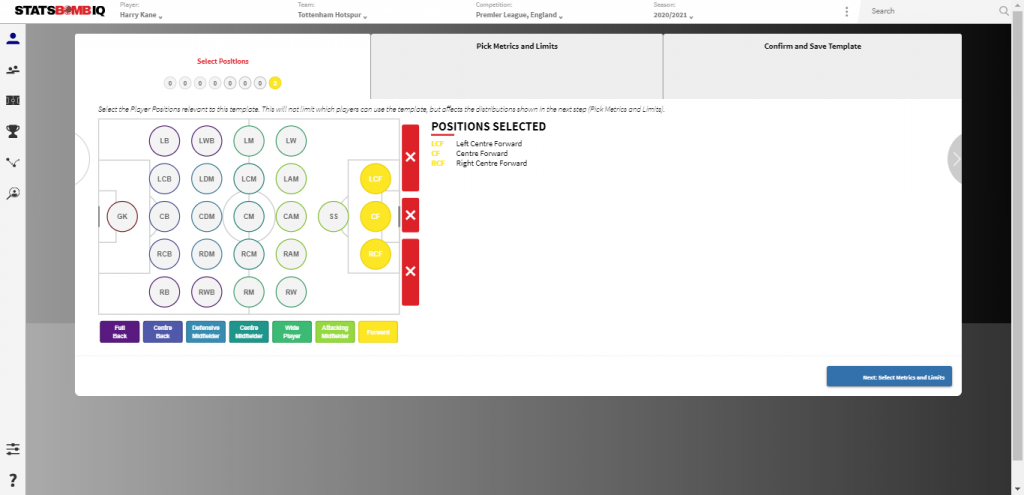
Next, we select the relevant metrics with which we want to judge Kane’s performances against and that will be used in the search for his potential replacement.
As an indicator of his ball progression and build-up play, we'll add Deep Progressions (the number of times the player moves the ball into the final third through a pass or dribble) to the original Striker radar template. As measures of his final third link play, we'll add Open Play Passes Into The Box as well as Open Play Key Passes. His goal threat will be measured by his Expected Goals and Shots totals.
Once our metrics are selected, we choose the radar percentile boundaries based on the distribution of data in each metric by the relevant positions we've chosen, in this case strikers.
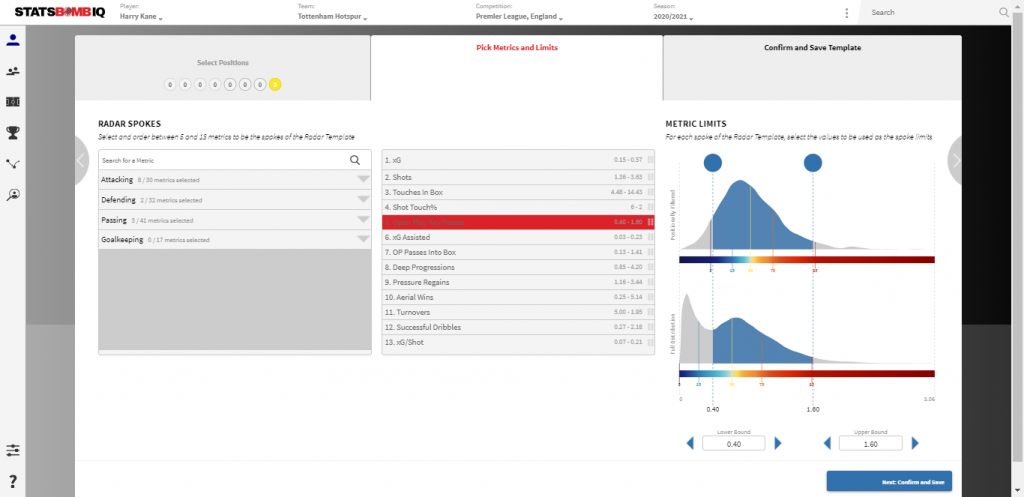
When we’re happy with the metrics we’ve selected and layout of our radar, we can save the template for future use, and view the player on our newly created radar.

The new radar provides an accurate overview of Kane’s performances in the 2020/21 season against the criteria we' looking to judge:
- Goal Threat: 89th percentile for Expected Goals, 95th percentile for Shots
- Involvement In Build-Up: 95th percentile for Deep Progressions
- Final 3rd Link Play: 89th percentile for Open Play Passes Into The Box, 83rd percentile for Open Play Key Passes, 91st percentile for xG Assisted
We now have a radar that reflects Kane’s outputs. But how can we use this to aid our search for potential replacements?
2) Use StatsBomb IQ’s Similar Player Search Tool
The first thing to do in Similar Player Search is to set the filters for potential replacements. StatsBomb cover 80+ competitions worldwide, but Spurs will obviously be looking towards the top of the market for a possible new striker. For the purposes of this exercise, we’re going to look at players from:
- the 2020/21 season
- with a minimum of 1500 minutes played
- in a Big 5 league + Austrian Bundesliga, Portuguese Liga NOS, and English Championship
- and no older than 24 years old
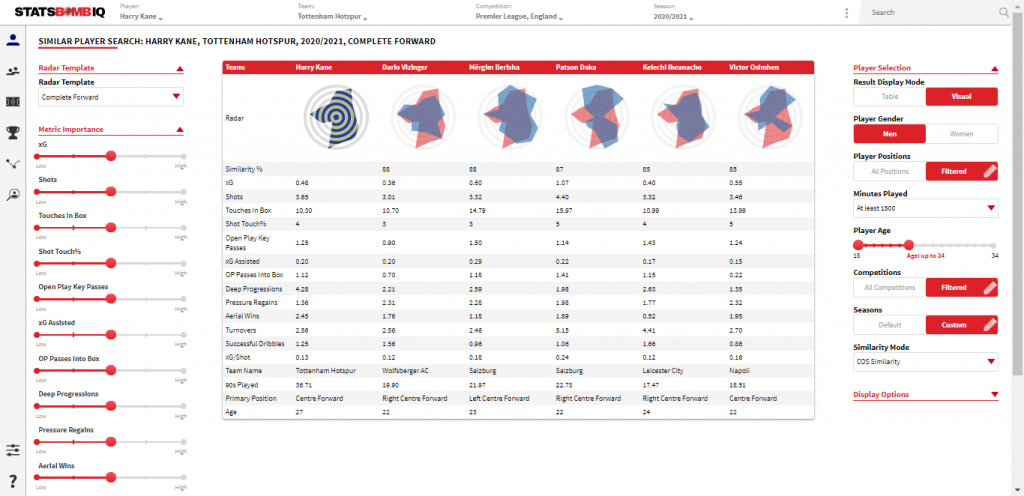
The top 5 most similar players make for interesting reading, with perhaps Salzburg’s Patson Daka the most eye-catching given the rumours that he’s likely to follow Erling Haaland as the next forward off the Salzburg production line. Slightly different in style to Kane, Daka is more involved on the end of chances - as reflected by his Shot Touch % of 5% (the percentage of his touches that are shots) - and less involved in the build-up play, reflected by his 2.0 deep progressions per 90 minutes (compared to Kane's 4.3). However, the Zambian plays in a transition-heavy team (worth noting if Spurs are looking to stick with that style) and has shown consistent quality on the European stage. He might be worth consideration.
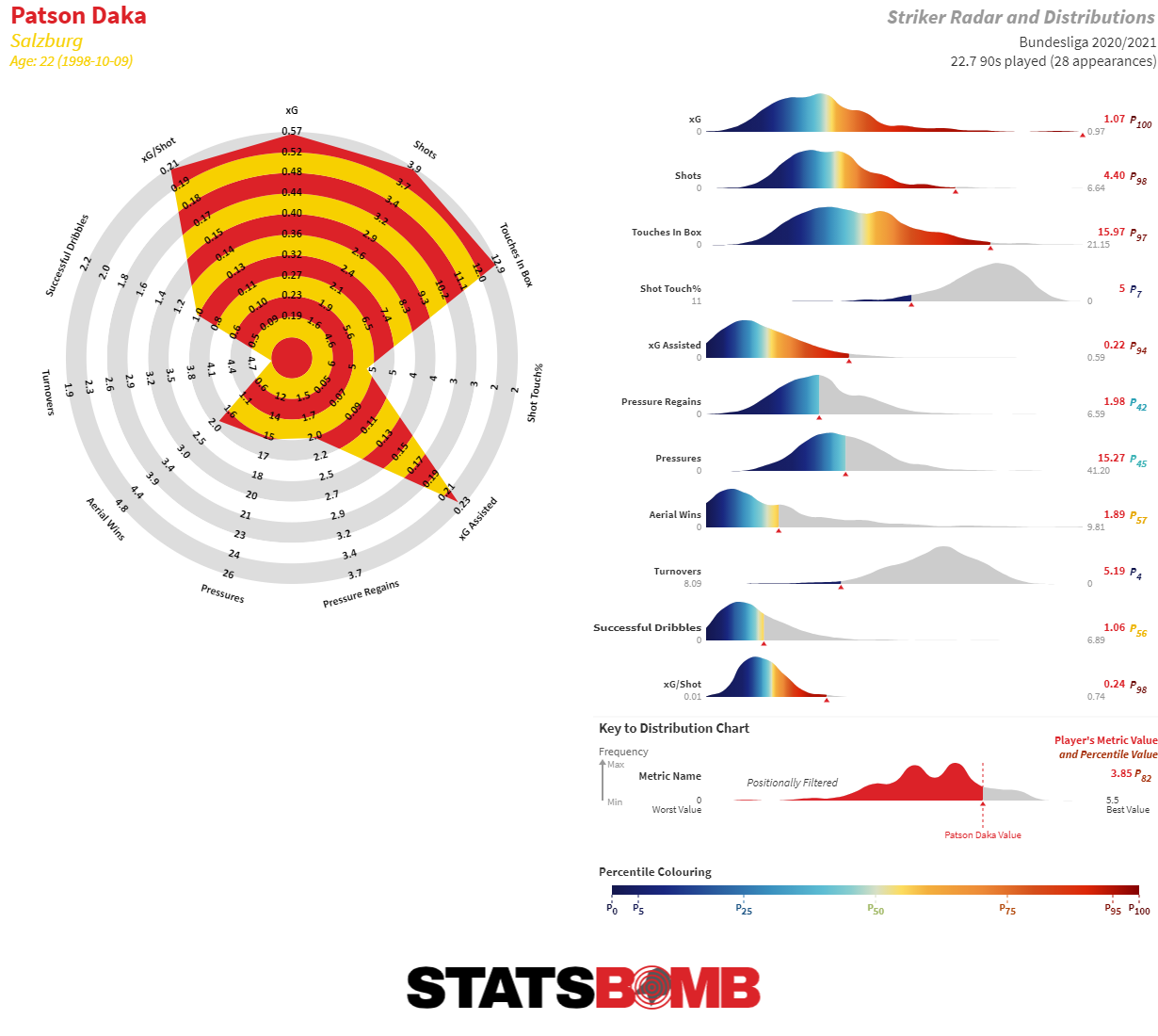
If we were to place more weight on the build-up and link-play metrics, names such as Amine Gouiri, Rafael Leão and João Félix appear closer to the top of the search. Some more realistic than others, but again perhaps worth further scouting and analysis from the Spurs recruitment team. On the criteria selected, 64 names were produced. We can export the shortlist with each of their similarity scores and outputs in the selected metrics attached to a .csv file for a more detailed look, whittling the names down based on their performances and potential availability.
There's still more we can do in IQ to increase our initial shortlist size.
3) Use IQ Scout
IQ Scout is the recently upgraded scouting and recruitment tool within the StatsBomb IQ platform. We can use IQ Scout to find more players that may not have been flagged in our Similar Player Search, using filters to bring the list of players down to a manageable and relevant number. The first thing to do in IQ Scout is to select the radar template we’ve just created so we can filter our shortlist based on those metrics. Setting a benchmark of:
- 2.0 Shots per 90
- 0.30 xG per 90
- 0.08 xG Assisted per 90
- 1.0 Open Play Key Passes per 90
… returns a shortlist of 12 players that we can be confident are worthy of further investigation.
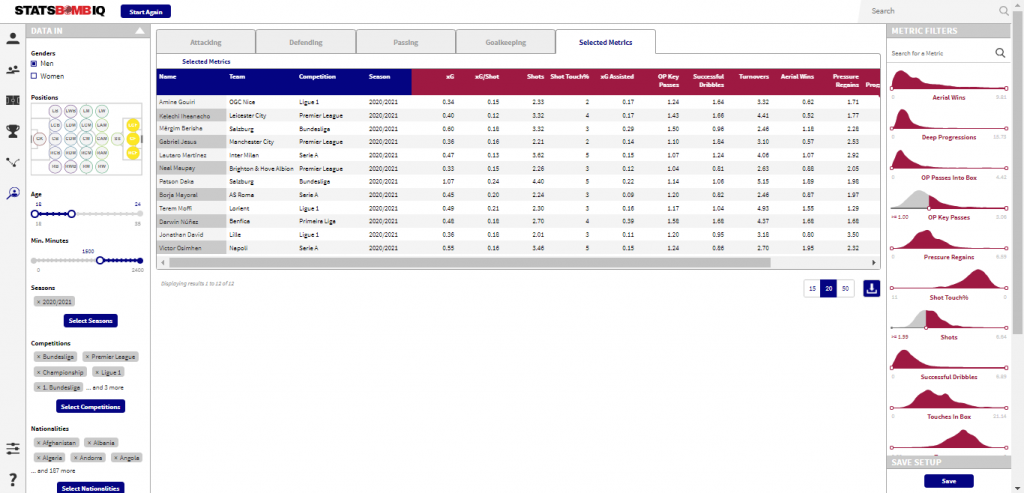
Altering the filters slightly towards a more creative type of forward returns a list of 15 names, mostly new ones. We can change or loosen the filters as much as we want based on which we want to weight more heavily. Do we want a well-rounded forward who performs to at least an average level across a range of metrics? Or do we want one who is elite in a couple of highly important ones?
Once again, we can export the shortlists for further analysis and scouting, with the file containing the player's performances across every StatsBomb metric.
To demonstrate the flexibility of StatsBomb IQ to each user's needs, we can repeat the process for a forward with a slightly different profile to Harry Kane. Leeds’ Patrick Bamford is another prolific English goalscorer in the Premier League, but his role in the Leeds team is different to that of Kane’s. Bamford is relied upon to consistently find space in the box, be a finisher of the team’s chances rather than create them, and provide a high work rate out of possession in Marcelo Bielsa’s system.
We can create a radar template that best reflects Bamford’s outputs in the Leeds team and the type of player we’re searching for. The key metrics we'll be judging Bamford and his potential replacements against will be:
Find Space In The Box:
- Touches In Box
Finisher Of Chances:
- xG
- Shots
- Shot Touch %
Defensive Work Rate:
- Pressures
- Pressure Regains
- Counterpressures
- Possession-Adjusted Tackles & Interceptions
Again we can set the radar percentile boundaries based on the data filtered by each position, so we can see the 5th and 95th percentiles for counterpressures by strikers, for example, and then save our template for future use.
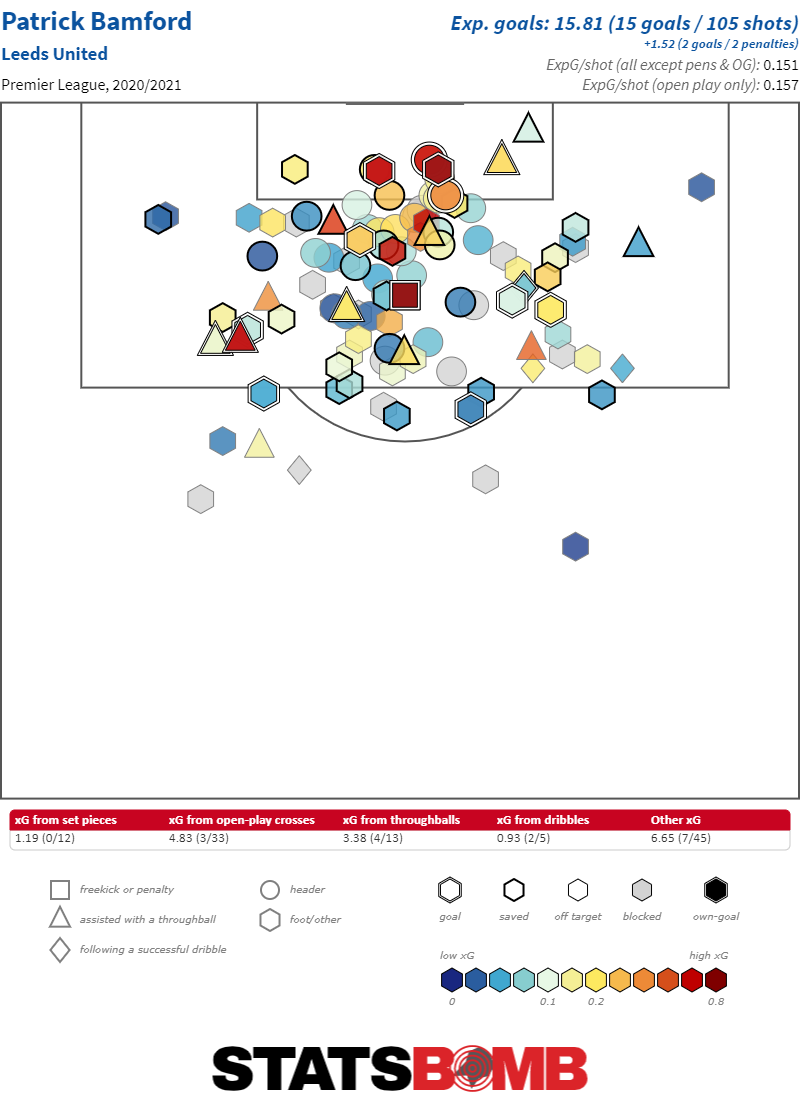
We can see that Bamford performs well in the metrics we’ve highlighted as being important to a player of his role and requirements: in the 96th percentile for Touches In The Box, the 88th percentile for Pressure Regains, and with a Shot Touch % of 5%. The Similar Player Search (using the same criteria as used for Kane but with the Eredivisie and Belgian Pro League added) returns some high-profile (and likely expensive) names. Danilo of FC Twente (on loan from Ajax) could be the most attainable of the top five, but not far further down the list you find Youssef En-Nesyri of Sevilla and Adam Armstrong of Blackburn, for example.

We can export the shortlist and then head into IQ Scout to widen our pool of players. Selecting the same competition, age, and minutes played filters and applying further filters on our metrics with a minimum of:
- 2.0 Pressure Regains per 90
- 13.5 Pressures per 90
- Shot Touch % of 3%
- 10 Touches In Box per 90
- 0.2 xG per 90
…returns a list of 16 names that we can be confident will be close to the style of player we’re searching for, again allowing the option to loosen or change the filters if we want to widen or reduce our shortlist, and also allowing us to export the list of players for further analysis and scouting, with the players' performance in each StatsBomb metric listed within the exported file.
That’s just a glimpse of how StatsBomb IQ can be used for player recruitment and shortlist creation, prior to the deeper analysis we can perform within IQ once we’ve identified our targets, alongside live and video qualitative scouting and background personality and availability checks. Later in the week we’ll look at different positions to further demonstrate how StatsBomb IQ can be customised to fit the precise profile of player you're looking for.
If you’re a football club or organisation and would like a full demo of how StatsBomb IQ and Data can help you achieve your objectives, get in touch with us today.
One of Brazil’s biggest football clubs, Clube Atlético Mineiro, have signed a partnership with StatsBomb, empowering their analytics department, led by Rodrigo Picchioni and Pedro Picchioni, with the most detailed football data available. This is the first time StatsBomb, one of the fastest growing sports data companies in the world has expanded its marketing-leading services into Brazil.
The partnership will see Clube Atlético Mineiro receive StatsBomb’s cutting edge data covering over 3,400 events per match, across dozens of leagues and competitions across the globe. Alongside the data, the club will have full access to StatsBomb IQ, the most advanced and customisable football analytics platform available.
Clube Atlético Mineiro join around 100 professional clubs and federations around the world in enhancing their ability to scout and recruit players, analyse upcoming opponents and evaluate team performance.
Plínio Signorini, CEO, Clube Atletico Mineiro said:
"Clube Atlético Mineiro has chosen the best data provider in the world to start its analytics department. One of the strategic principles of our club is, after all, to be a reference in Latin America both on and off the pitch. In order to achieve that, it is crucial to seek innovative and efficient partners such as StatsBomb."
StatsBomb’s Head of Tactical Innovation and Business Development, Pablo Peña Rodríguez said:
"It is great to be working with one of the biggest clubs in Brazil. Throughout our conversations, the analytics team at Atletico Mineiro have shown fantastic ambition and understanding of the role our data and IQ platform can play in their preparations. We’re delighted to be expanding into Brazil and are looking forward to more opportunities in the region."
Norwich City are back, promoted as Champions of the Championship for the second time in three seasons to return to the Premier League for the 2021/22 season. Talk of ‘trusting the process’ has been heard numerous times in recent weeks – The Canaries stuck with the same formula that had already earned them promotion in 2018/19; same manager, same principles, same players (mostly).
The dual pursuit of success and self-sufficiency instilled by Sporting Director Stuart Webber came at a sporting cost last season in their Premier League relegation, but having sent Daniel Farke “to war without a gun” in 2019/20 – the highest figure Norwich spent in the summer of 2019 was £750,000 - Farke certainly had the benefit of a full range of weapons in 2020/21. The squad had been refreshed with depth and quality but, more importantly, Norwich retained their best performers from the previous two seasons to lead the charge back to the top flight.
Of the eleven most-used players this season, four were in the eleven most-used in 18/19 (Emiliano Buendía, Tim Krul, Teemu Pukki, Max Aarons) and only three were summer signings: Oli Skipp, Ben Gibson and Jakob Lungi Sørensen. Grant Hanley, Todd Cantwell, Kenny McLean and Mario Vrančić were all less-prominent parts of the 18/19 group but were this time around well ingrained in Farke’s playing style and much more prominent members of the squad.
There’s little doubt that Norwich have been better this time than when they won the league two years ago. The 2020/21 iteration felt more complete as a side, almost entirely down to performing much better defensively than in 2018/19. They scored 18 fewer goals in this campaign, but they conceded 21 fewer across the 46 games as well, nearly half-a-goal-a-game drop-off on their last Championship season.
The improvement at the back can be put down to a few different factors, most of them more refined performances from individuals in executing the gameplan as the underlying numbers remained similar: in 2018/19 Norwich conceded 53 (non-penalty) goals from 47.2 expected goals, in 2020/21 it was 33 conceded from 45.7 expected goals.
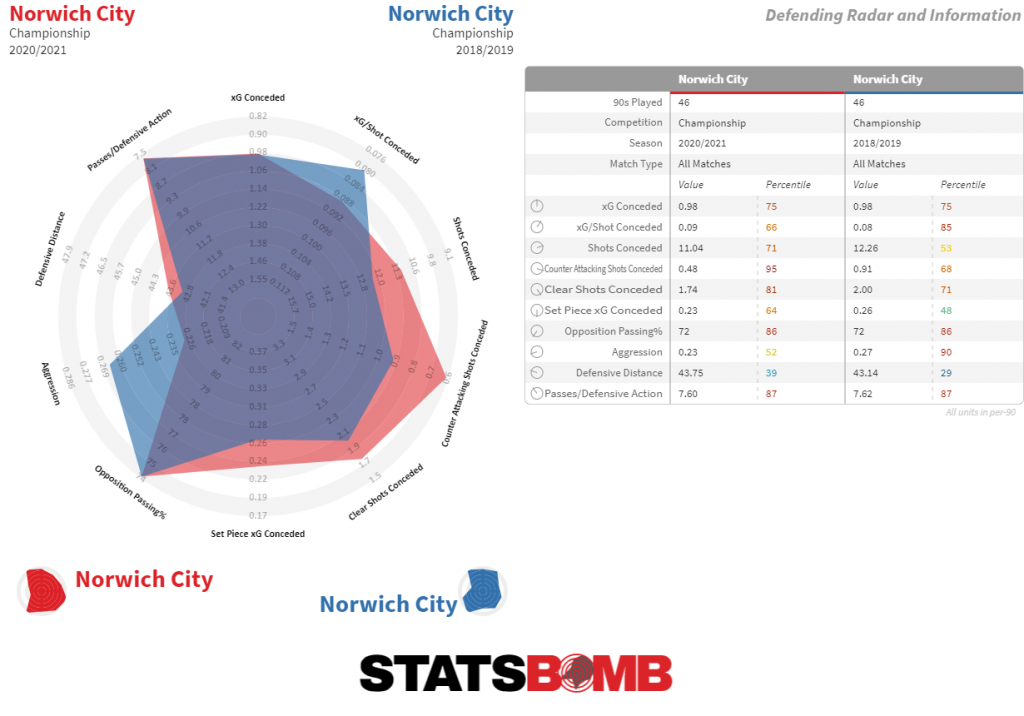
But there was more balance to the side now. Kenny McLean and Oli Skipp anchored the midfield and kept the middle of the park on lock to allow the attacking talents to dovetail in advanced areas of the pitch without fear of being hit in transition. Skipp had a particularly stellar season on loan from Spurs, receiving immense credit for his positional sense and tidiness in the midfield and often covering for Max Aarons’ raids down the right wing by preventing the opposition from transitioning down that flank if possession was lost.
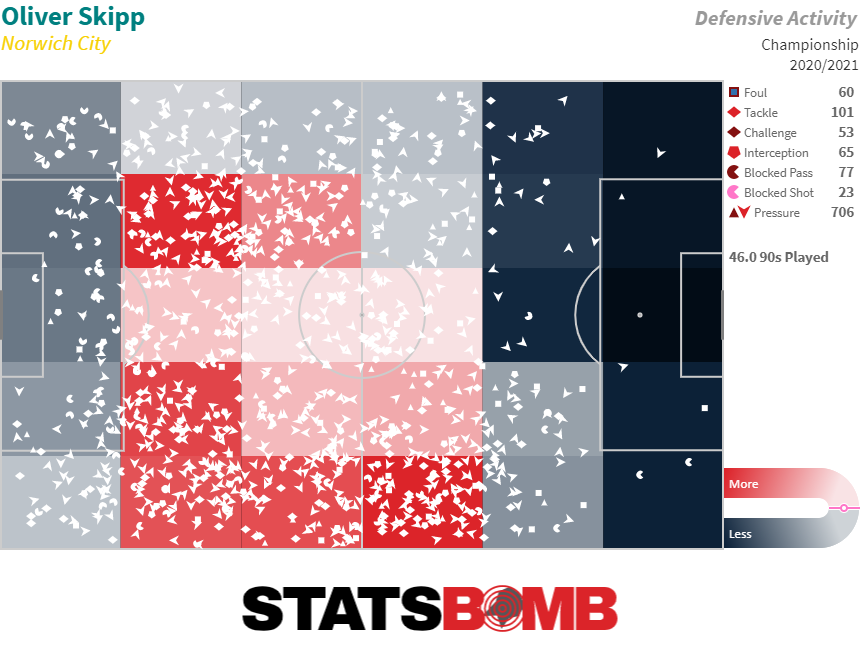
If the ball did reach dangerous areas, Grant Hanley and Ben Gibson were almost always there to clean up – Hanley made the most interceptions and the most clearances (both adjusted for possession) of all centre backs in the Championship - and Tim Krul also had a much better season in goal too. After conceding 52 goals from 49 post-shot expected goals in 2018/19, which takes into account the placement of the shot to judge the probability of the goalkeeper making a save, he fared far better in 2020/21 to save Norwich roughly seven goals, conceding 22 goals from 29.2 post-shot expected goals. His Shot Stopping % of 7% - the measure of goals saved above average, as a percentage of shots faced by the goalkeeper – ranked the highest of all Championship goalkeepers this season.
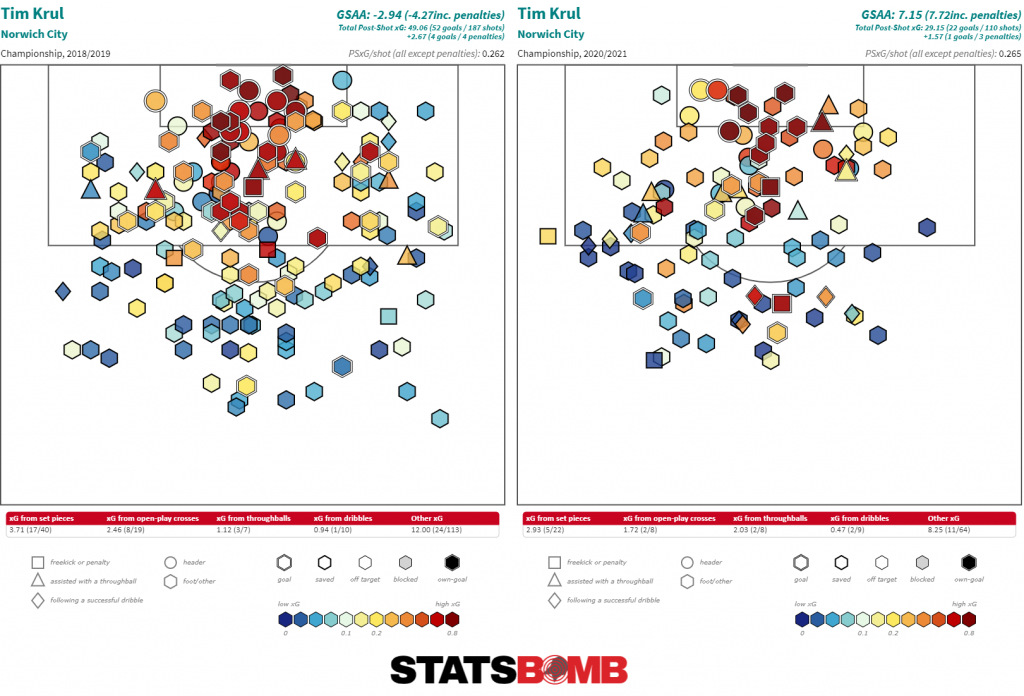
Norwich finished the season with the second-best defensive record and the second-best attacking record, combining for the best goal difference overall. Their attacking game and approach in possession drew the most attention and praise, in-part because of the ease on the eye and in-part because of the elite talent, especially so at Championship level, they had executing it.
The Canaries had more of the ball than any other side in the second tier this season but also moved it into the areas that matter more than anyone else: entering the final third more than any other team, completing the most passes within 20m of goal (Deep Completions), and completing the most passes within the opposition penalty area.

Their short passing and combination play resulted in some wonderful football being played at times, Cantwell and Buendía in particular regularly producing technical quality way above Championship level when tucking into central areas from the left and right flank respectively.
That technique and invention compounded with the intelligent movement of Teemu Pukki resulted in a regular supply line of through balls splitting the opponents' defence. Rarely did a game go by without Norwich getting in behind the opposition, completing 105 through balls for an average of 2.3 per game. For context, the teams with the third and fourth-most through balls in the Championship, Brentford and Bournemouth, completed 108 defence-splitting passes combined.
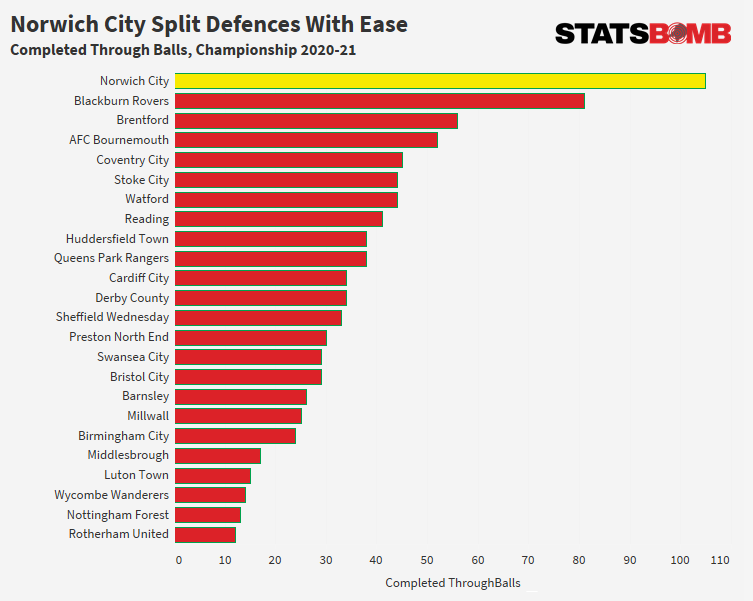
Of the players to complete the most through balls in the league, three were from Norwich, with Buendía and Vrančić making the top two and Cantwell rounding out the top five just below Harvey Elliott and Callum O’Hare.
Buendía's starting position on the right flank is on teamsheet only. In reality, it's Aarons who'll keep the width when Norwich are in the attacking phase with Buendía tucking into central areas - where he can cause more damage with a greater sight of goal. It's clearly observable when looking at his through balls, only two of which were played from an area wide of the penalty area, the rest coming from a more narrow starting position.
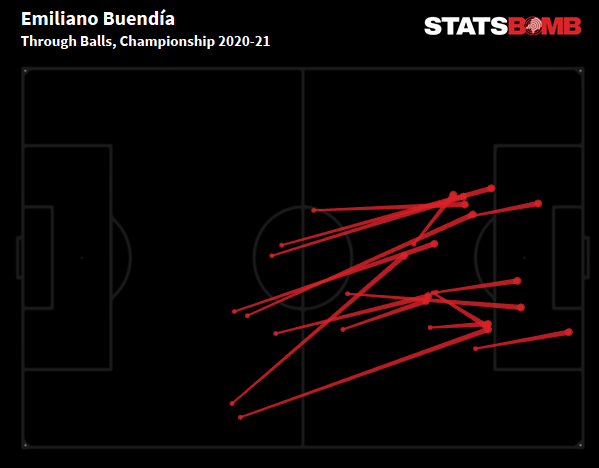
It's also notable how many of those threaded passes were played from deeper areas. These were not typically passes that broke the opposition's deep block, often they were quick and laser-like passes in transition where Buendía and particularly Pukki’s skillsets thrived. After winning the ball in their defensive third, if Norwich could get the ball to Buendía lurking intently in the space between the opposition midfield and defence then it would spell trouble for their opponents, with Pukki playing on the shoulder and poised to make a perfectly timed run in behind.
Buendía’s influence on this Norwich team and the Championship itself was so great that there have been discussions in recent weeks as to whether this has been the greatest individual season ever witnessed in England’s second tier. The quality shown in the final third has been closer to that seen in the Champions League than the Championship, with the Argentine finishing the season on 14 non-penalty goals and 14 assists, backed up by accruing the most xG assisted in the league (13.2) from the most key passes (120).
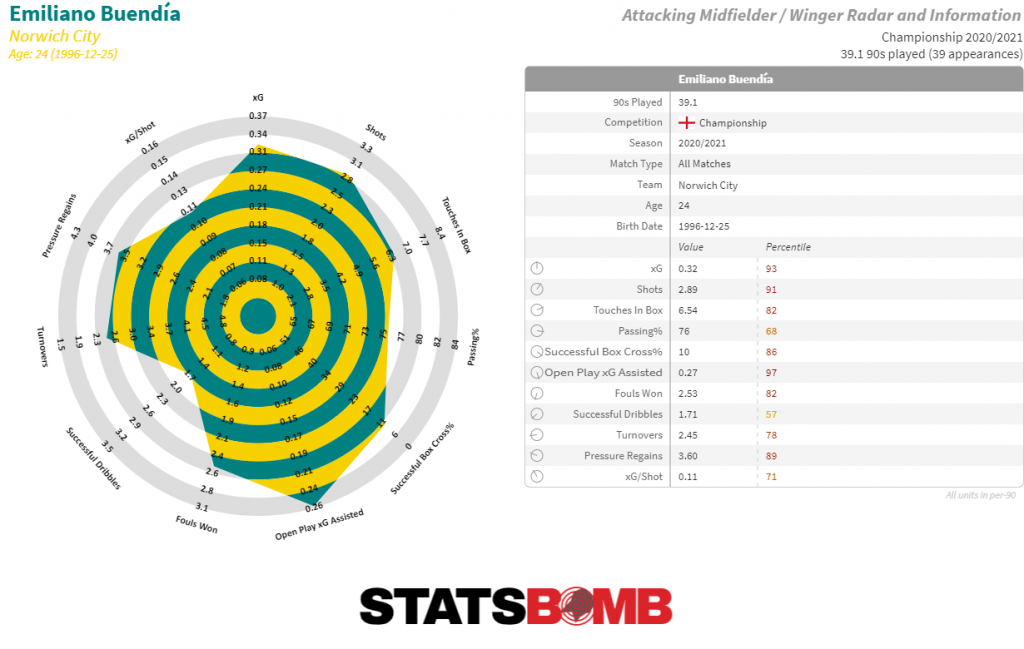
His influence in the final third bears out in how often Norwich were able to get him on the ball in those areas, with Buendía completing 760 final third passes across the season (19.4 per 90 minutes) and 82 open-play passes into the penalty area (2.1 per 90 minutes). Both were league best numbers, as was the fact that just 8% of his passes in the final third went backwards, a league-best figure amongst Championship attacking midfielders and wingers and a number that illustrates his ability to keep the attack moving towards goal.
That he’s one of the league’s most active defenders is just the cherry on top. The truth is, Buendía very likely would’ve won the Player Of The Season award for his attacking play alone, but his contribution on the defensive end only adds to the mesmeric nature of his performances.
His determination and work rate has landed him disciplinary trouble at times, picking up 2nd yellows for a red card on two occasions this season, but his discipline out-of-possession has been a key part of Norwich’s success, providing support to Oli Skipp and Max Aarons in defending the right flank. Adjusted for possession, given Norwich had more of the ball than any other side this season, Buendía recorded the most pressures of any player in the Championship in 2020/21.
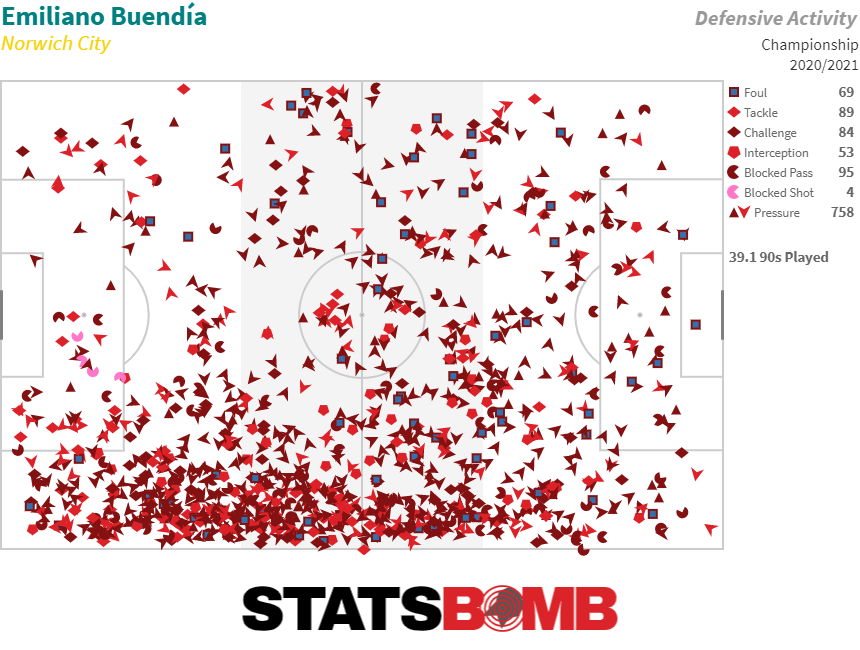
Of course, none of this would’ve been possible without another exemplary season leading the line from Teemu Pukki, playing the role of 20+ goal striker yet again. Pukki’s role in the team remained the same as it always has – lead the press and provide a nuisance when the team's out of possession, make devilish runs and finish lethally when the team's in possession. Following on from earlier, 1-in-5 of Pukki’s shots came after a through ball.
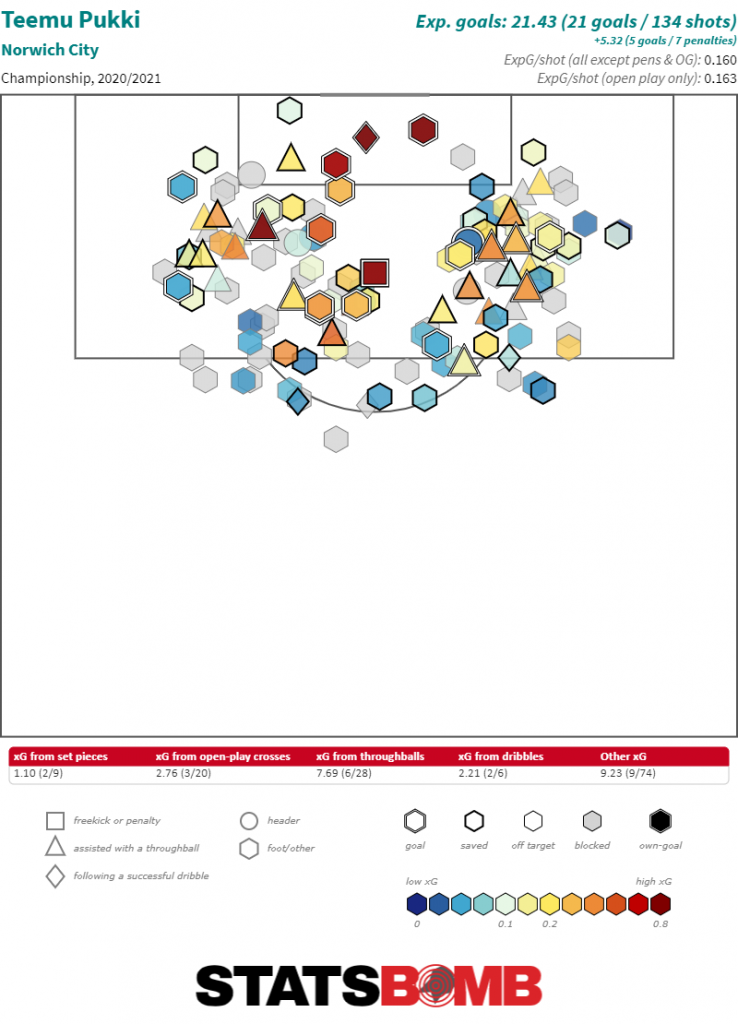
One of the most archetypal forwards in the league, both in role and in attributes, Pukki was behind only Adam Armstrong for the percentage of total touches that are a shot, with 5% of his touches being a shot on goal. The Fin eventually finished third in the goalscoring charts, both with & without penalties, but his expected numbers were ahead of Ivan Toney and Armstrong – Pukki finished with 27.3 expected goals + expected goals assisted, the most in the Championship this season. Deserved champions, the common consensus is that Norwich are much better prepared than last time to attempt Premier League survival next season. A period of uncertainty around whether they can keep their best stars in yet another transfer window will surely ensue, but one thing we can be certain of – the process will remain the same.
Perhaps we’ve misunderstood all along. For all the years that French football has had the "farmers league" tag directed at it, supposedly for the lack of quality in the league, is it possible that the accusers have the whole time been referring to the fertile soil that churns out huge quantities of players talented enough to play on the continent each season?
It’s true of Ligue 1, and it’s certainly true of Ligue 2. Of all the second tiers of the ‘Big 5’ European leagues, Ligue 2 stands out as one of the most prolific and consistent breeding grounds for players that go on to play at the top of the game. In the last couple of years alone we’ve seen Alexis Claude-Maurice (OGC Nice), Pape Gueye (Marseille), Silas Wamangituka (VfB Stuttgart), and Maxence Lacroix (VfL Wolfsburg) graduate from France’s second division to play towards the top end of some of the best leagues in the world. Tino Kadewere, another example, made the summer move from Le Havre to Lyon with great success, completing a seamless transition from the top half of Ligue 2 to a title challenge in Ligue 1.
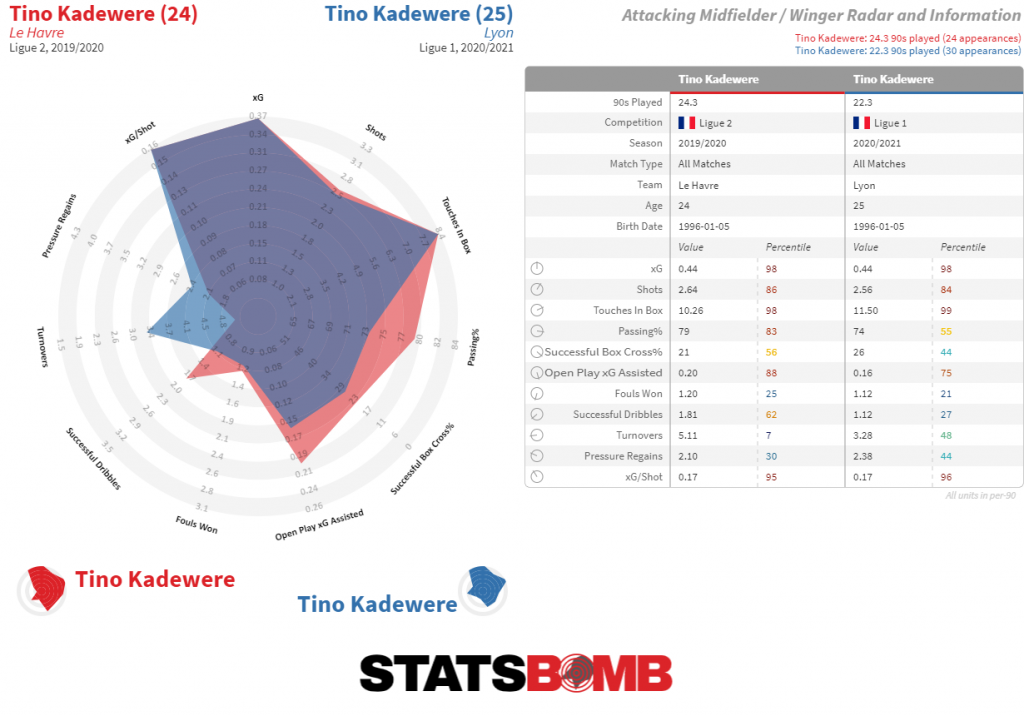
And so, the next batch. Already confirmed as the next graduate out of Ligue 2 is Kouadio Koné. After a breakthrough season in 2019/20, the 19 year old Toulouse midfielder has dialled it up in 2020/21, enough to convince Borussia Mönchengladbach to part with a rumoured €9million in January to secure his services for the 2021/22 season, leaving him at Toulouse to finish the Ligue 2 campaign. Koné profiles like a classic box-to-box, do-it-all midfielder, contributing plenty on the defensive end, impressive in transition both in carrying the ball and playing forward passes to his attackers, and not shy of testing the goalkeeper from range.
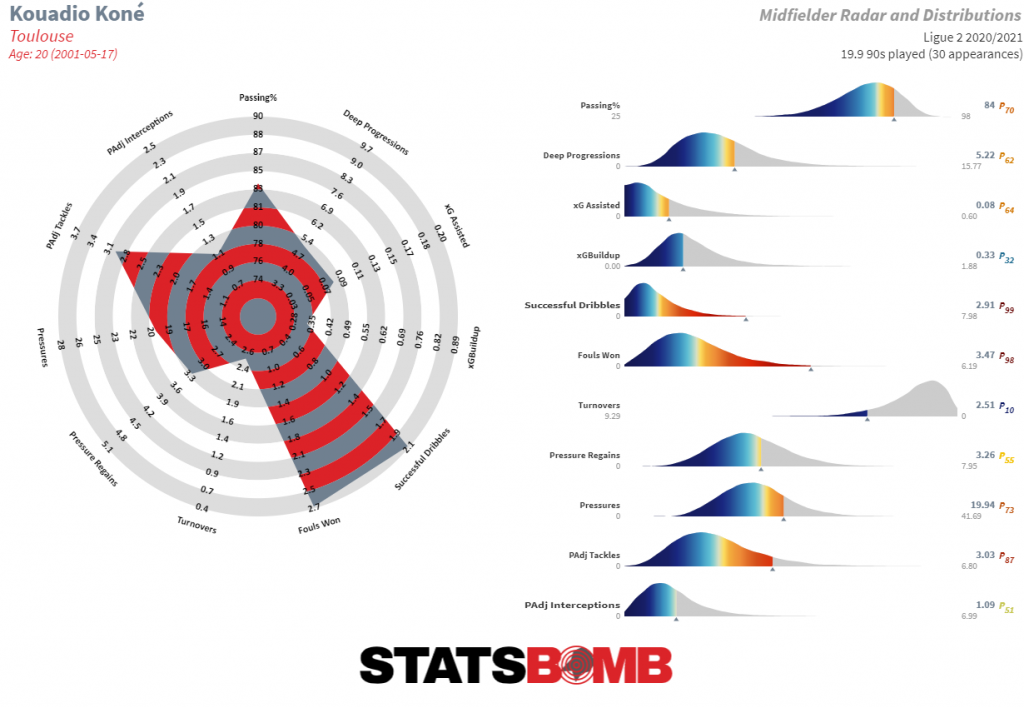
Very active off the ball, Koné has shown a tenacious streak both in his propensity for closing down the player in possession, or making a tackle to win the ball back, or generally firefighting across the midfield.
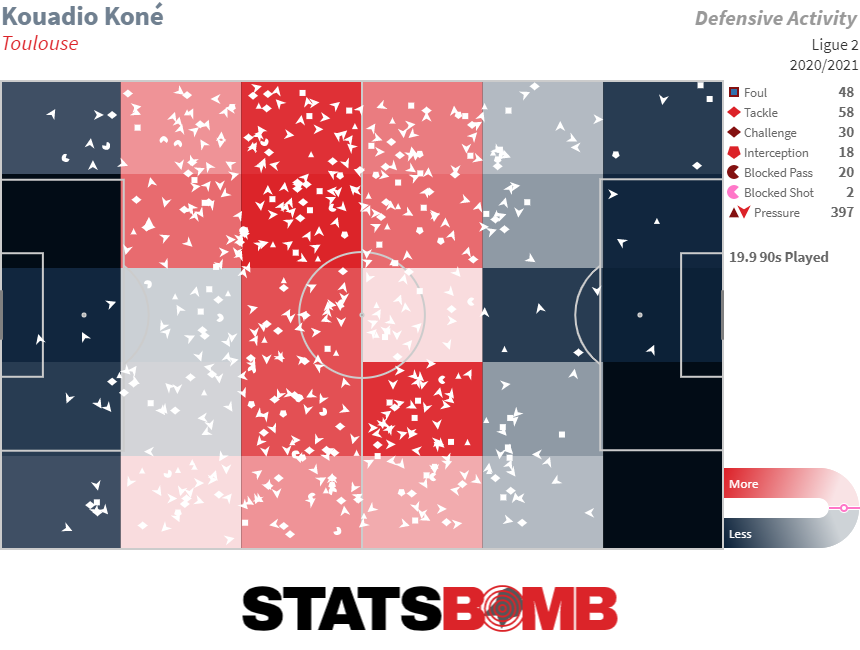
Koné picks up far fewer Interceptions relatively speaking, with 0.9 interceptions per 90 ranking 50th of 57 Ligue 2 central midfielders to play at least 1200 minutes this season, which is perhaps unsurprising for a player so eager to engage the opposition rather than hold his position. On the flip side, that tenacity has seen him rack up the fifth-most tackles per 90 minutes amongst Ligue 2 central midfielders, as well as the sixth-most pressures.
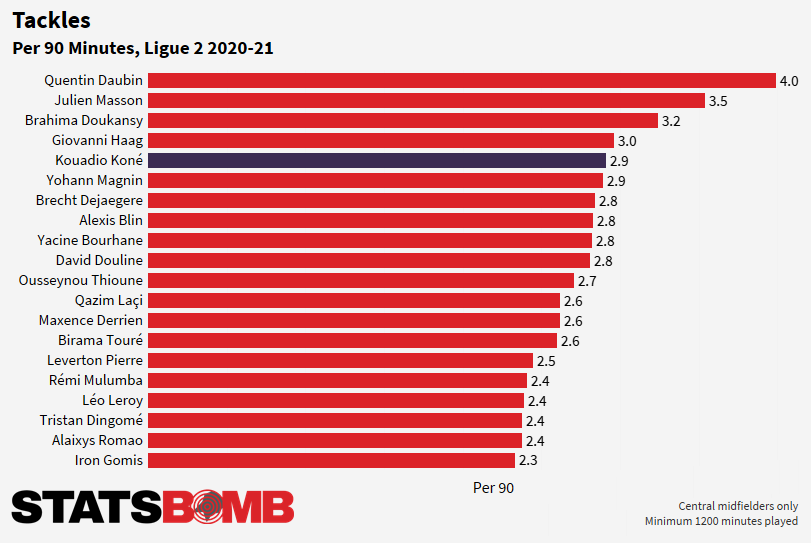
That’s to ignore the fun stuff though.
Clearly the French U19 international’s standout attribute is his ability to get the ball -> carry the ball. That penchant for engaging the opponent isn’t limited to his defensive work, he’s keen to take them on when on the ball as well: Koné attempts (4.0) and completes (2.9) more dribbles than his Ligue 2 centre midfield contemporaries, and completes them at a rate (73%) only Leverton Pierre (76%) of Dunkerque can beat for players who attempt at least 2.0 dribbles per 90. His ball-carrying ability is also reflected in his Carry numbers, the volume of which is around league average, but his average carry length of 6 metres is second only to Rominigue Kouamé of Troyes with 6.2 metres, displaying his ability to carry the ball over longer distances from the centre of the park.
It’s the areas of the pitch that Koné is dribbling in that make him an interesting player. Clearly a useful asset to have when transitioning from defence to attack, he utilises this skill both in the defensive half and in the attacking third and drifting left or right, with 1.8 completed dribbles per 90 in the middle third and 1.0 in the attacking third. Not just utilising this asset in moving Toulouse up the pitch, but also as a means to create space in the attacking phase as well.
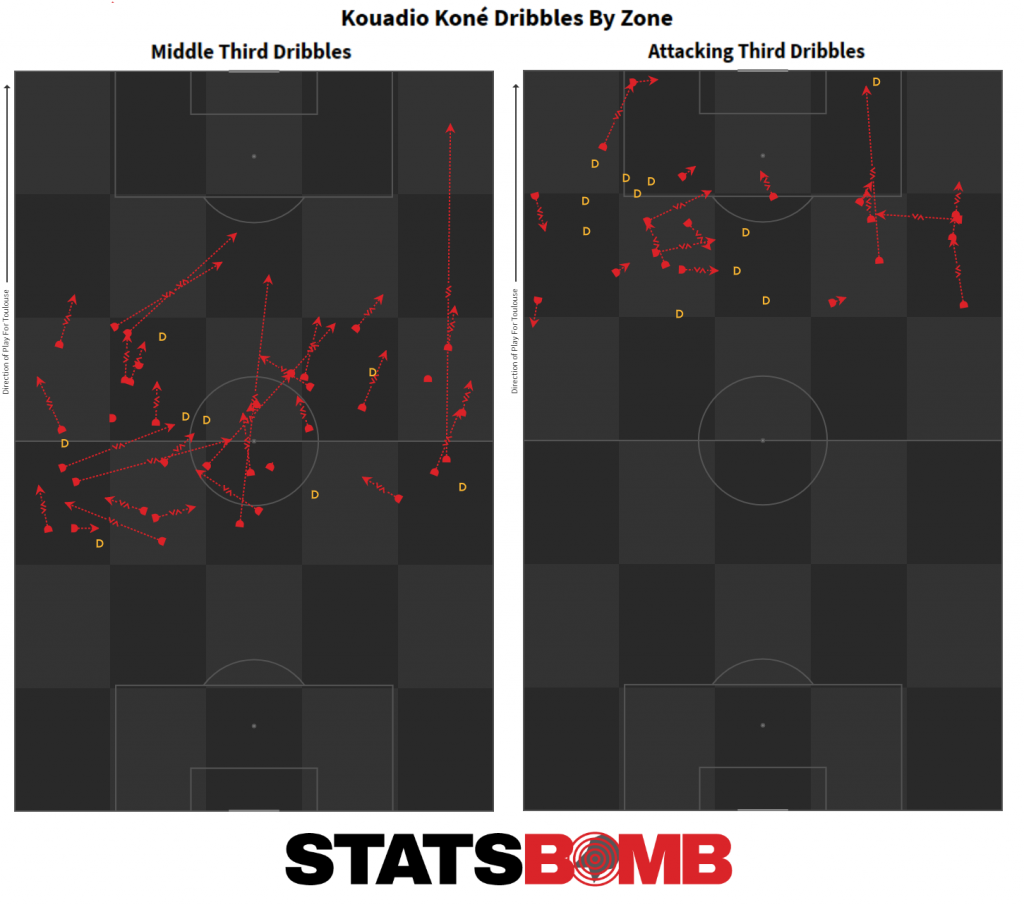
When it comes to progressing the play through passing, Koné has also shown ability here, just behind teammate Branco van den Boomen for moving the ball to the final third (5.2 Deep Progressions per 90) , a figure that puts him 10th overall in Ligue 2 central midfielders. Indeed, he profiles similarly to van den Boomen across most passing metrics, showing similar importance and sharing responsibility in possession with his more senior midfield partner. It’s easy to see why he’s trusted with the ball when he’s able to protect it so well, completing 81% of his passes under pressure.
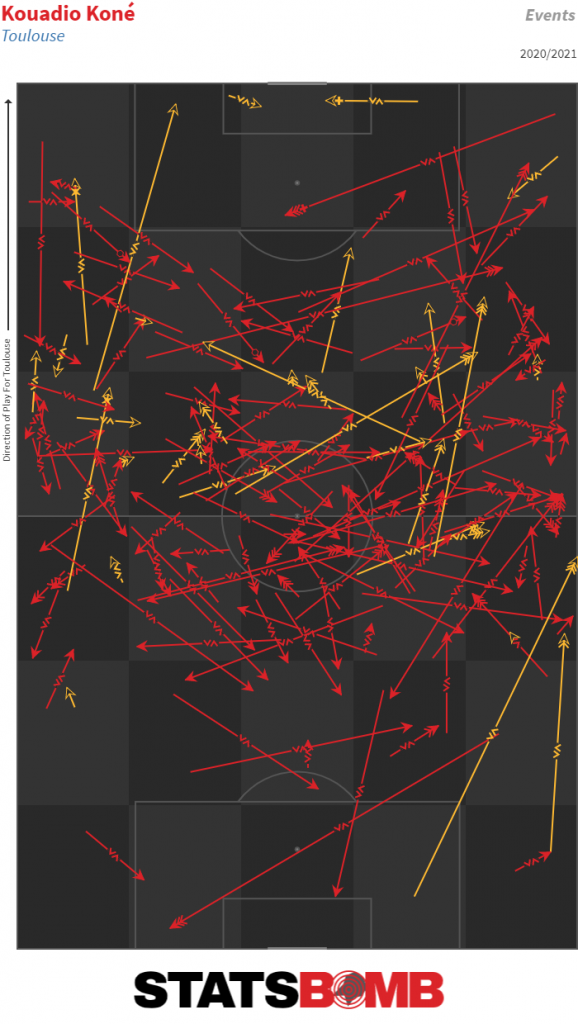
There isn’t too much of a goal threat from Koné yet, but that’s not to say he hasn’t contributed there, averaging 1.8 shots per 90 – with most of them from 18 yards out or further - amounting to 0.10 xG per 90, a figure which has translated into two goals this season.
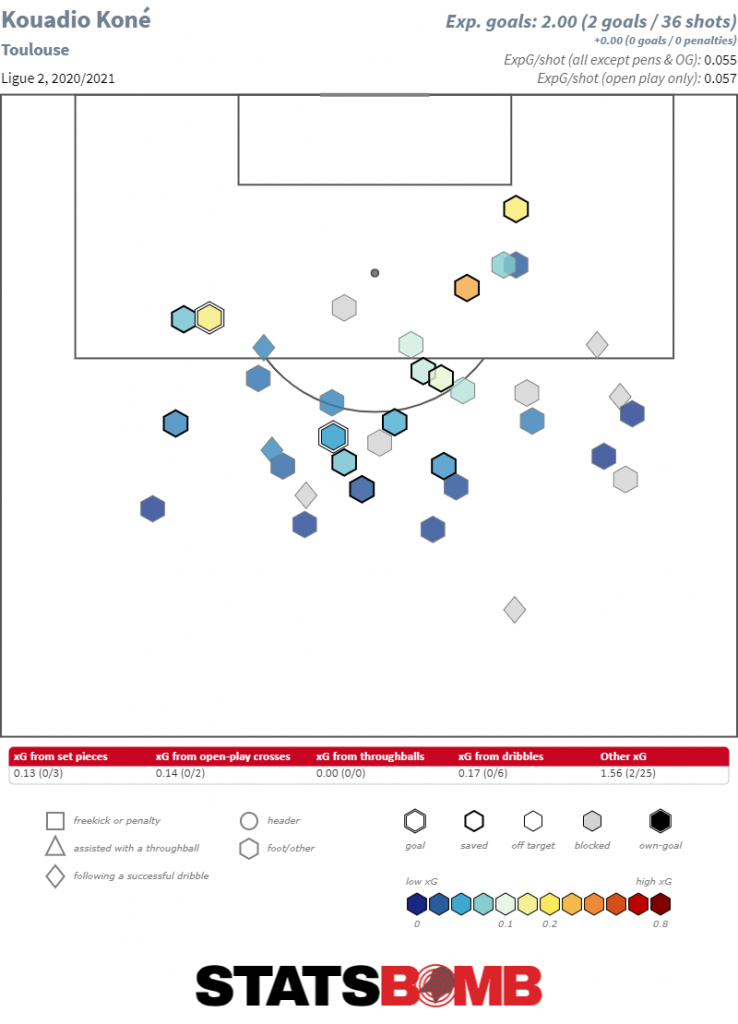
Remembering that he's only 19, it becomes easy to see why Mönchengladbach decided to take him on as a project player, clearly possessing the ability to compete at a higher level. If Koné can mimic the success that compatriot Maxence Lacroix has managed in his first season of Bundesliga football at Wolfsburg, then Gladbach fans are surely going to be pleased.
One player who hasn’t sealed a move in advance but has hardly been going under the radar is Mohamed Bayo. The Clermont Foot forward has been spearheading the third-placed side’s promotion push and leads the scoring with 17 goals - 15 when you exclude penalties. Bayo clearly has a superior goal threat to his striking peers in Ligue 2 with 3.4 shots per 90 the highest rate in the league, and many of them come from high-probability positions - an xG per shot of 16% is the eighth-best rate amongst Ligue 2 forwards.
TL;DR: LOTS of GOOD shots.

Bayo’s path to the Clermont first team is an interesting one. A graduate of their academy, he spent the 2019-20 season in the Championnat National on loan at USL Dunkerque, top scoring for his temporary side with 12 goals to lead them to promotion to Ligue 2. It was only the sale of Clermont top scorer Adrian Grbic to Ligue 1 Lorient in the summer of 2020 that gave Bayo the opportunity to enter the XI and lead the Clermont forward line. He hasn’t looked back.
Clearly a capable penalty box forward, scoring all of his 15 non-penalty goals from inside the box, the 22 year old’s contribution to Clermont’s attack extends further than his goal scoring exploits. Defensively his output could be a little higher, registering 10.8 pressures per 90 – slightly below average for Ligue 2 forwards, but his contribution to the attacking phase cannot be questioned. As well as carrying the ball reasonably well, with an average carry length of 4.6 metres and carrying the ball into the box 1.4 times per 90, behind only Paris FC's Gaëtan Laura, and as well as being plenty capable taking on defenders, completing 1.9 dribbles per 90 (only three Ligue 2 forwards complete more), it’s his contribution to creating chances for his team mates that stands out. He sets up 1 open play shot per game on average, and assists 0.17 expected goals per 90, which, when you do the math, means that the average chance he sets up has an expected conversion rate of 17%. Given the average shot is converted at ~10-11%, Bayo’s clearly chooses his moments to pass wisely when he’s not pulling the trigger himself, setting up quality goalscoring opportunities. That creativity plus the expected goals output of his own shots mean that Bayo's expected goals contribution amounts to the highest of all Ligue 2 forwards this season.
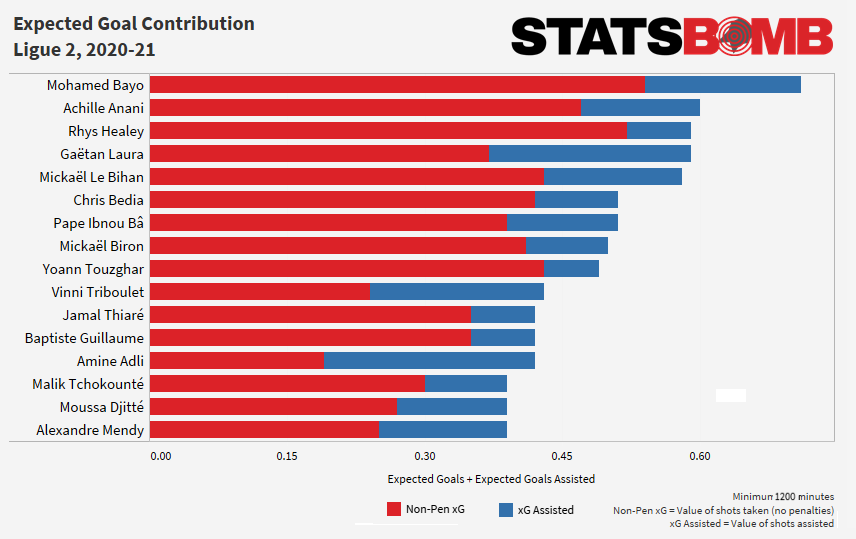
Clermont could well be playing Ligue 1 football themselves next season if they can seal promotion, currently two points with a game in hand behind Kouadio Koné's Toulouse, but otherwise it seems highly likely there’ll be interest from the top tier of French football, let alone elsewhere on the continent, for a forward that’s clearly stood out in the second tier this season. Kouadio Koné will certainly be in the big leagues. We'll wait and see if Mohamed Bayo joins him too.
StatsBomb has the richest and most accurate dataset available on the market with over 3300 events registered per game and covering 80+ competitions worldwide, including each of the second tiers of the Big 5 leagues. If you'd like to discuss our league coverage and data quality, get in touch today.
Our final look at the major European leagues sees the German Bundesliga come under the spotlight. Talk of a Bavarian behemoth, a alliterative forward winning with Wolves, hard-pressing Hütter, and sorry Schalke 04.
On the back of a Bundesliga, DFB-Pokal, and UEFA Champions League treble, Bayern Munich continue to meet their lofty standards.
On course for yet another 80+ points haul, the juggernaut continues to plough a furrow through the Bundesliga, but there are some curious trends in their performance levels this season. Bayern aren’t swatting teams aside with the ease and comfort that we’ve come to expect of them - their xG difference of 0.64 per game is their lowest since 2016/17.
Their 15-game expected goals trendline since the start of the 2018/19 season illustrates the fact that they haven’t quite been at their imperious best so far this campaign.
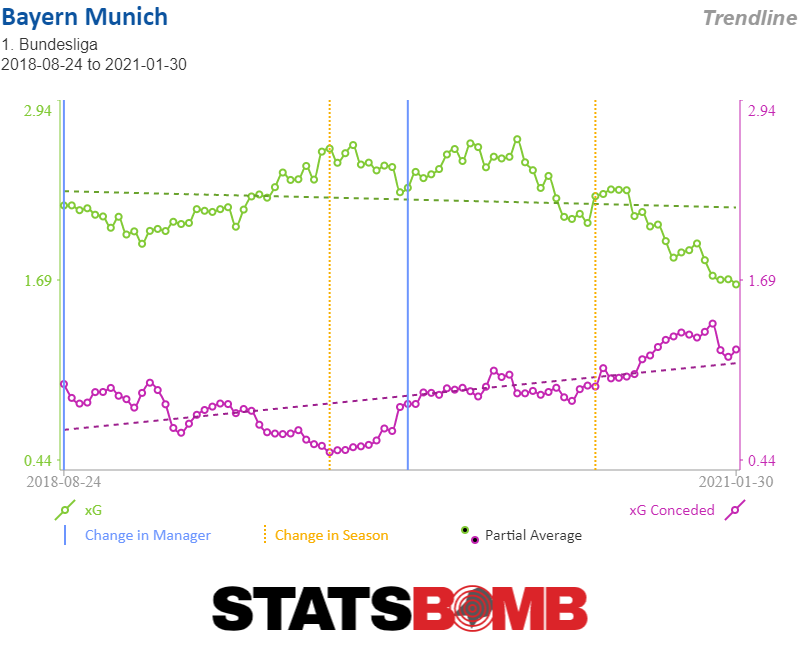
The 26 goals they've conceded already is only six shy of the 32 they gave up in the entirety of 2019/20. There was even a six-game spell between FC Köln on October 31st and Union Berlin on December 12th inclusive that Bayern didn’t “beat” their opponents on expected goals – in each of those six matches the opposition created the more dangerous opportunities.

But FCB didn’t lose a single one, claiming three wins and three draws from their “wobble”. Since then, they’ve flexed their muscle and performances have improved in line with a commanding haul of 21 points from the next eight, a run that has seen them pull clear at the top.
RB Leipzig are looking to go one better than last years third-place finish and their metrics look sufficiently strong to support them, but it's below them where chaos starts to ensue: just three points separate Wolfsburg in third and Borussia Mönchengladbach in seventh.
Wolfsburg, who had to win the Bundesliga relegation/promotion play-off match two seasons in a row between 2016-2018 just to stay in the league, are currently on course for their highest finish for six seasons and Champions League qualification. Big Wout Weghorst - to give him his full name - is having his best goalscoring season in the green of Die Wölfe. He's behind only Robert Lewandowski for non-penalty goals with 11.
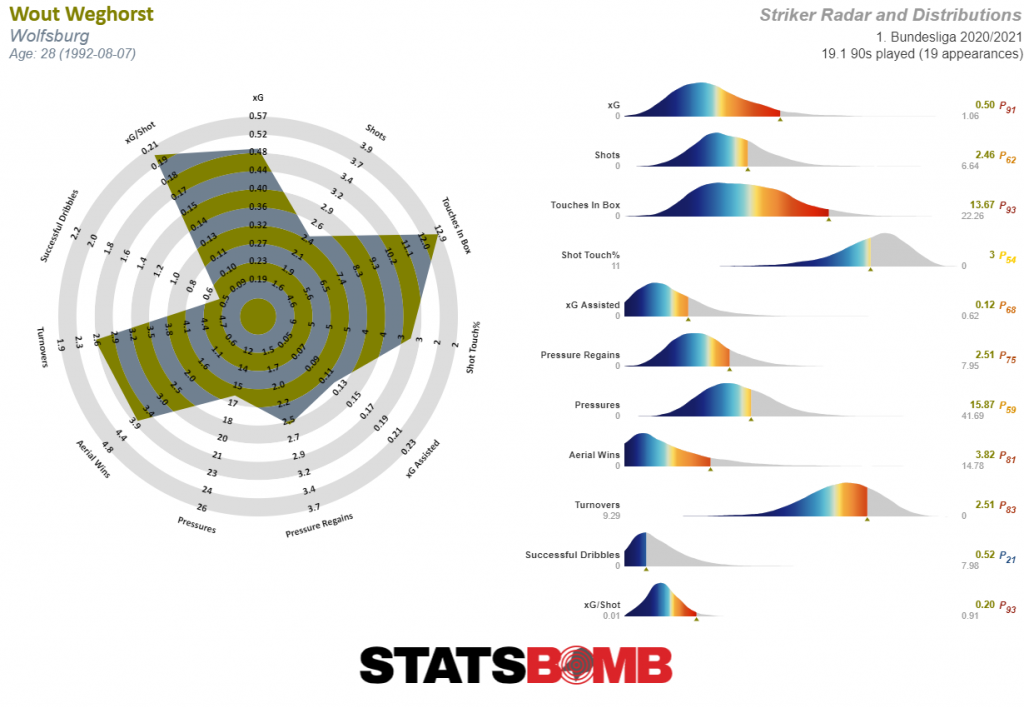
At the other end of the pitch, goalkeeper Koen Casteels is on course to concede fewer goals than expectation for the fourth season running, with the best Shot Stopping % in the Bundesliga this season (Save % - xSave%).
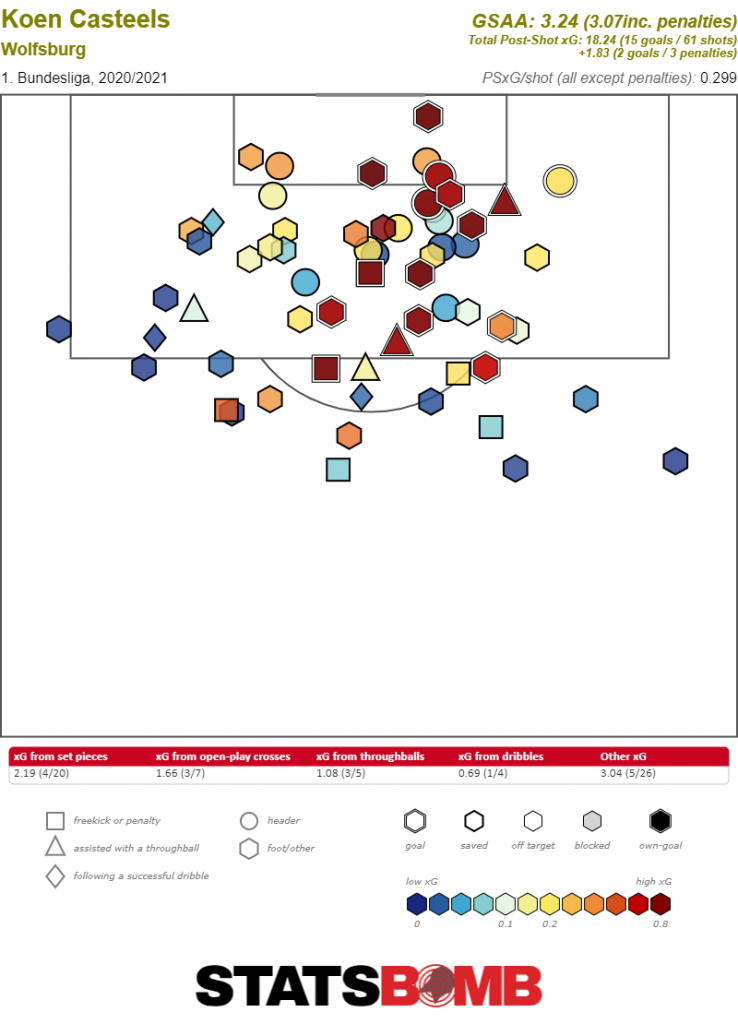
Another team gunning for a rare Champions League qualification is Eintracht Frankfurt, who haven’t qualified for the premier European competition since they lost the 1960 final to Real Madrid (when it was known as the European Cup). Right now, they're in position to break that duck.
You know what you’re going to get with an Adi Hütter side. The ex-RB Salzburg and Young Boys coach has again instilled an aggressive press into his team, one that’s proven effective as Frankfurt currently sit fourth in the table, having lost just two of their 19 games.
No other side in the league engages the opposition as regularly as Frankfurt: their Aggression % - the portion of opponent’s ball receipts that are tackled, fouled, or pressured within two seconds - is the highest in the Bundesliga at 24%.
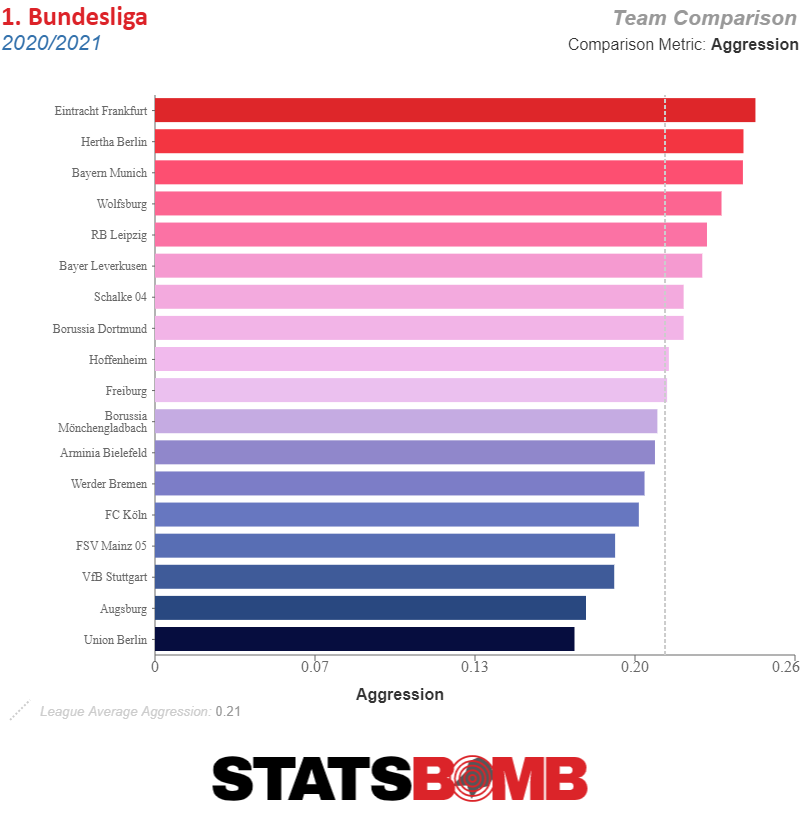
Andre Silva, like Weghorst, is having his best Bundesliga season yet, but it’s supplier-in-chief Daichi Kamada who’s providing the chances for the Portuguese forward. Kamada, who top-scored himself for Frankfurt in 2019/20, is behind only Thomas Müller and Marco Reus for xG assisted from open play.
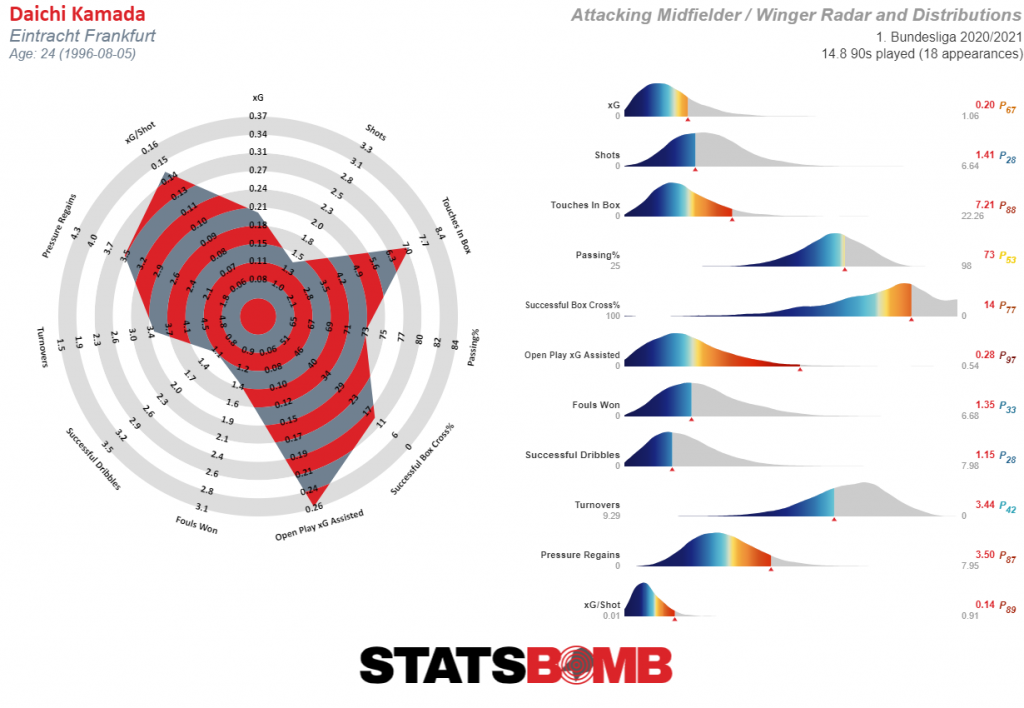
Meanwhile, the irony will not be lost on long-term followers of football analytics discourse for the way that Lucien Favre lost his job at Borussia Dortmund, on the back of some pretty large underperformance on their expected goals.
Favre's teams were notorious for outscoring the performance metric, but this season it came unstuck and Dortmund currently languish in sixth place despite having the strongest expected goal difference this campaign.

At 37.5 xG, which happens to be the same as Bayern’s, their chance creation in attack has been the best in the Bundesliga, but where Bayern have scored 51 non-penalty goals from their 37.5 xG, Dortmund have finished bang on expectation, scoring 37 times. They haven’t been able to match this in defence, conceding 25 non-penalty goals from 19.6 xG.
Despite a strong start, going 5-0-1 in their first six games, the five games that followed cost Favre his position as Dortmund won just once. His last match was a heavy home defeat to VfB Stuttgart - there was no ambiguity over who deserved the result on that day.
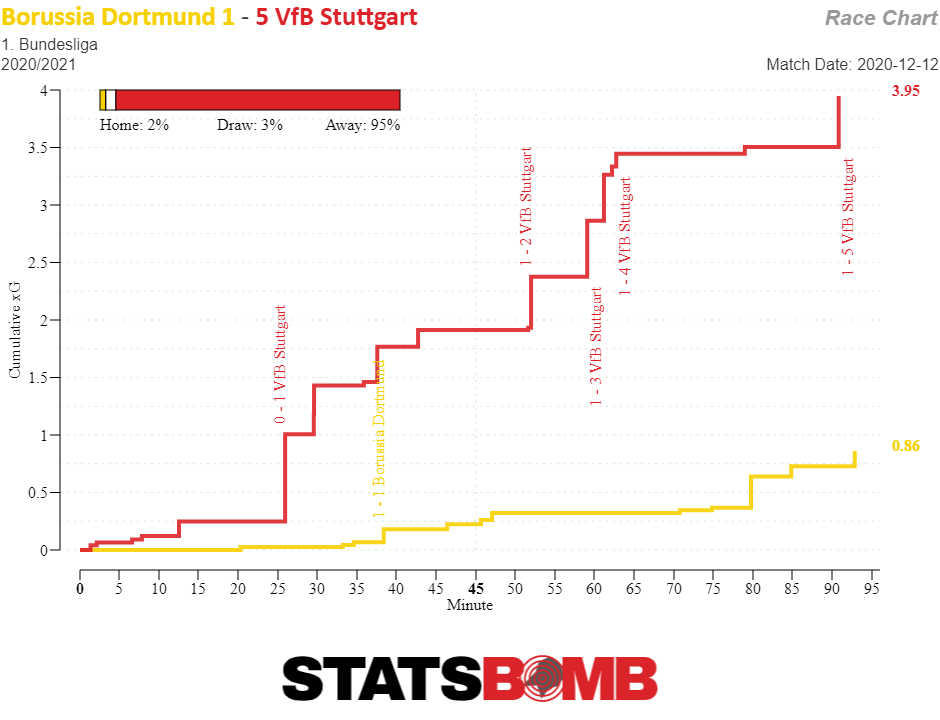
Speaking of VfB Stuttgart, they’re making an impressive mark on the league following promotion back to the Bundesliga in 2019/20. Previously assistant to Julian Nagelsmann at Hoffenheim, Pellegrino Matarazzo was appointed to his first senior management role in December 2019 and led Stuttgart to 2nd place in the Bundesliga 2. Right now, Stuttgart have the fourth-best xG Difference but are behind expectation in both defence and attack, to have a goal difference of +6 from an expected goal difference of +9.5.
At the bottom, Schalke 04’s sorry season has persisted despite two managerial changes already. David Wagner was politely asked to leave just two games into the 2020/21 campaign after back to back defeats continued an 18-match winless run, and the appointment of Germany under-18’s coach Manuel Baum did not have the desired effect. He was relieved of his duties after just 10 games. Now it’s Christian Gross who looks to dig something out of the Miners in his 33rd year of management.
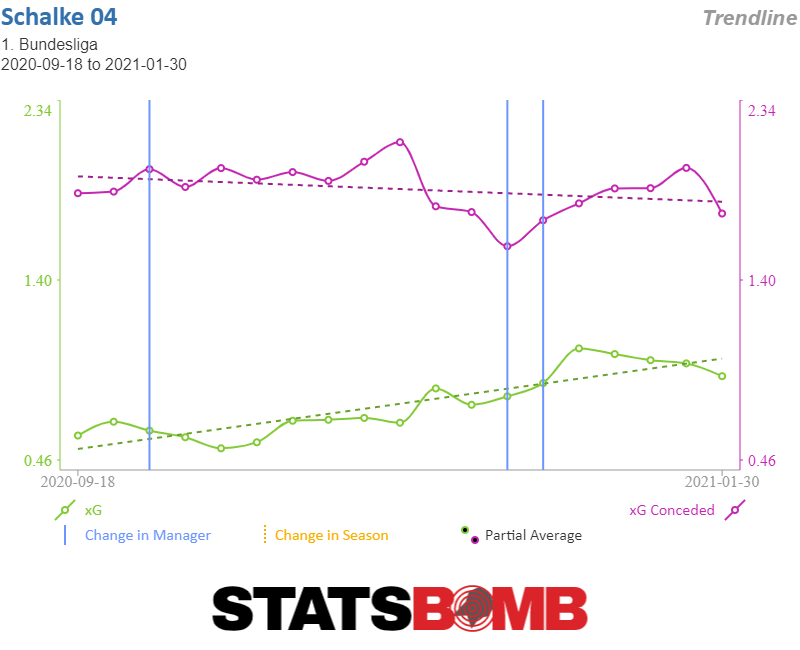
Nine points adrift and bottom of nearly every performance metric you can think of, it’ll be some turnaround if Gross can steer them to safety.
Join us at StatsBomb Evolve on March 17th 2021 to discover how we're going to change the football industry, including the launch of our new data product, StatsBomb 360. To find out more, click here.
We continue our tour through the major European leagues with a look at the season to date in La Liga, the most goal and shot shy of the big five leagues but one that nevertheless features some intriguing storylines, including a runaway leader, tactical adjustments and some standout individuals.
Atlético Madrid, Runaway Leaders
In the last 16 seasons, Atlético Madrid are the only side other than Barcelona and Real Madrid to have won La Liga, and they may just be on course to do so again. Diego Simeone’s side are 10 points clear at the top, and also have a game in hand over those two sides. Fifty points from 19 matches has them on course to equal the league’s highest-ever points total of 100 if they are able to maintain that rhythm. The likelihood is that they won’t. No side have overperformed their metrics to a greater extent than Atlético so far this season. They are running ahead of expectation at both ends of the pitch, but particularly so in attack, where they are around 13 goals ahead of their xG. 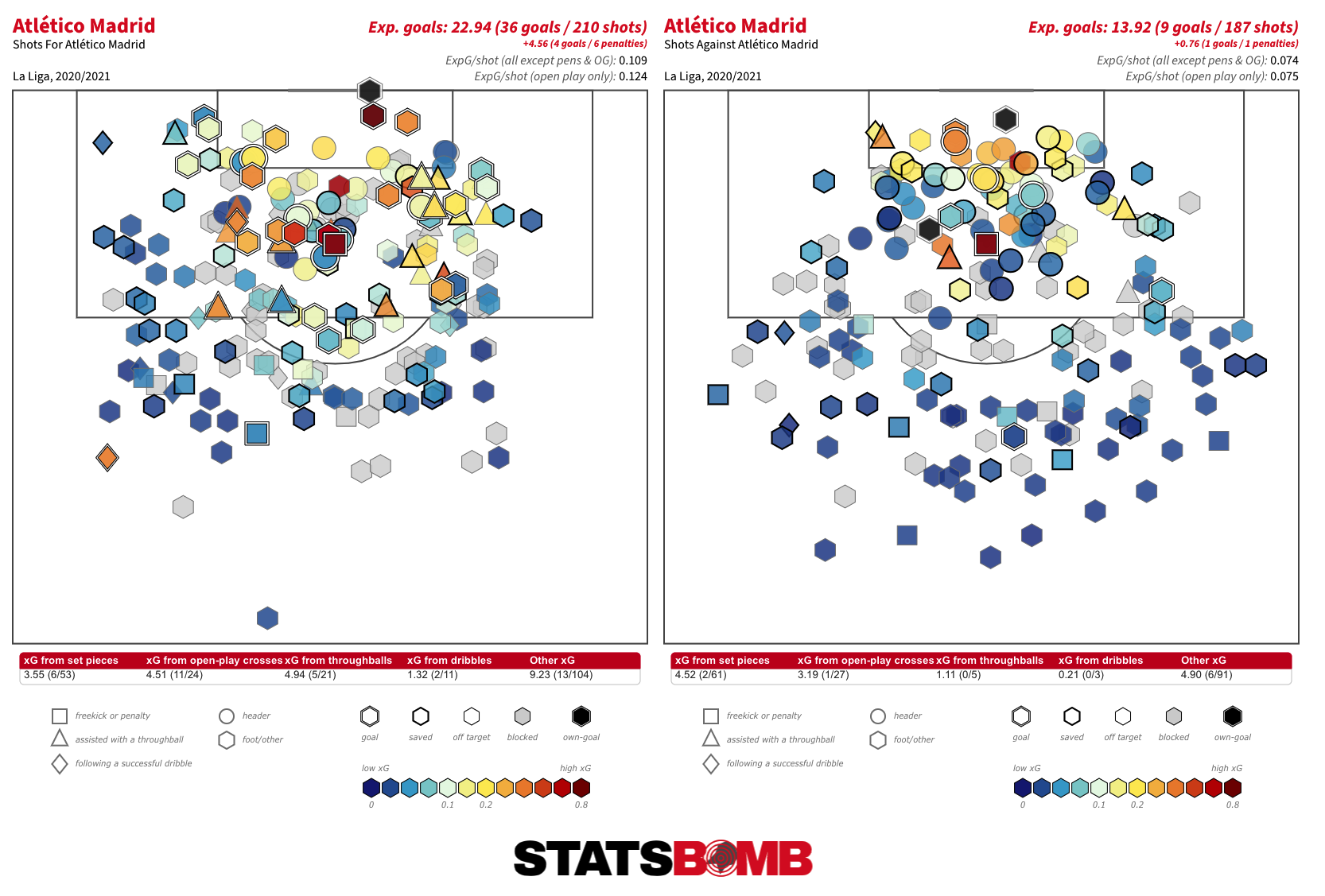 It is almost the exact opposite to what happened to them last season, when all their forwards were underperforming their xG at this stage of the campaign. This time around, everyone is overperforming: Luis Suárez, Marcos Llorente, João Félix, Ángel Correa, even Yannick Carrasco. That is likely to even out a bit from hereon out, but Atlético can still count upon a goalkeeper who has consistently shown his value by overperforming his metrics. On both an outright and shot-volume-adjusted basis, Jan Oblak has been the league’s best shot stopper this season.
It is almost the exact opposite to what happened to them last season, when all their forwards were underperforming their xG at this stage of the campaign. This time around, everyone is overperforming: Luis Suárez, Marcos Llorente, João Félix, Ángel Correa, even Yannick Carrasco. That is likely to even out a bit from hereon out, but Atlético can still count upon a goalkeeper who has consistently shown his value by overperforming his metrics. On both an outright and shot-volume-adjusted basis, Jan Oblak has been the league’s best shot stopper this season. 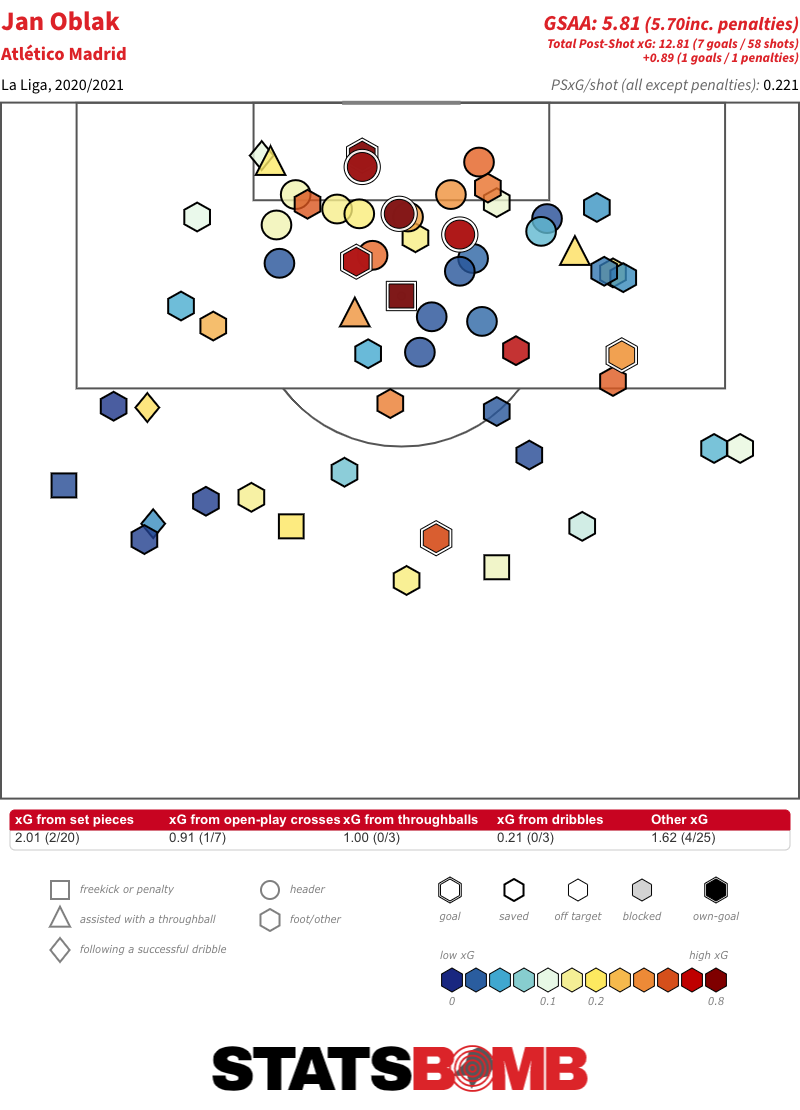 Even if Atlético’s points accumulation rate does slow somewhat during the second half of the campaign, they probably have enough of a cushion to absorb that and still end up lifting the trophy. Barcelona seem to be finding their feet after a shaky start, at least in terms of results, under Ronald Koeman, and do have the best underlying numbers in the league...
Even if Atlético’s points accumulation rate does slow somewhat during the second half of the campaign, they probably have enough of a cushion to absorb that and still end up lifting the trophy. Barcelona seem to be finding their feet after a shaky start, at least in terms of results, under Ronald Koeman, and do have the best underlying numbers in the league... 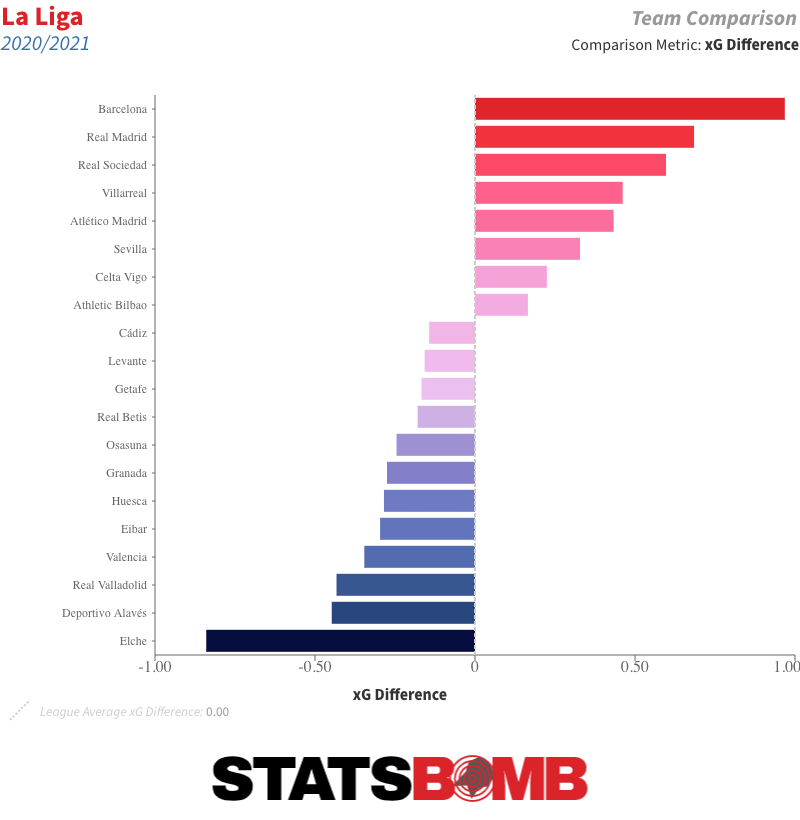 ...but they would have to maintain an extremely strong pace to chase Atlético down from here. Real Madrid likewise have better metrics than the current leaders, but have struggled for consistency. The league looks to be Atlético’s to lose.
...but they would have to maintain an extremely strong pace to chase Atlético down from here. Real Madrid likewise have better metrics than the current leaders, but have struggled for consistency. The league looks to be Atlético’s to lose.
Pressing Matters
One of the most obvious changes upon Koeman’s arrival to the Barcelona bench was that they immediately began to contest possession less frequently, particularly high up the pitch. Whether by PPDA (Passes per Defensive Action) or Aggression (the percentage of opposition ball receipts that are contested within two seconds), they were one of most passive teams in the league through the first few months of the season. 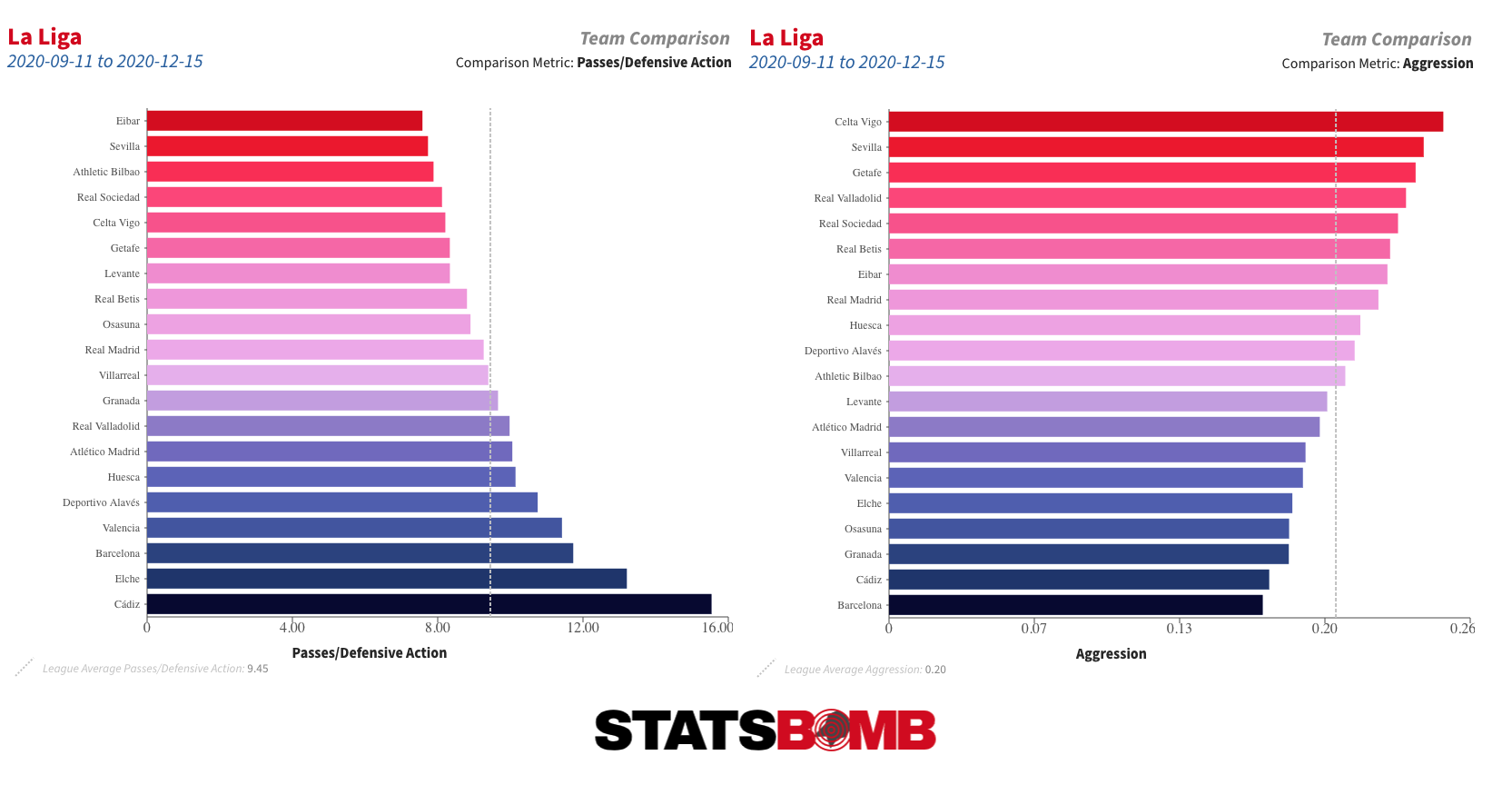 In fact, by the former measure, Barcelona were more passive than they’d been at any previous stage in our dataset, which extends back to 2004, in those first 10 or 11 matches under Koeman. But since then, there does seem to have been a shift towards a slightly more proactive setup, more in line with what we saw at times under Ernesto Valverde.
In fact, by the former measure, Barcelona were more passive than they’d been at any previous stage in our dataset, which extends back to 2004, in those first 10 or 11 matches under Koeman. But since then, there does seem to have been a shift towards a slightly more proactive setup, more in line with what we saw at times under Ernesto Valverde. 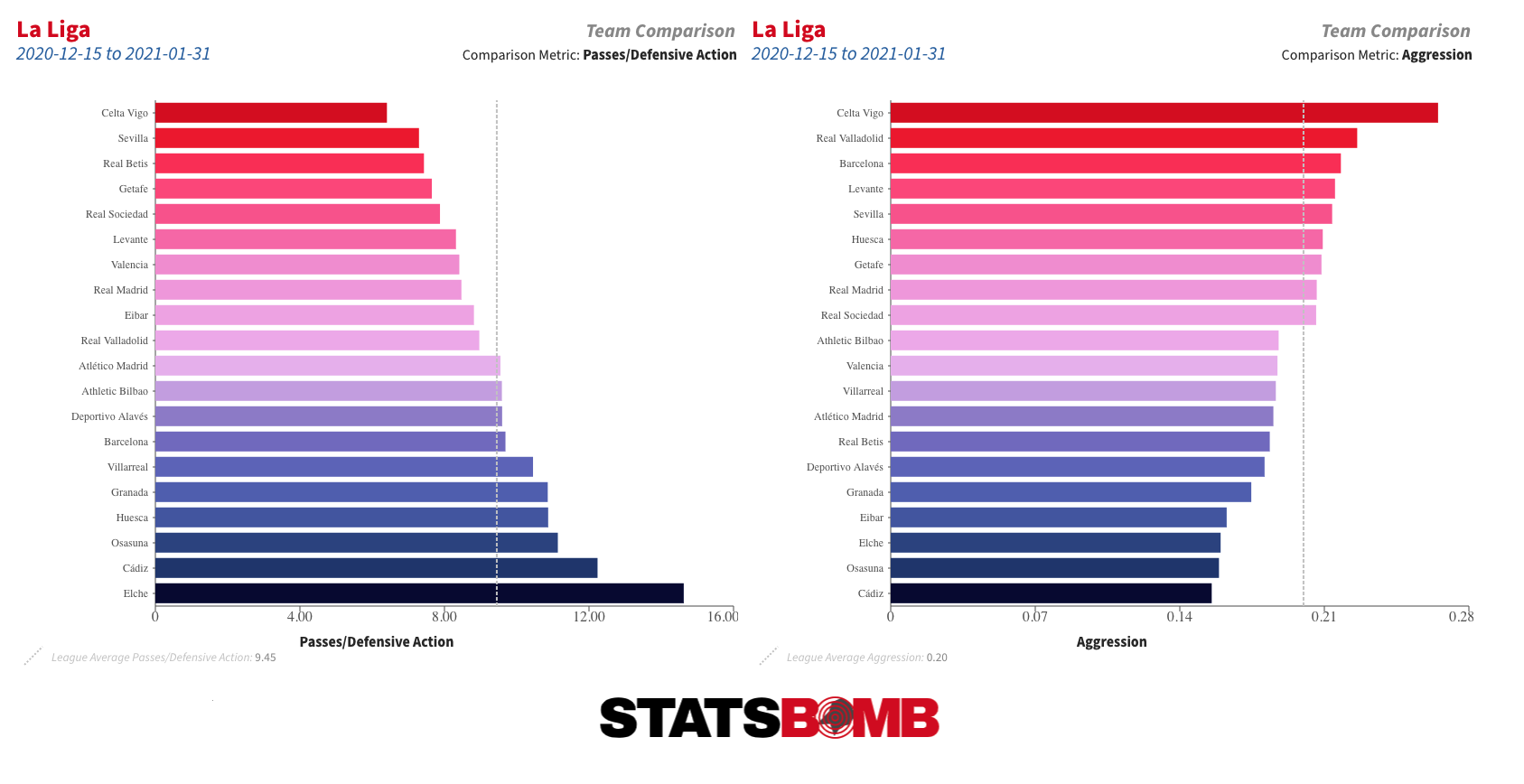 Some of that could simply be due to the natural ebb and flow of the season. Barcelona had midweek Champions League engagements through much of the opening three months of the campaign, perhaps necessitating a less energy intensive approach. We’ll have to wait for a larger sample to see if this apparent shift holds through the remainder of the campaign. At the opposite end of the scale sit a Celta Vigo side who have become notably more proactive without the ball this season, and particularly so since Eduardo Coudet replaced Óscar García as head coach in November. They have pushed their defensive line up and are logging a higher Aggression percentage than any other side in the league.
Some of that could simply be due to the natural ebb and flow of the season. Barcelona had midweek Champions League engagements through much of the opening three months of the campaign, perhaps necessitating a less energy intensive approach. We’ll have to wait for a larger sample to see if this apparent shift holds through the remainder of the campaign. At the opposite end of the scale sit a Celta Vigo side who have become notably more proactive without the ball this season, and particularly so since Eduardo Coudet replaced Óscar García as head coach in November. They have pushed their defensive line up and are logging a higher Aggression percentage than any other side in the league.
Relentlessly Positive Ontiveros
Huesca have been in the bottom three since the seventh matchday, but things are so tight down there, with just four points spanning the bottom six, that they still have a decent chance of scrambling clear of the relegation zone. If they are to do so than Javi Ontiveros is likely to have a big role to play. Whether from the start or the bench, he is an intensely positive player who seems not to understand the idea of a backwards step. Whether on the pass or the carry, he is a relentless ball progressor... 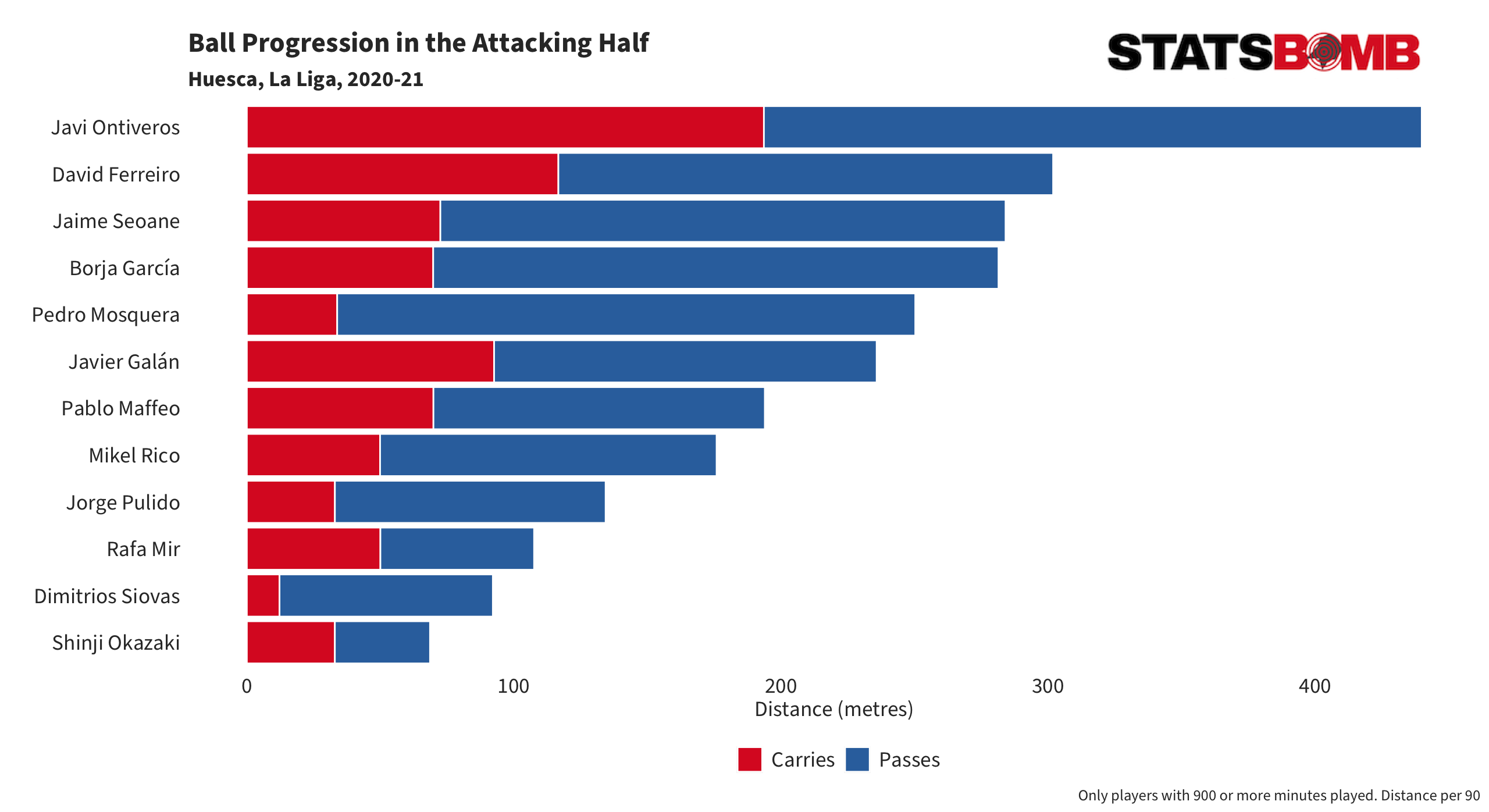 ...and while his shooting locations bring to mind Spurs-era Andros Townsend...
...and while his shooting locations bring to mind Spurs-era Andros Townsend... 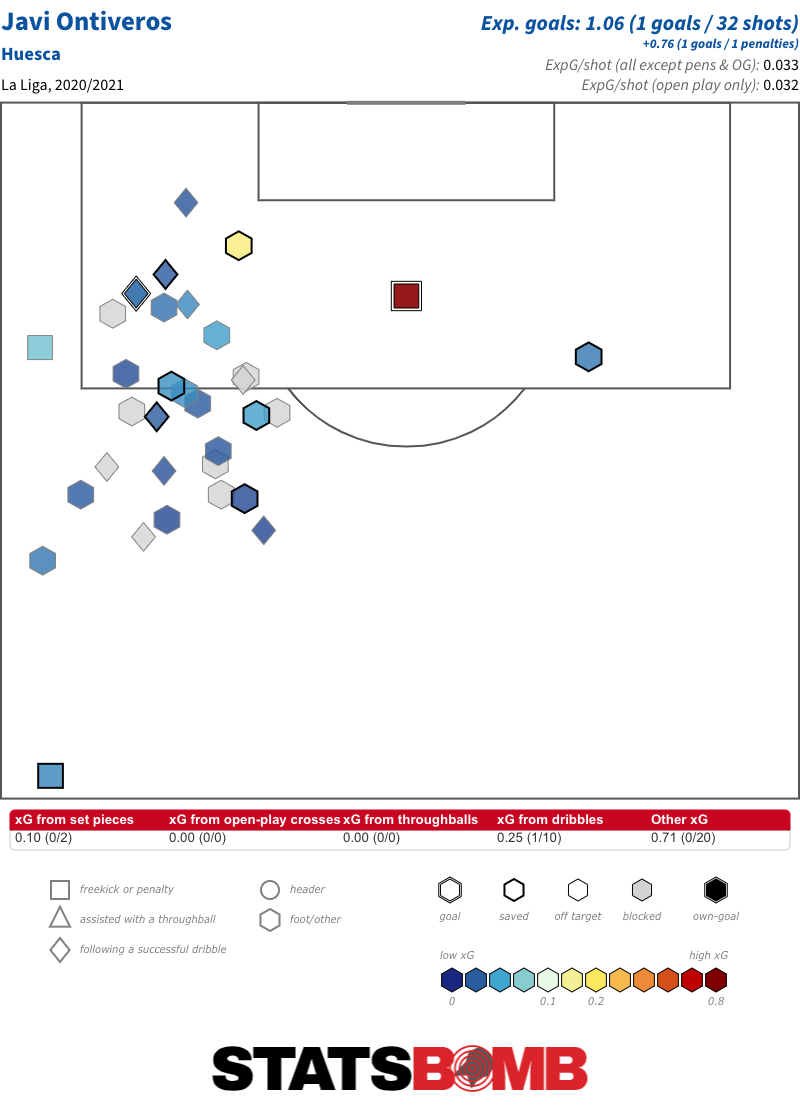 ...he is such an entertaining watch that you can almost forgive him. Not only does he produce far more shots per 90 after carries of 10 metres or more (1.47) than any other player in the league, but he also leads it in nutmegs per 90 (ahead of Alberto Perea and Bryan Gil) and ranks in the top three for successful dribbles. Ontiveros is the guy to inject a bit of fun into your viewing of La Liga.
...he is such an entertaining watch that you can almost forgive him. Not only does he produce far more shots per 90 after carries of 10 metres or more (1.47) than any other player in the league, but he also leads it in nutmegs per 90 (ahead of Alberto Perea and Bryan Gil) and ranks in the top three for successful dribbles. Ontiveros is the guy to inject a bit of fun into your viewing of La Liga.
Additional tidbits
- Nabil Fekir of Real Betis has taken more shots than any other player in the big five leagues this season without scoring: 53. He’s also only converted one of his three penalties.
- One of the many advantages of the StatsBomb dataset is that we record the foot with which each pass is played. That allows us to see that for the second season in a row, Tomás Pina of Alavés is the most two-footed player in La Liga. Last season, he played an exact 50-50 split of passes with each foot. This time he’s slightly favoured the left in a 51-49 split. Pedro Bigas has consistently been one of the league's most two-footed players through his time with Las Palmas and now Eibar, and he is again there at Pina’s side.
Join us at StatsBomb Evolve on March 17th 2021 to discover how we are revolutionising the football data industry (once again), including the launch of our new data product, StatsBomb 360. 
We go to France next in our mid-season reviews of the major European leagues, where the title race is far from the foregone conclusion it has been in recent seasons, and with some surprise packages providing entertaining support acts along the way.
Just once in the last eight seasons - Monaco in 2016/17 - has the Ligue 1 title not been won by PSG. The Parisian’s grip on French football has not just come in the form of league titles, it’s also been the processional inevitability and comprehensive margin of victory that observers have become all too used to in recent seasons.
Not this season. Mesdames et messieurs, we have ourselves a title race.
We’ll start with the holders. PSG began their title defence with defeats in the opening two rounds of the season, the first time they’d done so since 1984/85. A curtain-raising defeat to newly promoted Lens was still a shock despite several enforced absences due to positive Covid-19 tests or isolation, including the pair of Mbappé and Neymar. The following 1-0 loss to Marseille in Le Classique was the equivalent of using sandpaper to rub salt into the wound.
The subsequent eight-game winning streak, scoring 26 and conceding 1, that followed suggested on a surface-level that Les Rouge et Bleu were back on course and their period of plain sailing was to continue, but that wasn't to be the case. Hints at a downturn in performance turned into nudges, and then nudges turned into sharp elbows to the ribs as the team’s attacking output drifted away. A run of three wins in seven games saw the end of Thomas Tuchel's managerial reign.

Whilst their attack only cooled in more recent games, there had always been warning signs on the defensive end that all was not well, despite conceding the fewest goals in the league at the midway point. It’s thanks to a combination of poor finishing from their opponents as well as consistently good goalkeeping from Keylor Navas that PSG have so far retained the best goals against record in the league because by xG, they are far from the most watertight defensively, conceding chances worth 23.4 xG, only the seventh-best record in the division. This is where the most obvious improvements can be made for the incoming Mauricio Pochettino.

It’s the team at the top of the xG conceded ranking that also tops the league table as things stand. Lille have the lowest expected goals conceded and have indeed conceded only one more goal than PSG – a defensive record that has helped them to lose just two games in 22 this league season.
It’s a clichéd blend of youth and experience in the centre of defence providing the sturdy foundation for Lille’s title charge to sit on. The now 37-year-old José Fonte partners the highly-rated Sven Botman, freshly graduated from the Ajax academy, and both are screened by the busy Benjamin Andre in central midfield, who leads the league in tackles + interceptions.
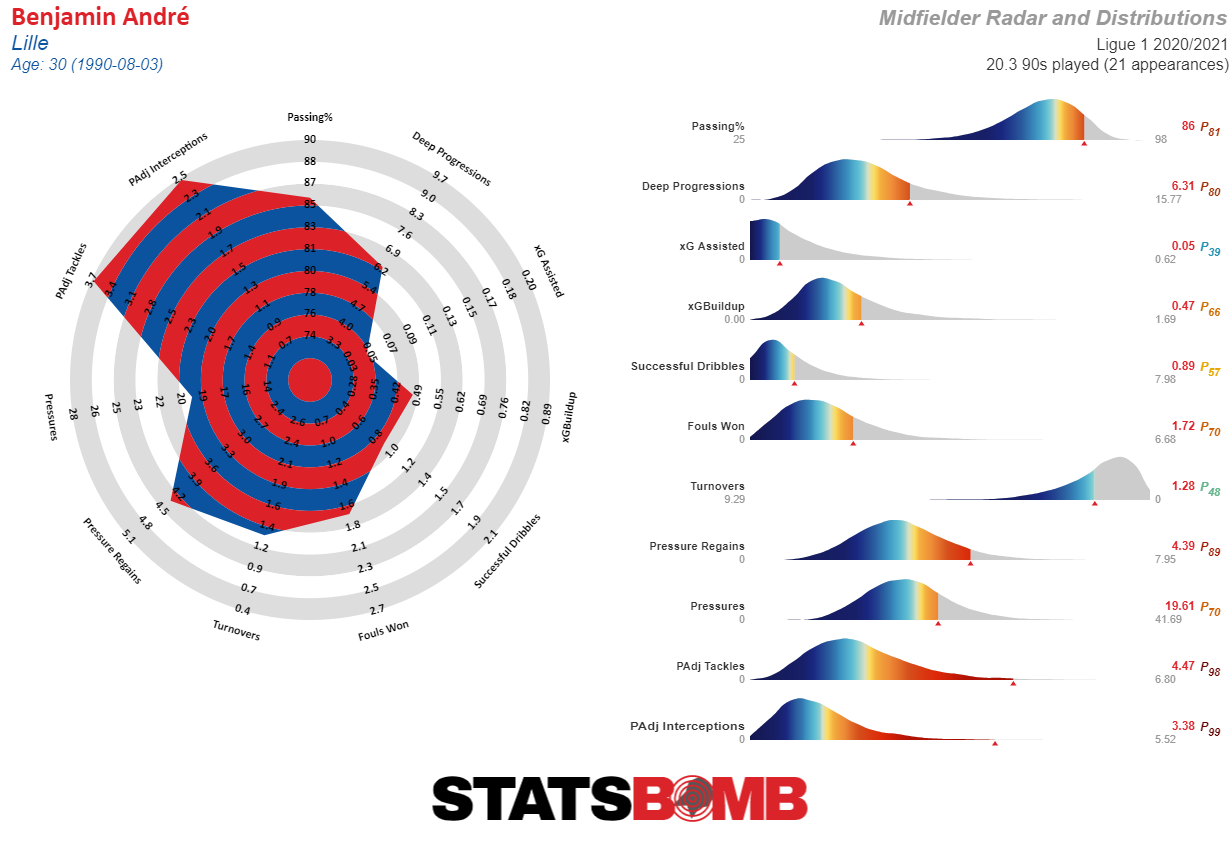
It’s a highly effective partnership that Fonte and Botman share, with each excelling in different areas on the game – Botman providing the progressive outlet in buildup, playing the second-most passes from open play in Ligue Un, whilst Fonte sticks to putting his body on the line in front of goal, ranking joint-first in the league for blocks made per shot conceded. This willingness to keep the goalkeeper's gloves clean at any cost has helped Lille to concede the joint-fewest Clear Shots in all of Ligue 1 – shots with just the goalkeeper between ball and goal - rarely allowing their opponents a straightforward view of the goal.
Organised in the defensive phase, they’re equally well-drilled in the defensive transition, running an effective counterpress high up the pitch to prevent the opposition from hurting them with space in behind, resulting in a league-low return for shots conceded on the counter attack.
2nd placed Lyon currently have the best underlying numbers in the league and lead the pack by expected goal difference. It's mostly due to massively upgrading their attack that they've been able to push themselves into title contention: compared to last season, they’ve added 3.5 Shots per game to their output, and are also taking those shots from better locations, resulting in a 0.8 xG per game upgrade on their final third output.
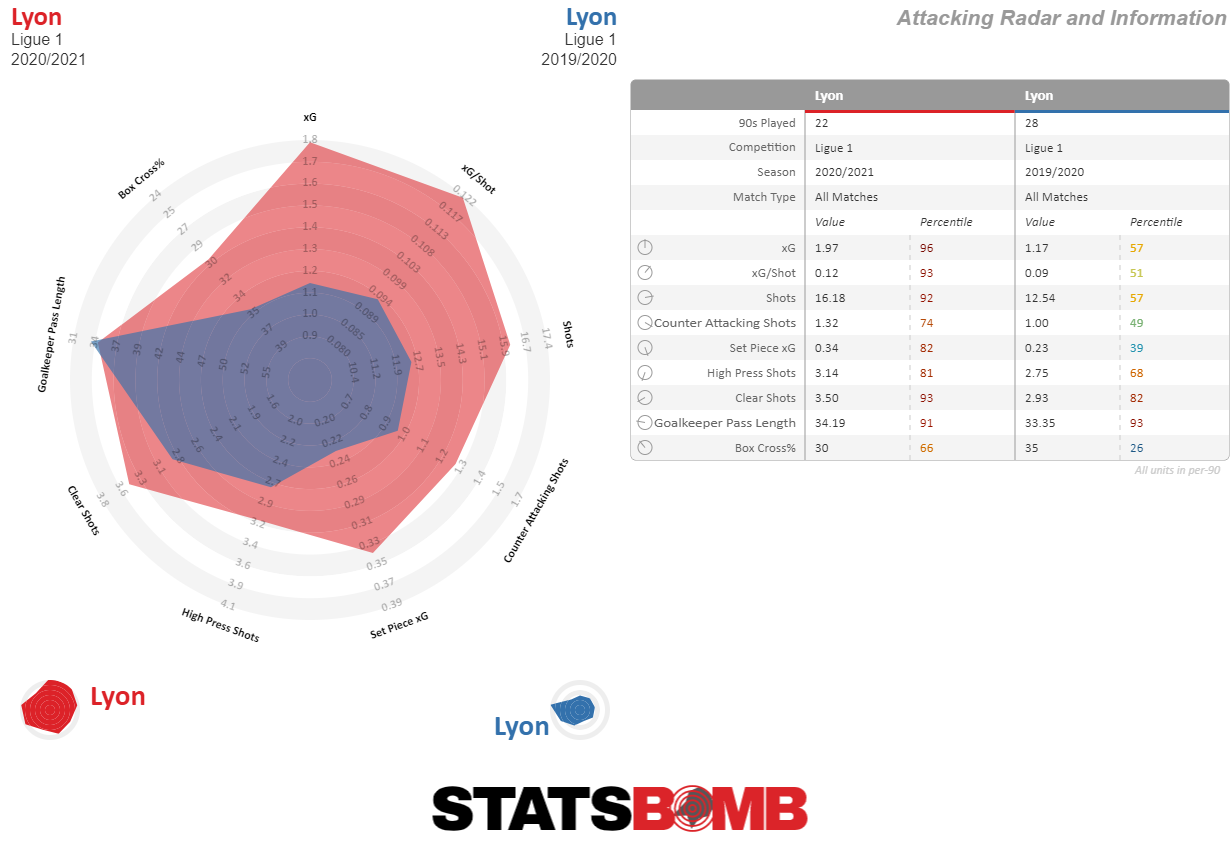
Manager Rudi Garcia, a Ligue 1 title winner with Lille in 2010/11, took Lyon to the Champions League semi-finals in 2020 despite a 7th-placed finish in the league, and has managed to translate that European success into domestic form in this campaign.
Despite playing as the centre-forward, Memphis Depay has been the team’s leading creative outlet, laying on the chances for wide players Karl Toko Ekambi and Tino Kadewere rather than providing the main goal threat himself. Depay ranks second only to Ángel Di María for xG assisted per 90 in Ligue 1. Toko Ekambi and Kadewere are the willing recipients off the left and right flank respectively, with both having the second and third highest xG per 90 respectively in the league.
It isn't just their cohesive and potent attack that's giving Lyon a very credible chance at winning their first title since 2008 though, it's the balance they've found between that and a very competent defence. Les Gones have the best xG per shot conceded and it’s largely down to allowing just six(!) shots within their six-yard box all season.

AS Monaco are well in the race as well, just six points behind leaders Lille, and their on-pitch process appears to back that up, having the third-best xG Difference in the league. Goalkeeping issues have held them back so far - Benjamin Lecomte had the worst Shot Stopping % (Save% - xSave %) in the division before breaking his hand, and replacement Vito Mannone fared almost equally poorly. The result is that Monaco have conceded 27 non-penalty goals from 18.8 xG, though it’s also only fair to point out that this has been counter-balanced by some overperformance on the attacking end. Their attack has been powered by a sizeable output from set plays with 14 goals a full six goals clear of the next best team in this phase. Centre backs Guillermo Maripán and Axel Diassi have netted seven goals between them up to now, with Maripán, at 0.44, currently enjoying a better goals per 90 rate than Neymar.
Elsewhere, there are two surprise packages sat in the top half - Metz and Lens. Metz finished 15th last season following promotion but are already sat on the same points tally they finished last season’s curtailed renewal with, on 34 points from 22 games this campaign. There’s been some overperformance at both ends of the pitch for Les Grenats, but there are also some clear signs they have improved on their 2019/20 showing. Their xG per shot against of 0.08 is only marginally bettered by Lyon and Lille, and they’re keeping this down by preventing their opponents from shooting from close range as often as possible – the average Shot Distance by their opponents of 18 metres is the second-furthest in the league.
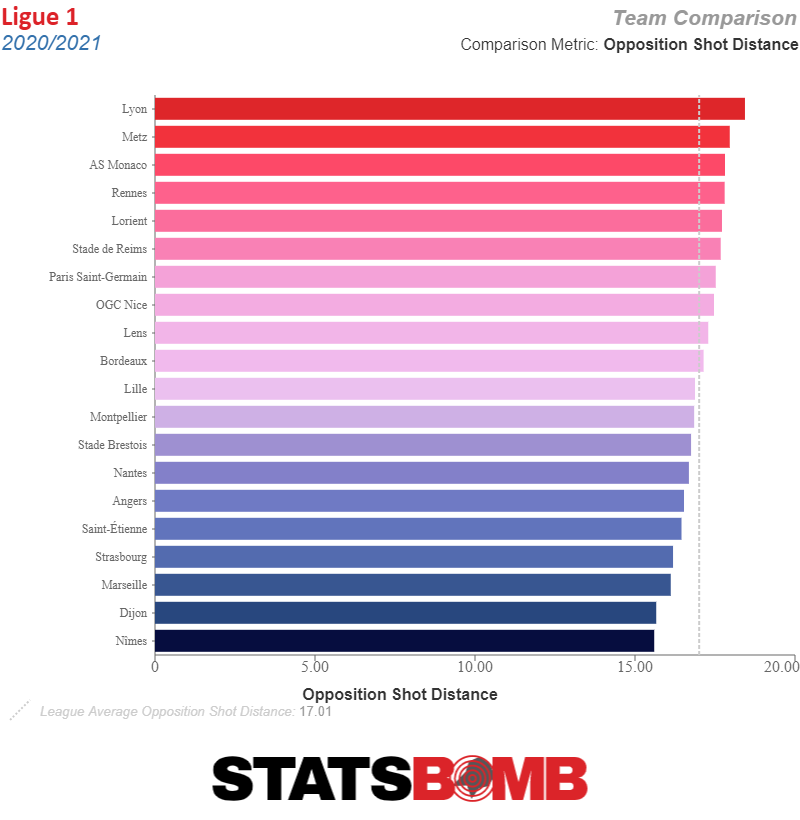
Lens are interesting for two reasons: that they’re newly promoted and that their underlying numbers are actually legit – they have the sixth-best expected goal difference. Franck Haise’s side are running a highly effective defence and are one of the most disruptive sides in the league in their own defensive third, preventing their opponents from moving the ball close to their goal. Lens have conceded the second-fewest passes inside their own penalty area and second-fewest passes within 20m of their goal.
Their organised block stops the opposition from having any meaningful possession in areas that threaten their goal. Towards the bottom, Dijon find themselves 19th in the table despite having conceded the joint-ninth fewest goals with 31. How? Because they’ve scored just 15 times. Things could be even worse too, given the quite mysterious misfiring of their opponents in front of goal, whilst there’s nothing in fellow strugglers Nîmes underlying numbers to suggest they might pull off an equally dramatic escape.
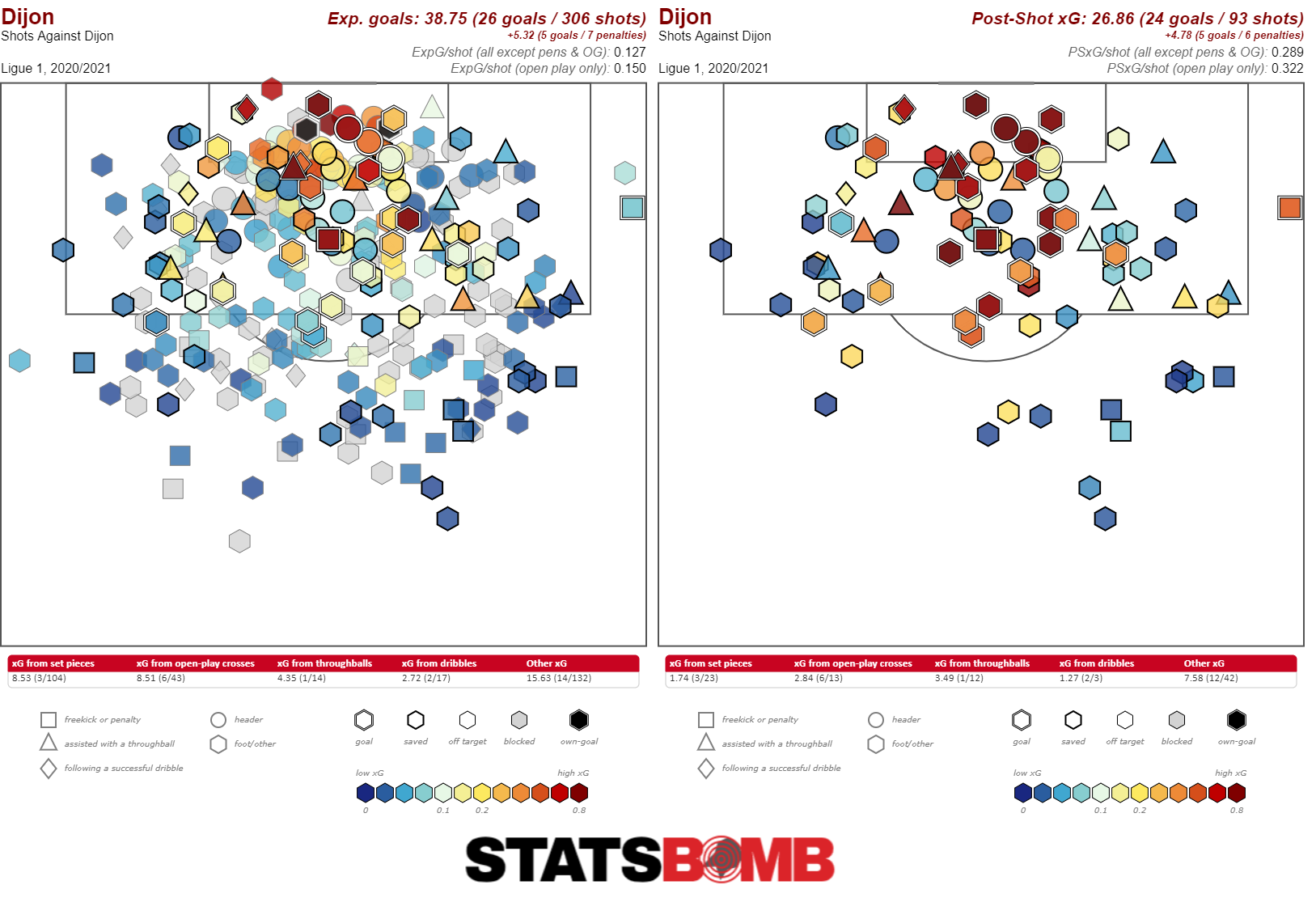 There are genuine threats to PSG’s title defence this campaign and from multiple directions. Pochettino will need to have an immediate impact on his Parisians if they’re to retain yet another Ligue 1 victory.
There are genuine threats to PSG’s title defence this campaign and from multiple directions. Pochettino will need to have an immediate impact on his Parisians if they’re to retain yet another Ligue 1 victory.
Join us at StatsBomb Evolve on March 17th 2021 to discover how we're going to change the football industry, including the launch of our new data product, StatsBomb 360. To find out more, click here.
We begin our round-up of the mid-season state of play in the major European leagues with a look at Italy's Serie A, where a close title race, a plethora of goals and an unfortunate finishing run feature among the standout stories at this stage of the campaign.
The Tightest Title Race
Serie A could well be on course for one of the closest finishes of the modern era. Five or six teams have put together broadly similar results and underlying numbers to date, and it wouldn’t be at all surprising if three or four of them finished the campaign within a couple of wins or less of one another.
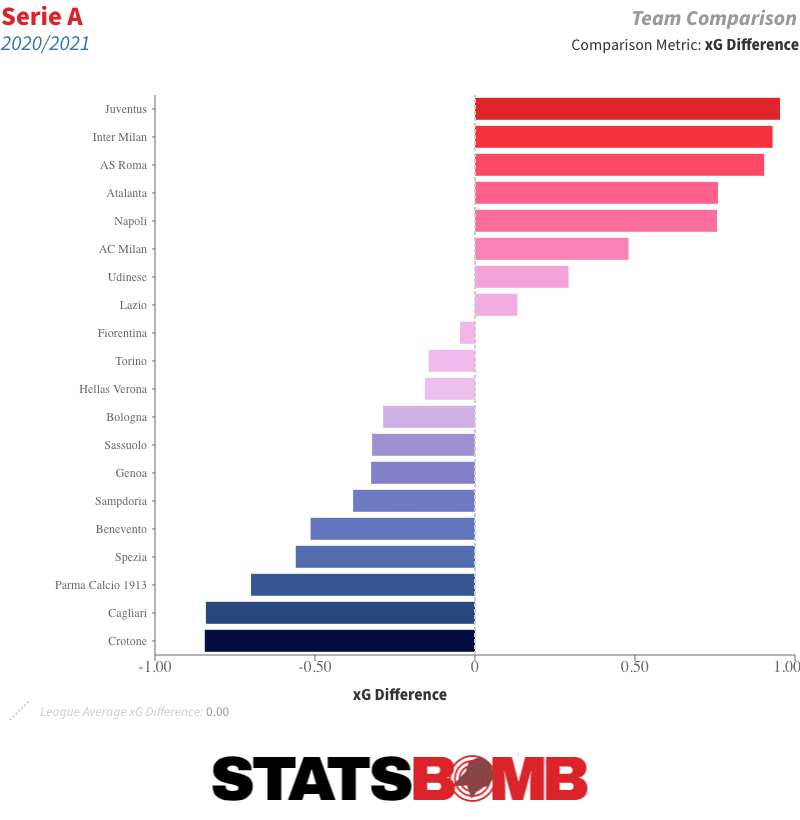
The two Milan sides have set the pace so far, but both Roma and nine-time defending champions Juventus are within reach, while Napoli, Atalanta and a Lazio side with less competitive metrics are only slightly further back. Inter look particularly strongly placed, with the second best metrics and a workable margin over both Juventus (with the best) and Roma (with the third best). Romelu Lukaku has been near unstoppable up front.

Milan have carried their excellent form down the final stretch of last season into this, but there are a couple of things that may count against them during the second half of the campaign. Firstly, while they are performing pretty much exactly in line with their metrics, they are not as strong of those of their primary competitors. Secondly, Stefano Pioli’s side have benefited from far more than their fair share of penalties. They’ve won nearly three times and scored exactly twice as many as any other team.
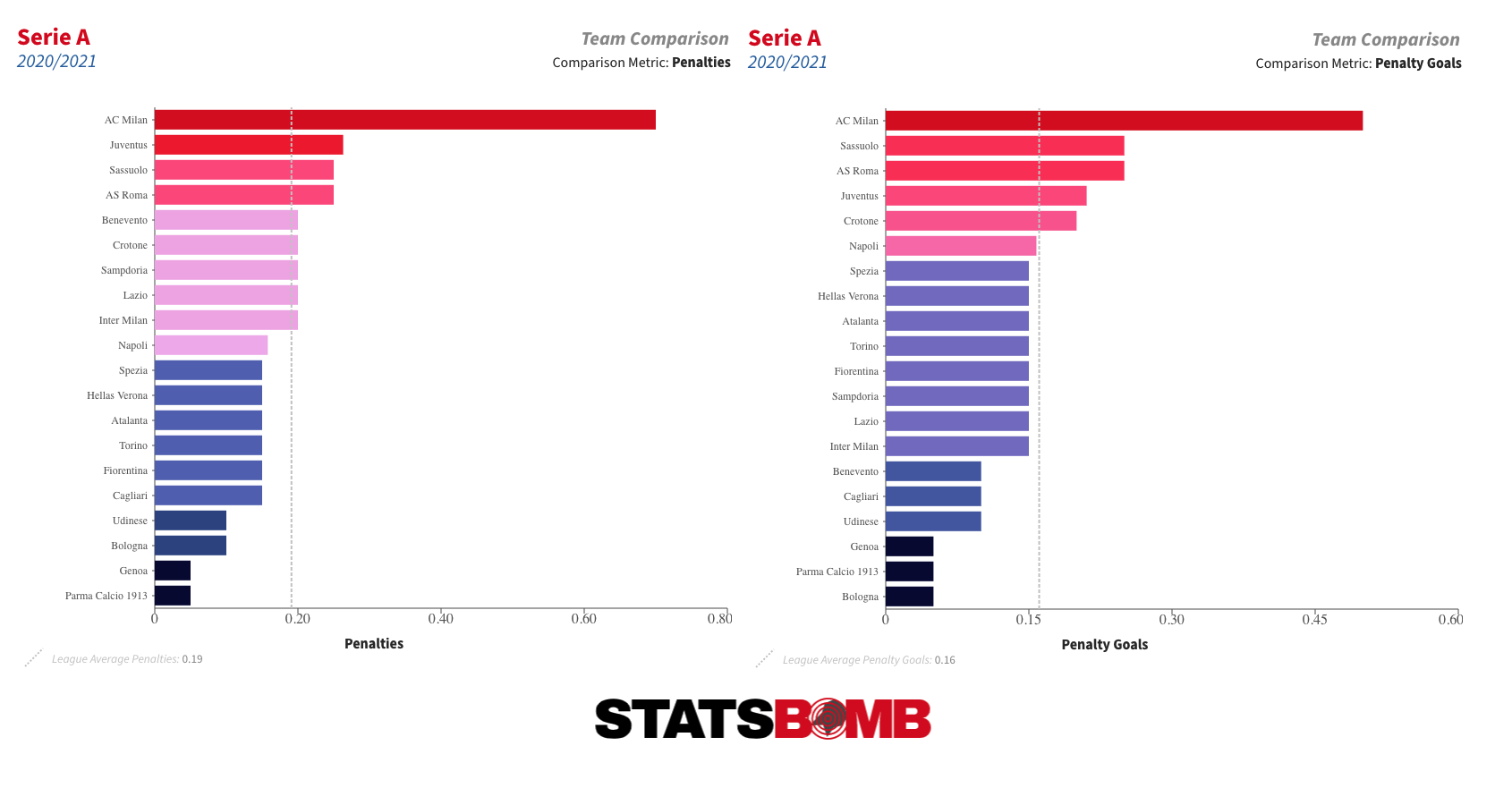
That is unlikely to hold. They’ve already been awarded six more penalties and scored two more than in the entirety of last season in a league that has actually seen slightly less penalties given this time around. The points are already on the board and this is still on course to be Milan’s best season since they finished third in 2012-13. Good recruitment work has created a squad capable of continuing this upward trend into the seasons to come. But they are arguably the most likely candidates to suffer a drop off in results from hereon out.
Lots of Goals
Serie A came flying out of the traps with an average of 3.75 goals, 3.44 non-penalty goals and 2.96 expected goals (xG) per match over the five first matchdays of the season. It was comfortably the highest-scoring of the big five leagues at that stage. That has inevitably settled down a little as the campaign has progressed and the sample size has increased. Both the underlying xG figures and the degree to which non-penalty goals are outrunning them have decreased...
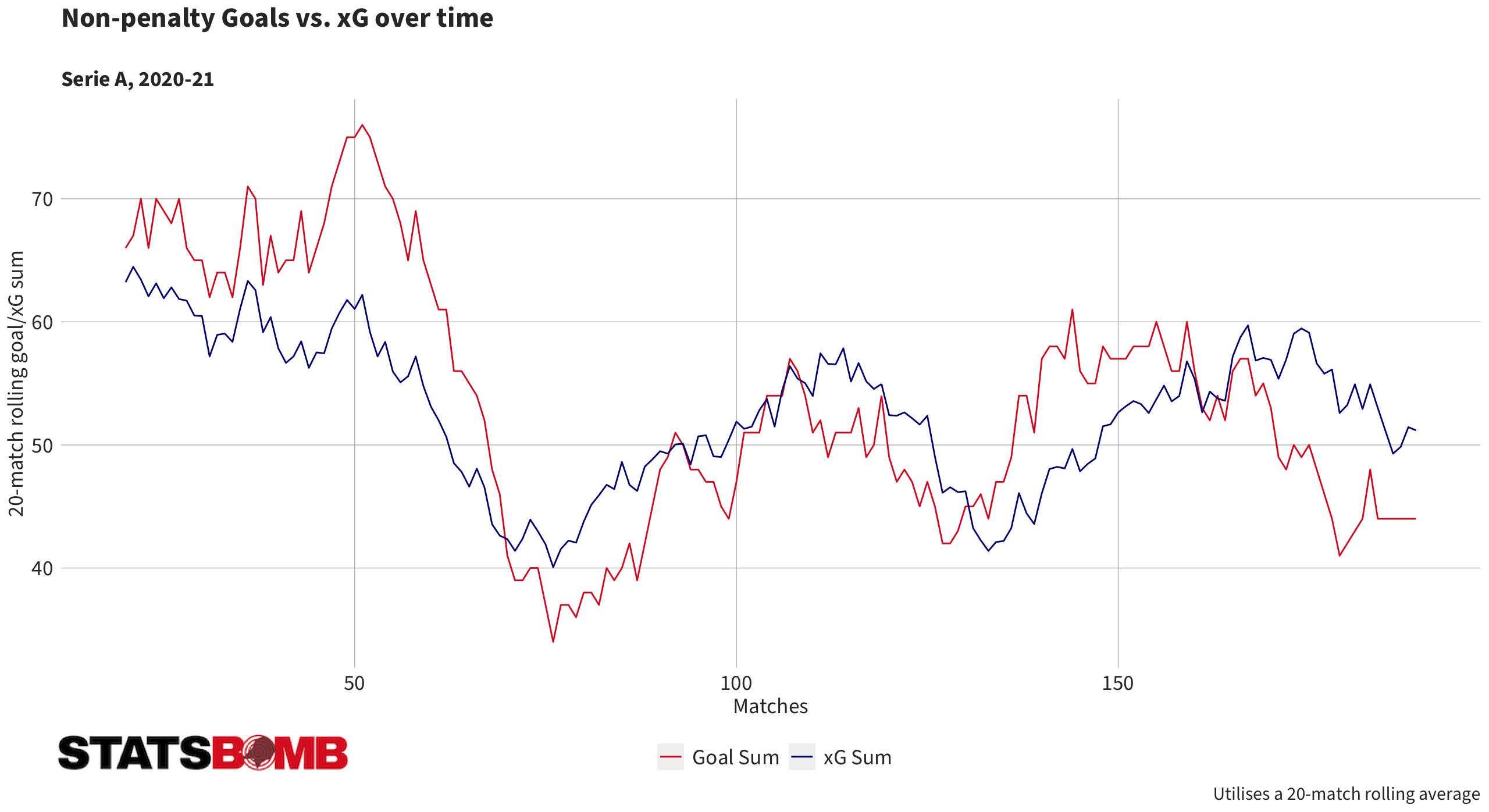
...but Serie A remains almost neck and neck with the Bundesliga as the highest scoring league by all three measures. That despite the fact that it is seeing an average of almost four less shots per match compared to last season, down from 28.15 then to 24.45 this time around. The mild increase in xG per match season-on-season has been driven by a clear increase in average shot quality, from 0.090 xG/shot last season up to 0.106 in 2020-21. That is reflected in the decrease in the average shot distance -- down from 17.28 metres to 16.29. Every single one of the 17 teams who remained from last season are taking their shots closer to goal on average.
Udinese’s xG woes
No side have underperformed their metrics to a greater extent than Udinese. Luca Gotti’s side appear well-constructed, and in Rodrigo de Paul they have a player capable of running pretty much all aspects of their attack.
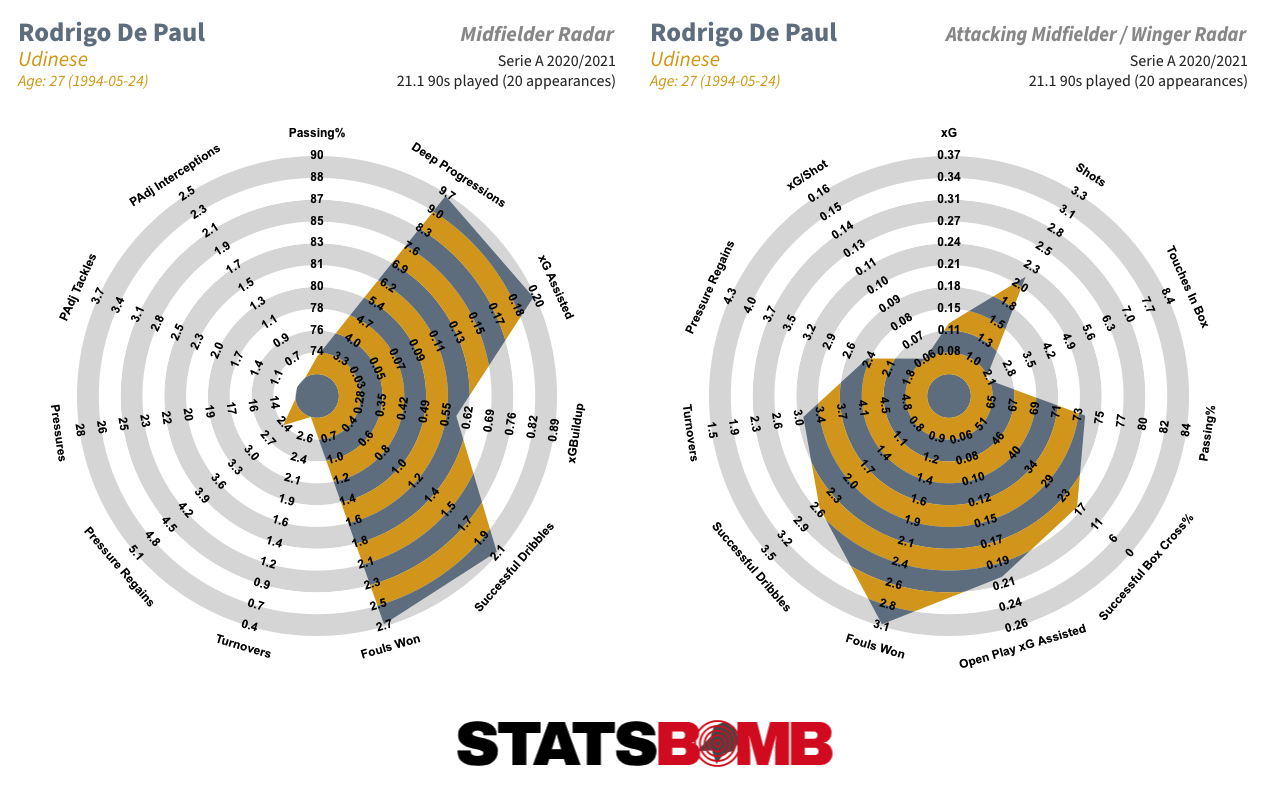
They are a top-eight side by xG difference but due to an underperformance of comfortably more than half a goal per match, they instead find themselves down in 13th, some 10 points off that mark.

That underperformance is evenly distributed between both ends of the pitch. They are just under six goals behind in attack.

And have conceded just over six goals more than expectation in defence.
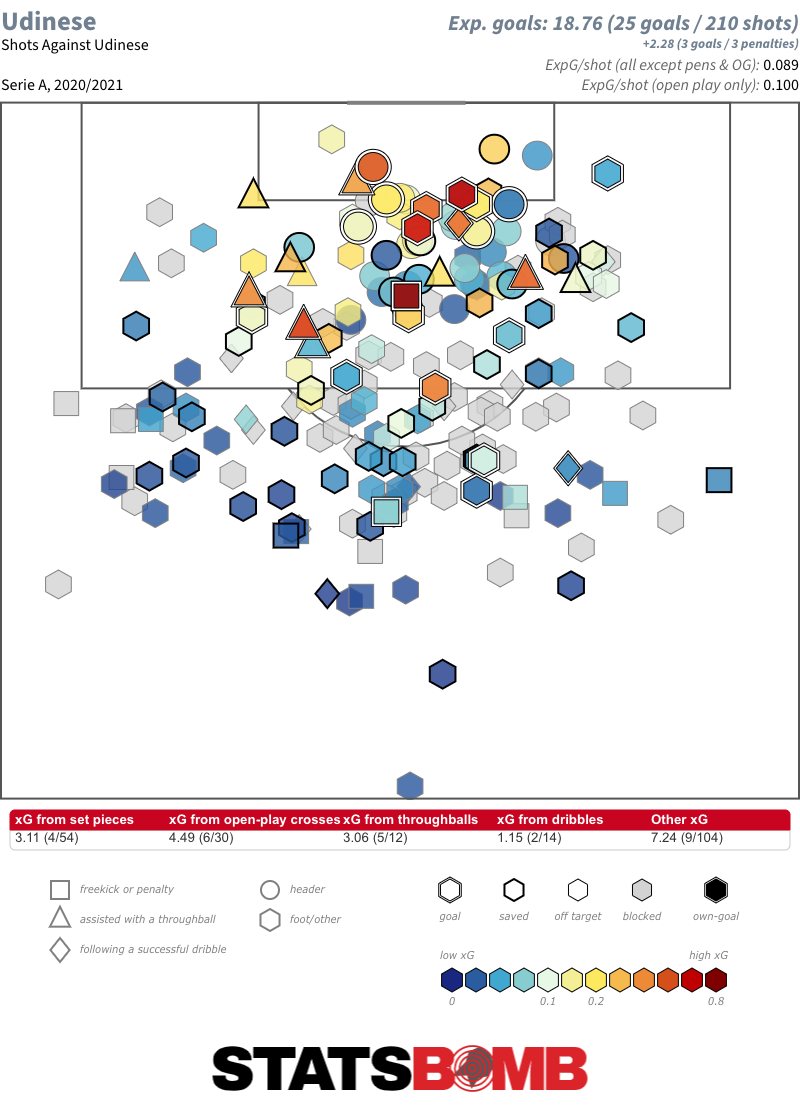
A fair amount of that attacking underperformance would appear to fall on the shoulders of one man: Kevin Lasagna. He’s been layering on the xG, only for it all to fall apart in the oven. He’s getting on the end of plenty of throughballs -- more, per 90, in fact, than anyone else in Serie A -- and into other advantageous positions, but the finishing touch has too often eluded him. He has just two goals from 7.34 xG.
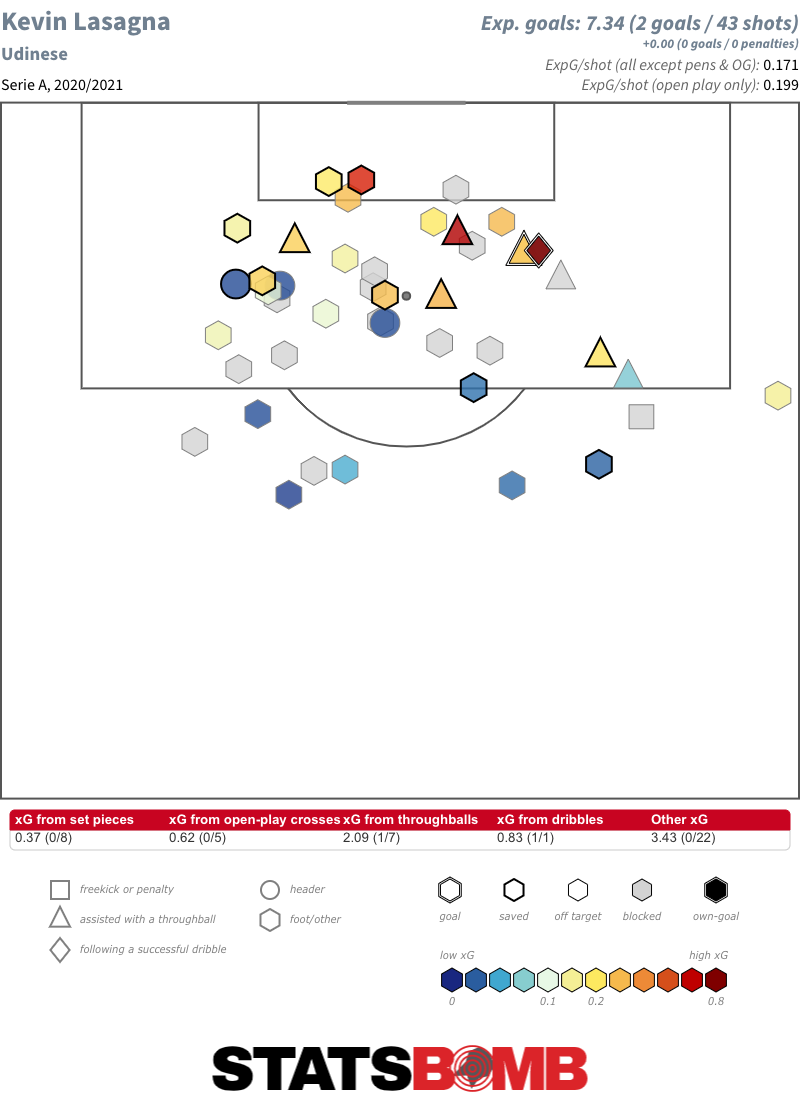
Lasagna is not a perennial underperformer. He scored pretty much exactly in line with his xG last season, and was even a couple of goals ahead in 2018-19. He is probably just going through a very unfortunate run of finishing on a side who appear to be suffering a similar fate. Udinese are more than good enough to avoid relegation troubles, and if they start performing more in line with their metrics, they might even be able to salvage a top-half finish.
Additional tidbits
- Genoa are the only side across the big five leagues to have used their entire complement of five substitutes in each and every match. That is even more remarkable given they’ve had two different coaches: Rolando Maran; then, from late December, Davide Ballardini.
- Piotr Zielinski is the nutmeg king of Serie A. The Napoli midfielder has not only completed more nutmegs in total than anyone else (8), but is also the only player among those to have played more than 900 minutes to have performed a nutmeg more than once every two matches. Achraf Hakimi of Inter Milan is next up.
Join us at StatsBomb Evolve on March 17th 2021 to discover how we are revolutionising the football data industry (once again), including the launch of our new data product, StatsBomb 360. 
As we hurtle through the midway point of this unrelenting EFL season, there's just time to quickly take stock. A top-to-bottom analysis won't be much use when it’ll all have changed within a week, so instead we’ve picked out 10 of the most interesting storylines from a typically chaotic opening half of the EFL season.
1) Swansea City Shut-Outs
Play-off semi-finalists in 2019/20, Swansea are going well once again. So well, in fact, that they’re currently on course to break a Championship record since it rebranded in 2005 for the fewest goals conceded in a league season. Preston North End’s miserly 30 concessions in 2005/06 is the yardstick to beat - The Swans’ record of 14 conceded from 25 games puts them on course.
Steve Cooper's made a clear move towards implementing a more robust defensive structure: their Aggression % - the percentage of opposition pass receipts that are tackled, fouled or pressured within two seconds – has dropped from 23% to 18%, and this new approach has paid rich dividends across every defensive metric.
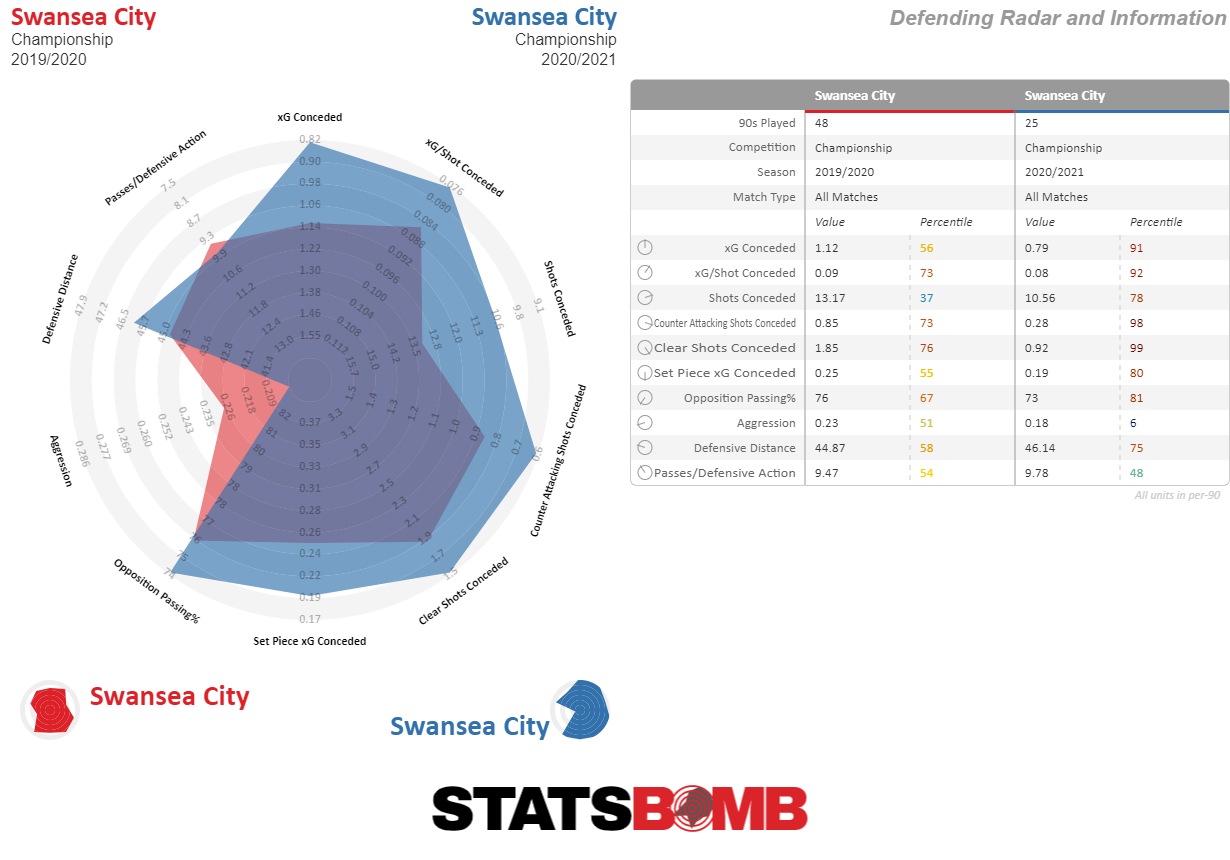
Their diligence in the defensive transition means they've conceded seven(!) counter-attacking shots all season, as well as just 22 shots that have solely the goalkeeper between ball and goal.
Simply, the team doesn’t concede valuable chances. The Swans have faced just 11 shots with an xG value greater than 0.30 all season. In laymans terms, they very rarely concede anything approaching a clear-cut chance. Such stinginess could power them all the way back to the Premier League.
2) Pressing Matters With Callum O’Hare
After a successful loan spell, securing Callum O’Hare’s services on a permanent deal was a crucial piece of summer business for newly promoted Coventry. They’ve been rewarded with an unrivalled work rate from the young attacking midfielder.
This comes as no surprise considering O’Hare led League 1 last season with a whopping 33 pressures per 90. That number is slightly down this campaign – understandable given the especially tight schedule – but relative to the Championship it’s barely noticeable. The result is that no one in the entire EFL registers more pressures per 90 than O’Hare, and in the Championship it’s not even close.
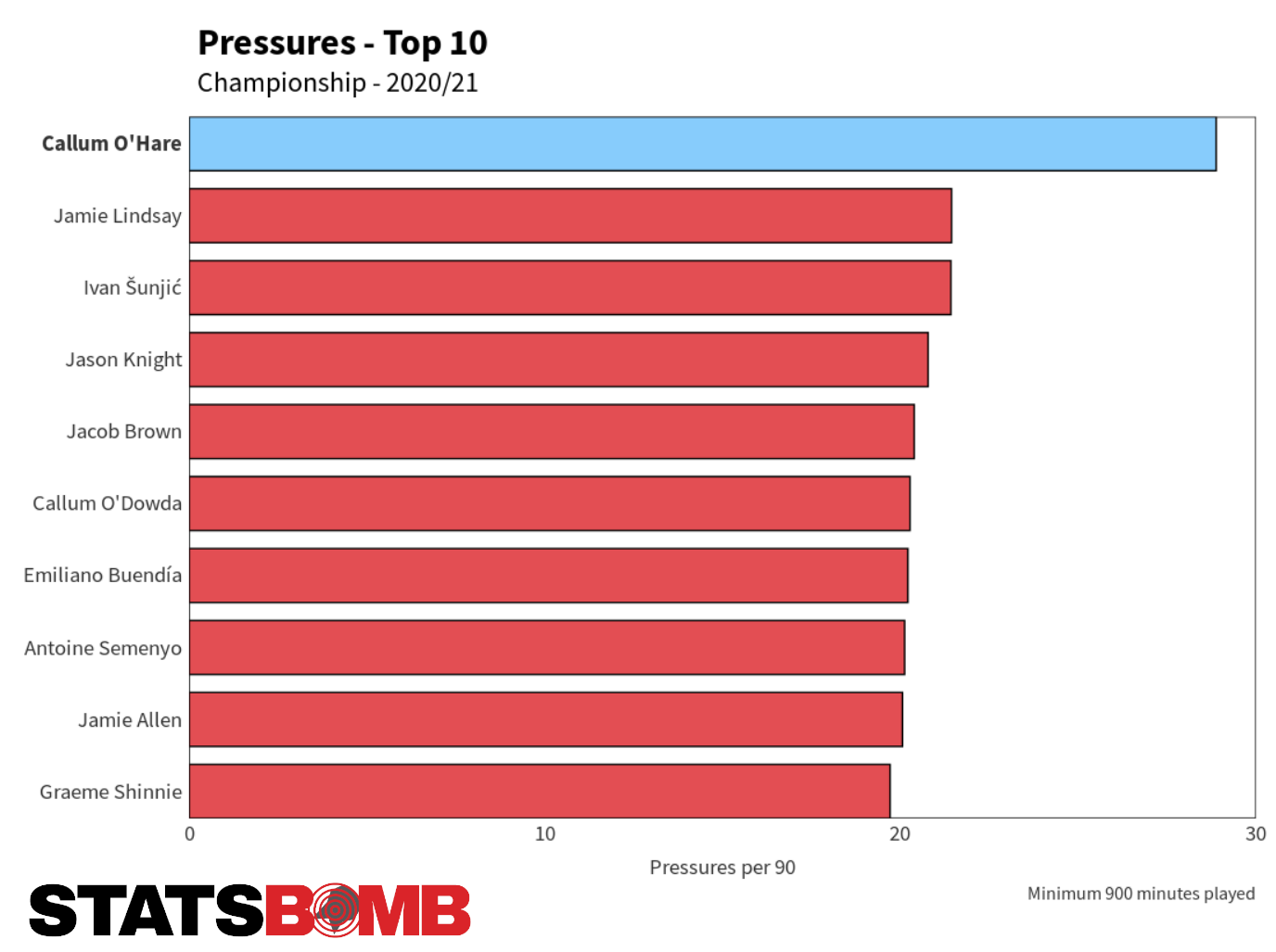
When you consider that he’s played more minutes than all-but-one of the other players in the top 10, it's even more impressive. The prolonged off-season Coventry enjoyed compared to their Championship rivals is certainly paying off for both O’Hare and the Sky Blues.
3) Has ‘The Beast’ Unlocked a New Level of Physical Dominance?
It was a different world when Adebayo Akinfenwa last appeared on the StatsBomb site back in October 2019. At that stage there was one unknown and one unlikely: the unknown was whether then-37-year-old Akinfenwa would continue playing this season, the unlikely was that Wycombe would secure promotion to the Championship for the first time in their history.
Fast-forward and here we are, with both Akinfenwa and Wycombe playing at Championship level for the first time. Bayo was never likely to turn down the opportunity to go to war with Championship centre backs, having bullied their League One and League Two counterparts in his career up to now.
Last season in League One he managed 9.7 aerial wins per 90, league-leading for players with more than 1200 minutes, but this season he’s taken that aerial dominance to a new level despite the rise in class, in what is a notoriously physical league in the Championship. His current rate of 14.6 aerial wins per 90 is the best in England’s top four divisions.
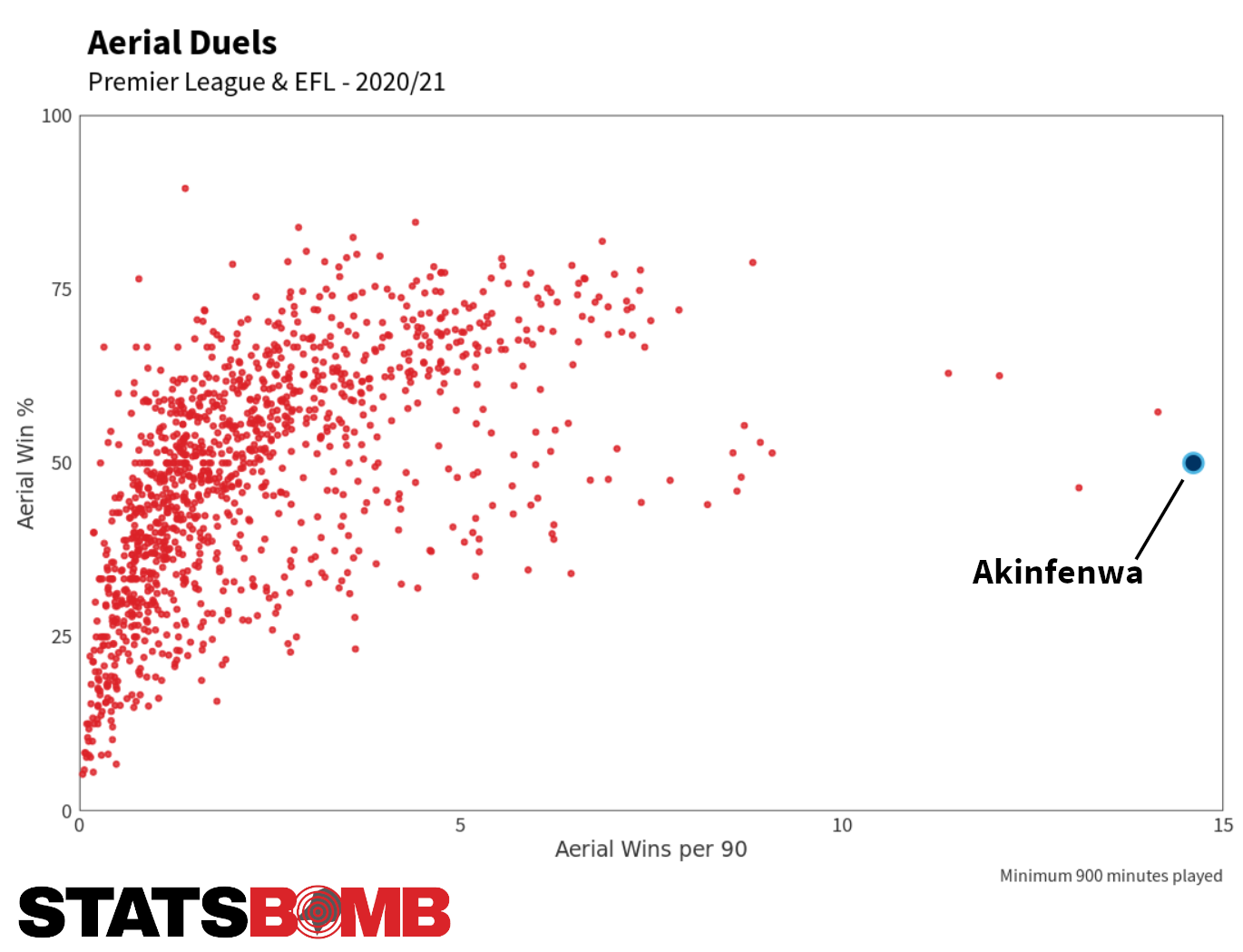
Wycombe’s not-so-secret weapon continues to provide a valuable outlet for them in making the ball stick up front. Can they and Akinfenwa together pull off an unlikely survival in the second half of the season?
4) MK Dons: Camped In Enemy Territory, But Defensively Exposed
Into League One now where MK Dons have caught the attention of the EFL audience for their possession-based style of play. They’ve gained a lot of plaudits for their ability to control the territory but, whilst being easy on the eye, they’ve struggled to convert this dominance into points, currently sitting 16th with a return of 28 points from 24 games.
There’s a real dichotomy between the process and the outcomes at Stadium MK. The Milton Keynes based side, with 52.8 Deep Progressions per 90, enter the opposition’s final third more often than any other team in League One and, once they’re there, they’re also completing more passes within 20m of goal than any other side, completing 6.4 Deep Completions per 90. However, this dominance isn’t translating into shots or good chances on goal: the Dons rank 13th in League One for both shots and expected goals created.
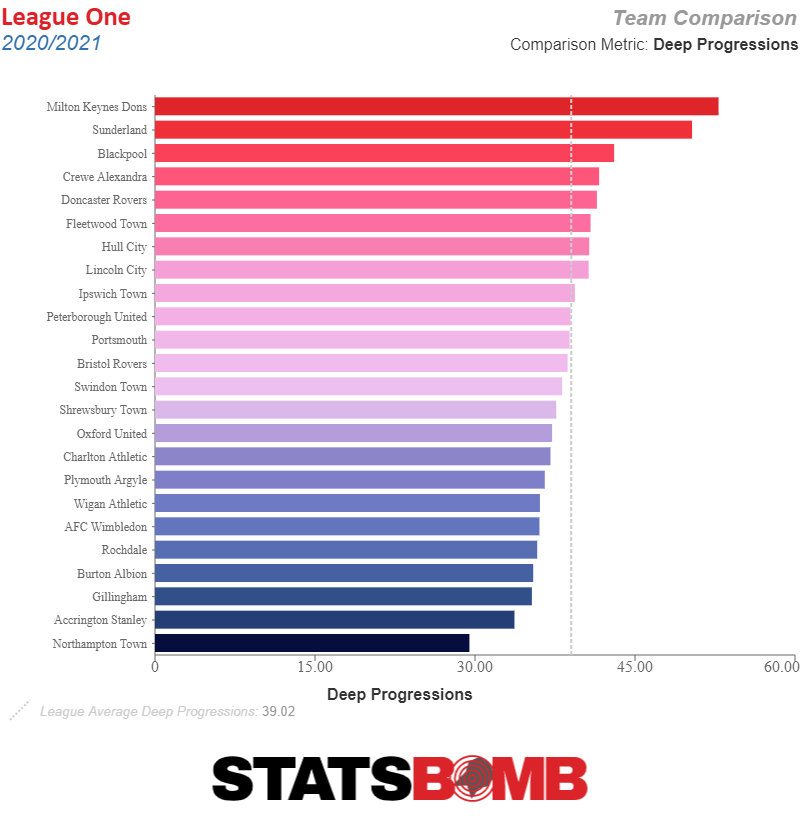
It’s a similar story at the back. MK are behind only Sunderland for both final third entries conceded and Deep Completions conceded. It’s only a good thing that the opposition are spending so little time in threatening positions, but the issue is what happens when they do break into MK Dons territory - find space and cause a lot of damage. MK’s xG per shot conceded of 0.13 is the worst in the league.
5) Josh Emmanuel: Full Back Attack
There are many great sights within the beautiful game. Surely one of the best is a player carrying the ball with power and dribbling at speeds the casual spectator could only dream of. When it comes to seeing this in the EFL, Josh Emmanuel is a stand out.
Flying up and down the wing was something Emmanuel could have done in a completely different sport having been offered trials at Saracens in Rugby Union as a youngster, but it’s now on Hull City's right flank where Emmanuel’s heels are shredding turf.
Emmanuel’s average carry length is currently the fifth-longest amongst other League One full backs and wing backs, but he’s a much more dependable outlet than those above him. His 38.7 Carries per 90 is by far the most of that group, and completed at a higher percentage than his competition too.

It’s not just carrying into space that he thrives in, he’s capable of taking the ball past an opponent too. Emmanuel’s completed the most dribbles of League One full backs this season and was behind only two others in 2019/20. This on-ball capability makes him a key player in the attacking phase of Hull’s game: making the second-most final third entries of his side, the third-most passes into the box, and has the third-highest xG assisted from open play.
6) Chuks Aneke: Bench Warmer, Ice Cold Finisher
A hark back to the good old days of sub-effects now.
Chuks Aneke is excelling in the role of super-sub this season. The Arsenal academy graduate has played in 20 of Charlton’s 25 games so far but made only seven starts to accumulate a total of 999 minutes - just 40% of the minutes available.
And yet…
Aneke has been absolutely smoking tired League One defences this season. Of his nine goals, just three have come in matches he’s started, the other six have come when being deployed from the bench. When he starts he scores at a rate of 0.52 goals per 90, when he comes off the bench it's 1.12 goals per 90.
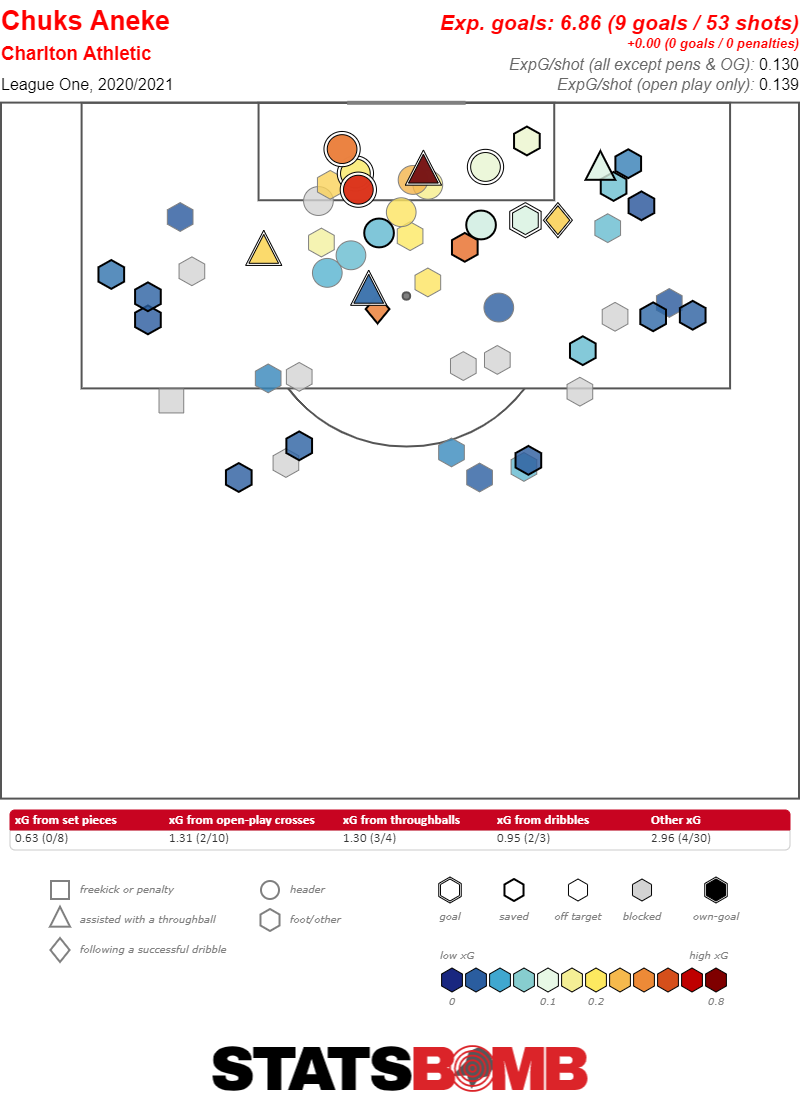
The sub-effects are real but that’s not to downplay his impact. Aneke is objectively (and subjectively) putting in some of the best forward performances in the league. Ignoring his monumental return off the bench, his contribution of 0.52 goals per 90 from the start would be the 5th best return in League One. All in, for players with at least 900 minutes played this season, Aneke is tops the league for all of Shots per 90, xG per 90, and goals per 90.
7) Max who? Max Watters
There's only one place to start in League Two and that's with probably the story of the entire EFL season up to now. Released by League One Doncaster after five forgettable appearances, Max Watters rocked up at Crawley Town in October to little fanfare, having only been spotted by the Crawley staff when playing against them in a friendly for non-league Maidstone United where he was on trial.
Three months, 15 appearances and 13 goals later, Watters was off to Cardiff City in the Championship for a reported seven-figure fee.

Watters was a touch ahead of his expected goals, notching his 13 goals from 8.1xG, but he repeatedly showed a nose for getting into good goalscoring positions and finishing in a variety of ways too - scoring with his left foot, right foot, or head - and with little-to-no wastage whatsoever in his shot selection. His rate of 1.06 goals per 90 was so extreme that it was nearly half-a-goal better than the next best record in League Two, and his 0.66 xG per 90 was also a clear standout ahead of the rest.
Just three months of very successful League Two football was enough to persuade Cardiff to give him an opportunity in the Championship. Returns like the ones he was making at Crawley would make the fee an absolute bargain.
8) Sunshine and Beechball in Cumbria
There were no signs in Carlisle’s unremarkable 2019/20 campaign to suggest they'd embark on a promotion push just months later, but here we are. With no discernible improvement in results, the November 2019 appointment of Chris Beech went largely under the radar last season, but behind the scenes foundations were being laid.
This season has seen a move to a style of play that pundits have christened “Beechball” – an energetic, high pressing and direct game that has brought praise for both its entertainment and its efficacy, with the Cumbrians currently top of the table by points per game.
Last season most of Carlisle’s defending was done in their own half, but this season they’re active much further up the pitch: their Defensive Distance – the average distance from a team’s own goal that it makes defensive actions – has shifted from 41.2 metres, 23rd in 19/20, to 47.4 metres, 1st in 20/21. It’s working too – Carlisle are conceding the fewest shots in the league.
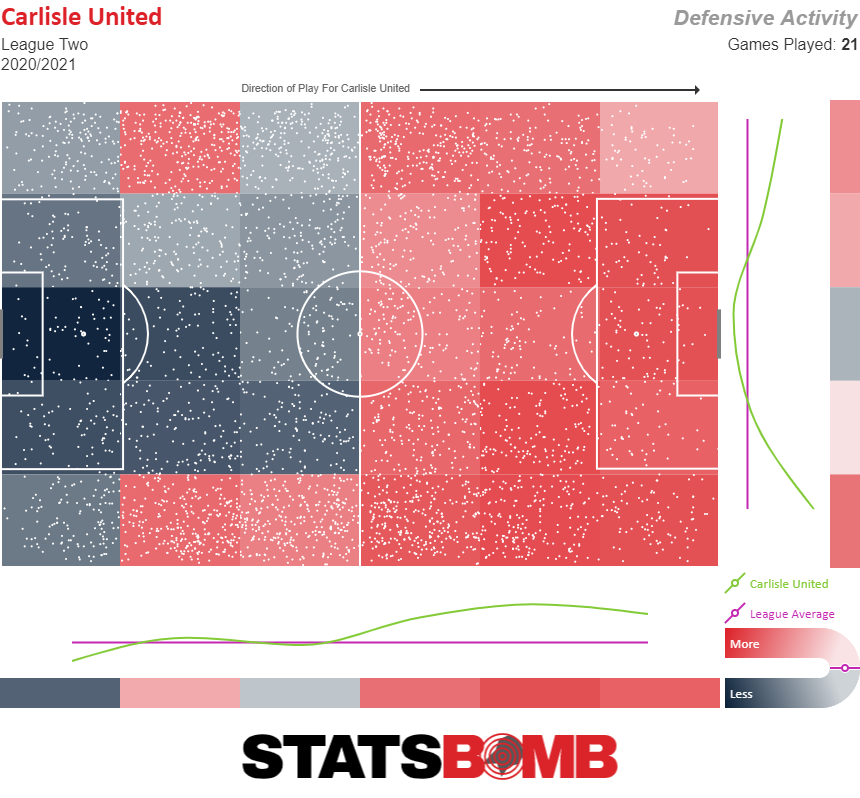
They’re also thriving in possession and pose a well-rounded threat. An average of 17.5 shots per game is the most in the league and three more than next best Newport County, and they’re generating opportunities from all phases of play. Carlisle rank 1st for counter attacking shots, illustrating their speed and threat in transition, but also rank 1st for set piece xG, with 0.48xG per 90. Significant output in this area could go a long way to helping their promotion push – creating half-a-goal a game from set plays, extrapolating to 23 goals over a full season, is a juicy cherry to put on top of the open play cake.
Even within set plays they’ve got all bases covered, creating regular chances from corners, indirect free kicks, and throw ins. The latter has been particularly noteworthy with winger Josh Kayode catapulting projectiles into the opposition penalty box at every available opportunity.
9) The Second Best Attack In The Country
Across England’s top four divisions, Exeter are second only to Liverpool for goals scored per 90 and xG created per 90. By xG per shot, they rank top.
Given the competitive balance in League Two, it’s a big surprise to see a team putting up numbers of that scale, particularly one that currently sits 9th in the table. The Devon-based club have implemented a style of play under manager Matt Taylor that sees them look to enter the box from high-value areas rather than playing into it from deeper positions. Almost all of their box entries have come once they have possession in the final third.
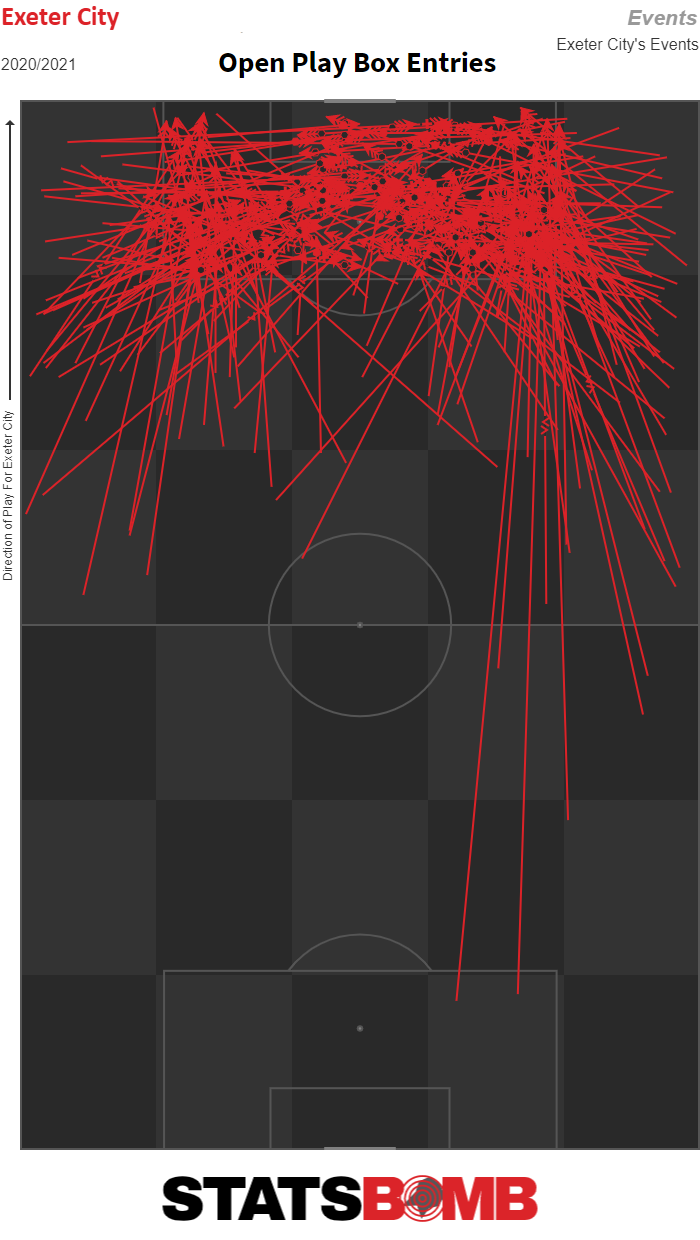
Watch an Exeter game this season and you’re guaranteed to see the ball being flashed across the face of goal or pulled back towards the penalty spot again and again.
The optimal execution of this strategy came in their November fixture at home to Colchester United, who had no answer for Exeter’s relentless probing of their penalty area. All six of Exeter’s goals that day came from within the six yard box and – typical manager interview cliché incoming – it really could’ve been even more.

A case of blatant stat-padding, but even excluding that game Exeter still rank first in League Two for both xG created and xG per shot. Maintaining this level of creativity could see them go one better than last season’s play-off final defeat.
10) Lionel Wessi Seeing Out His Career In Cambridge
Contrary to Exeter, Cambridge take a slightly different approach to progressing the ball and getting into the opposition area. A strategy that makes total sense when you have a player of Wes Hoolahan’s – Lionel Wessi’s - skillset in your ranks.
The U’s, top of the league at the time of writing, are much more inclined to take a vertical approach through the centre of the pitch and Hoolahan’s driving runs and subsequent through balls have become a common sight at the Abbey Stadium. Even at 38, the class and quality that earned him over 100 Premier League appearances whilst at Norwich are still obvious and a major asset to Cambridge’s attacking game. You can pick out Hoolahan’s trademark slide passes through gaps in the opposition defence when looking at his open play passes into the penalty box.

The creative spark in the midfield, on a per 90 basis Hoolahan ranks top in League Two for Carries of the ball and more importantly through balls, providing a high-class link between the middle and final third.
11) Bonus Nutmegs
Lastly, a small, nutmeg-flavoured palate cleanser now we’re at the end. Here's the top five Nutmeggers and Nutmegees of the 2020/21 EFL season. Enjoy.
Player |
Club |
Competition |
Nutmegs |
| Antoni Sarcevic | Bolton Wanderers | League Two | 8 |
| Adam Armstrong | Blackburn Rovers | Championship | 7 |
| Siriki Dembele | Peterborough United | League One | 6 |
| Scott Sinclair | Preston North End | Championship | 6 |
| Conor Wilkinson | Leyton Orient | League Two | 6 |
Player |
Club |
Competition |
Nutmegged |
| James Brophy | Leyton Orient | League Two | 5 |
| Emiliano Buendía | Norwich City | Championship | 4 |
| Oliver Rathbone | Rochdale | League One | 4 |
| Josh Laurent | Reading | Championship | 4 |
| Nathan Byrne | Derby County | Championship | 4 |
Join us at StatsBomb Evolve on March 17th 2021 to discover how we're going to change the football industry, including the launch of our new data product, StatsBomb 360. To find out more, click here.
Palmeiras and Santos meet in the famous Maracaña stadium in Rio de Janeiro on Saturday in the final of the Copa Libertadores. The two Brazilian teams, both from São Paulo, have a number of interesting players, and here are some to watch out for in the final of South America’s primary club competition.
Rony, Palmeiras
Rony has been Palmeiras’ most productive attacker in their Libertadores campaign, scoring five goals (including one penalty) and providing seven assists. Abel Ferreira’s team take full advantage of opportunities to attack in transition and Rony, fast and direct in all of his actions, plays a key role in the final stages of those attacks. 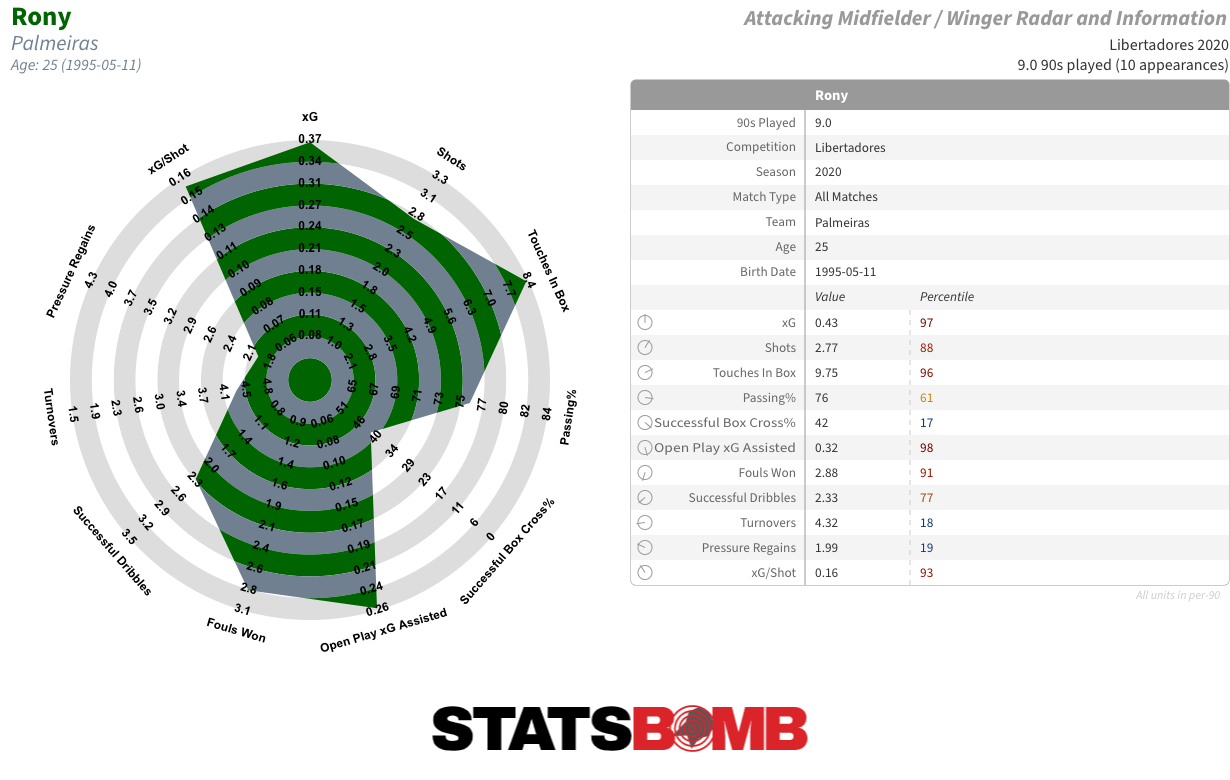 The 25-year-old stood out at Athletico Paranaense last season for the quantity of shots he both created and took, and he has repeated that production at Palmeiras. Not only that, but he has significantly improved his shot locations, taking fewer long-range efforts and more from inside the six-yard box, while also benefiting from an increased throughball supply.
The 25-year-old stood out at Athletico Paranaense last season for the quantity of shots he both created and took, and he has repeated that production at Palmeiras. Not only that, but he has significantly improved his shot locations, taking fewer long-range efforts and more from inside the six-yard box, while also benefiting from an increased throughball supply. 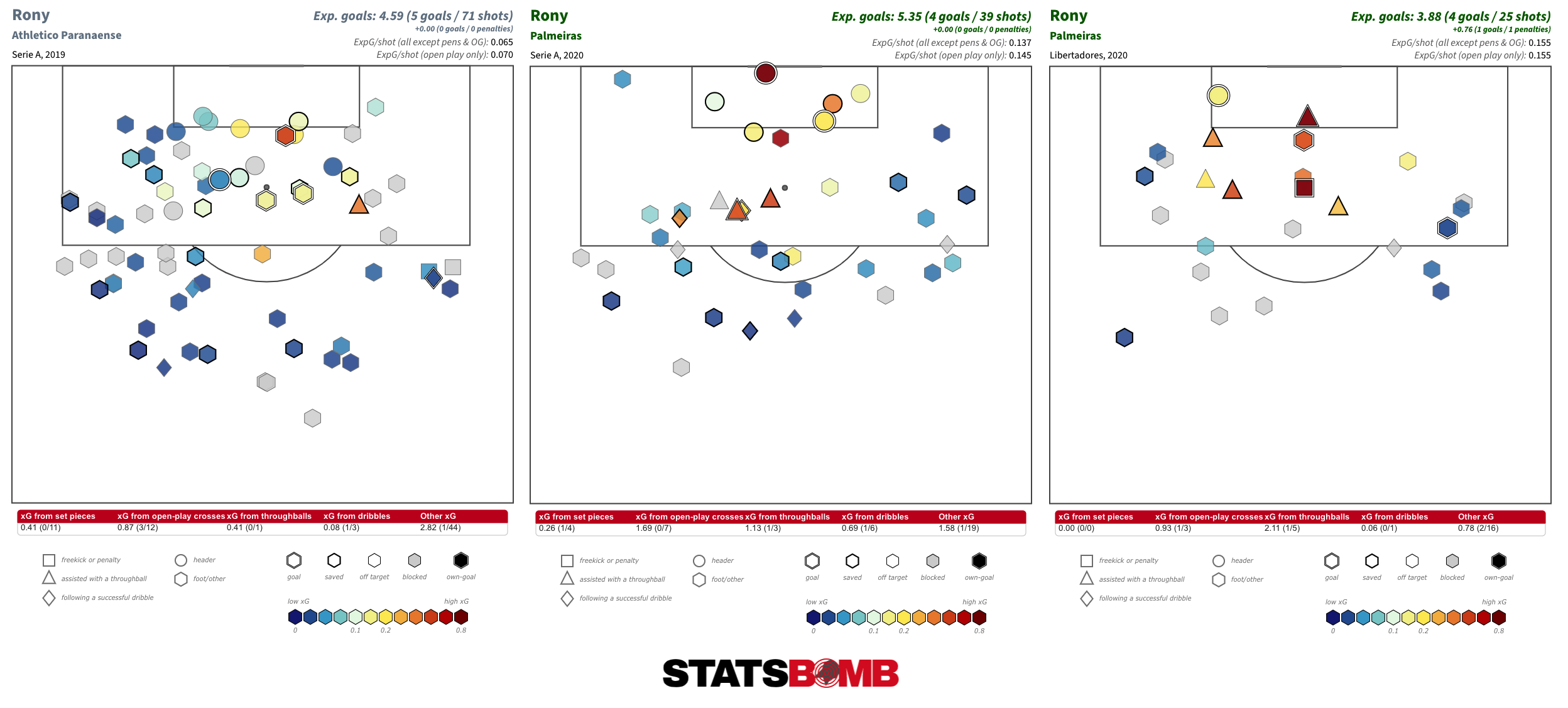 Rony is capable of playing on either side of the attack as well as through the centre, as he has done on occasion this season. With or without the ball, he aggressively attacks the penalty area. Only two wingers in the Brazilian top flight, Serie A, touch the ball there more often. Ferreira has a potent attack, with the former Shakhtar Donetsk striker Luiz Adriano at its centre and Willian, Raphael Veiga and the young Gabriel Veron as additional options in the wide positions. Some of them may have had better league seasons, but there can be no doubting that Rony has been the star of the Palmeiras attack in the Libertadores.
Rony is capable of playing on either side of the attack as well as through the centre, as he has done on occasion this season. With or without the ball, he aggressively attacks the penalty area. Only two wingers in the Brazilian top flight, Serie A, touch the ball there more often. Ferreira has a potent attack, with the former Shakhtar Donetsk striker Luiz Adriano at its centre and Willian, Raphael Veiga and the young Gabriel Veron as additional options in the wide positions. Some of them may have had better league seasons, but there can be no doubting that Rony has been the star of the Palmeiras attack in the Libertadores.
Yefferson Soteldo, Santos
Yefferson Soteldo is the key player in the Santos attack. He is at the centre of their ball progression in the attacking half... 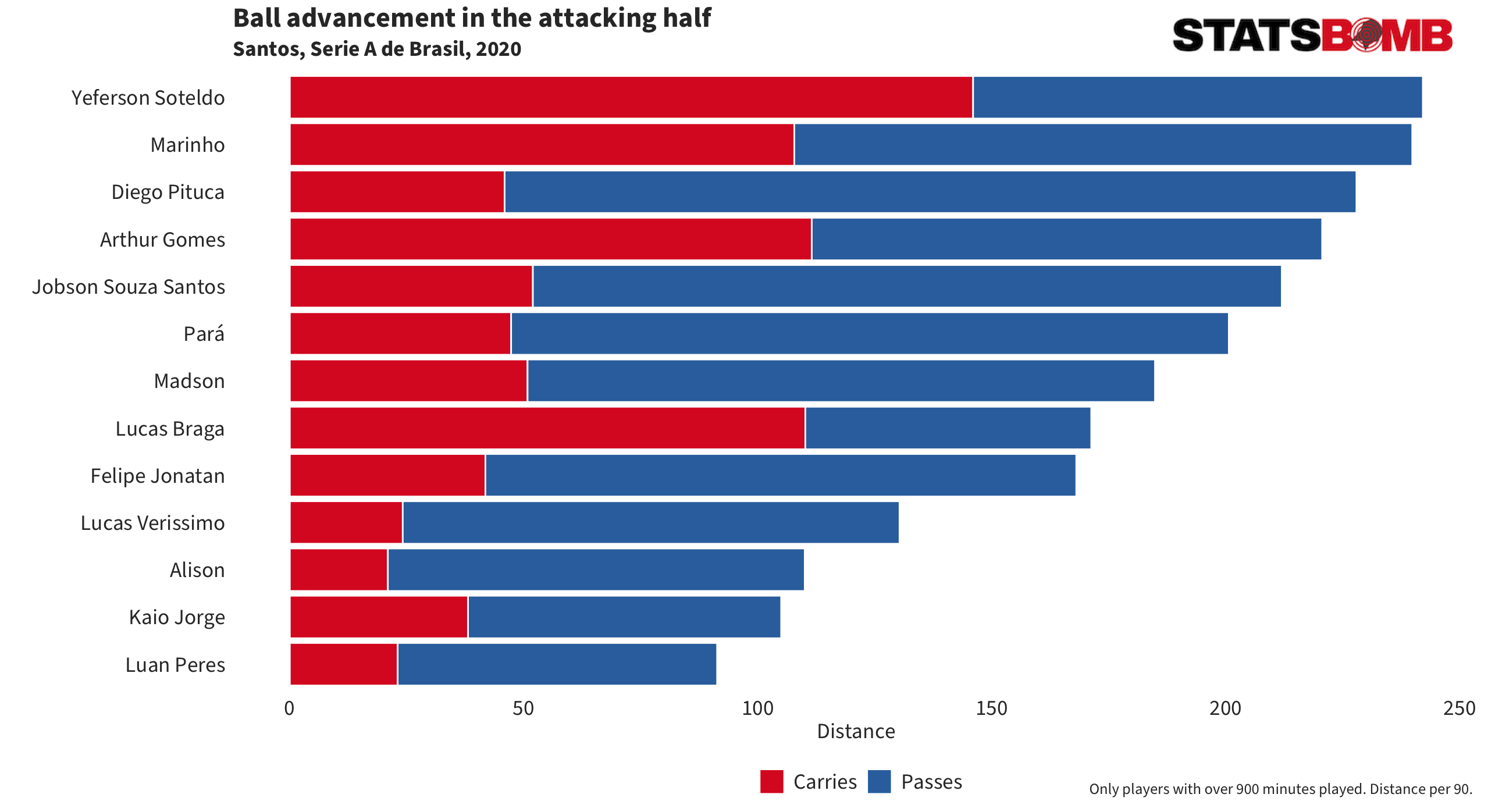 ...he creates more chances than anyone else...
...he creates more chances than anyone else... 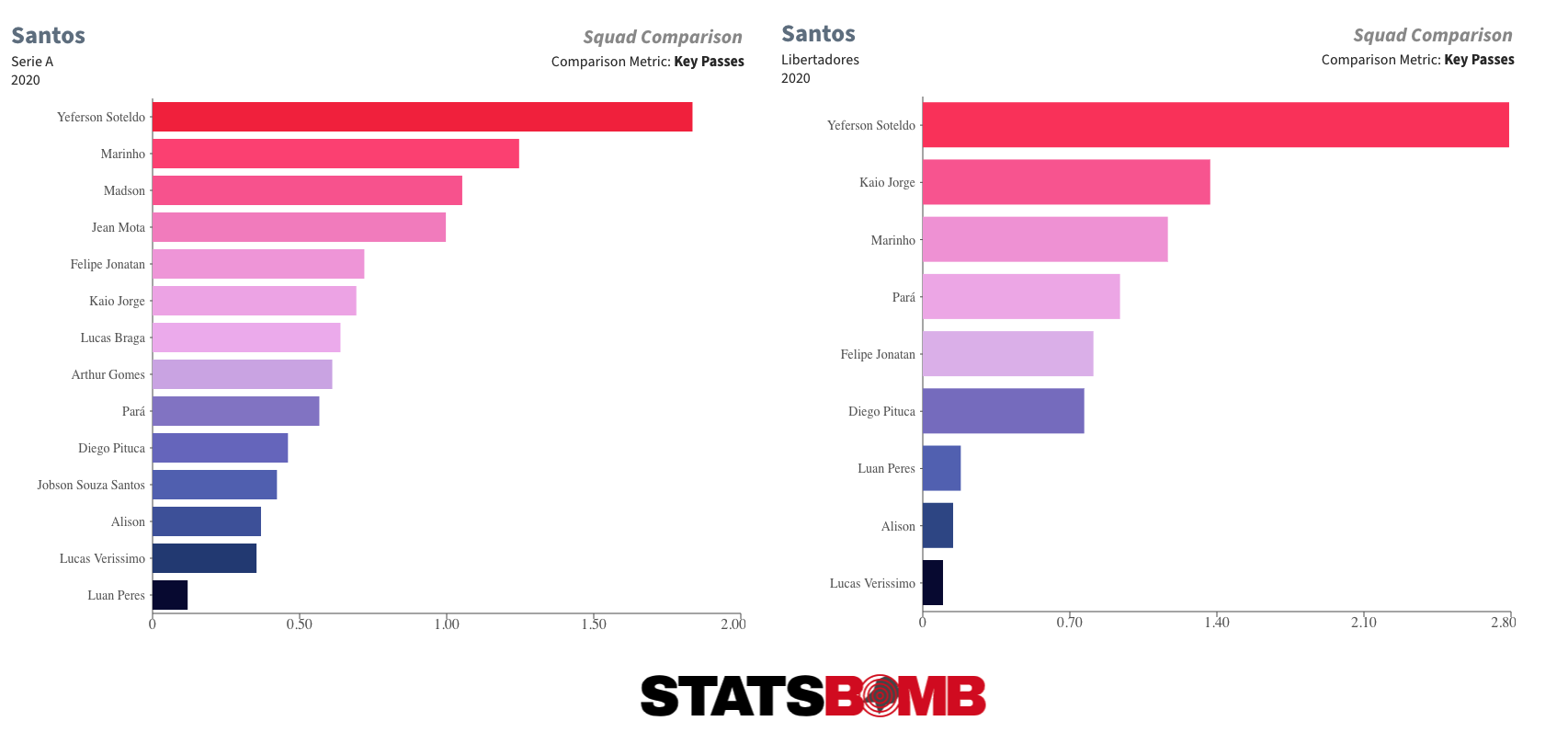 ...and he even gets himself on the scoresheet sometimes, too, as he did in the return leg of the semi-final against Boca Juniors.
...and he even gets himself on the scoresheet sometimes, too, as he did in the return leg of the semi-final against Boca Juniors.  The pint-sized Venezuelan doesn’t stand out for his ability to break defensive lines with his passing. Amongst all the attacking midfielders and wingers of Serie A, he ranks among those who least often pass the ball forward, both in general and in the final third. But when there is space to attack or when he creates space off the dribble, he is the accelerator of his team’s attacks, driving forward purposefully with the ball at his feet.
The pint-sized Venezuelan doesn’t stand out for his ability to break defensive lines with his passing. Amongst all the attacking midfielders and wingers of Serie A, he ranks among those who least often pass the ball forward, both in general and in the final third. But when there is space to attack or when he creates space off the dribble, he is the accelerator of his team’s attacks, driving forward purposefully with the ball at his feet. 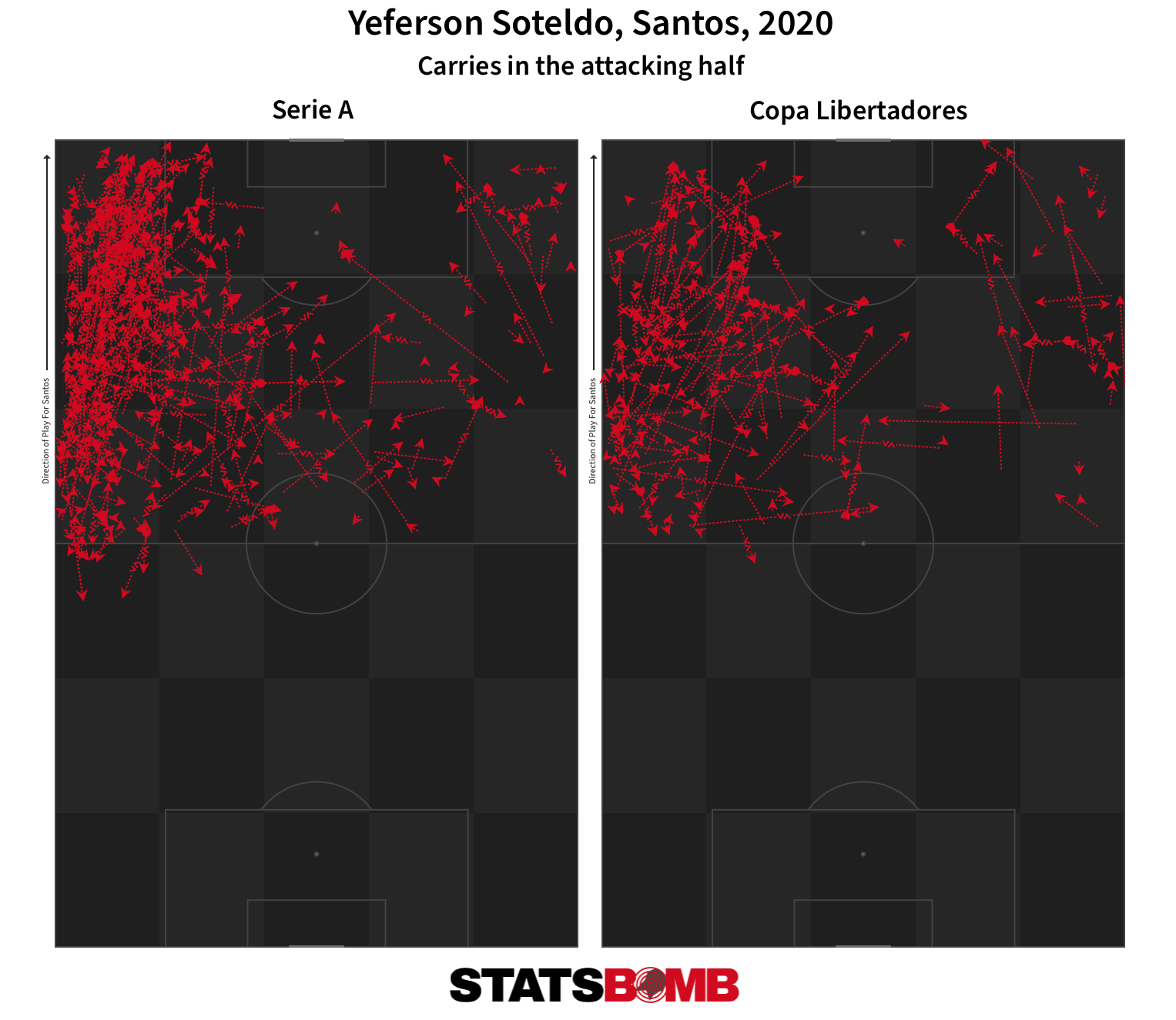 At an individual level, Soteldo is Santos’ most important player. If he plays well on Saturday, their chances of lifting the Libertadores trophy will be greatly increased.
At an individual level, Soteldo is Santos’ most important player. If he plays well on Saturday, their chances of lifting the Libertadores trophy will be greatly increased.
Gabriel Menino, Palmeiras
Among the primary draws of the Libertadores is that it is a competition studded with ascendant stars, and few enjoyed as ascendant a 2020 as Gabriel Menino. He made his first team debut in January, quickly established himself as a regular starter and was then called up to the Brazil national team in September. Now, after a standout performance in the first leg of the Libertadores semi-final against River Plate, he has the chance to continue his upward momentum in 2021. Menino played as a midfielder in the Palmeiras youth teams, and although he has shown himself to be a versatile player in the first team, playing at full-back, in central midfield and even as an attacking midfielder, he interprets every position in pretty much the same way. National team coach Tite considers him an interesting option at right-back precisely because of his natural inclination to step infield and join the midfield line. The 20-year-old is not especially quick but he does have the necessary strength and technical ability to retain possession under pressure and free himself of his marker to advance the ball via passes or carries. In Serie A, where we have a bigger sample size, he has an important role in progressing the ball forward inside the attacking half, something that is also reflected in a smaller sample in the Libertadores. 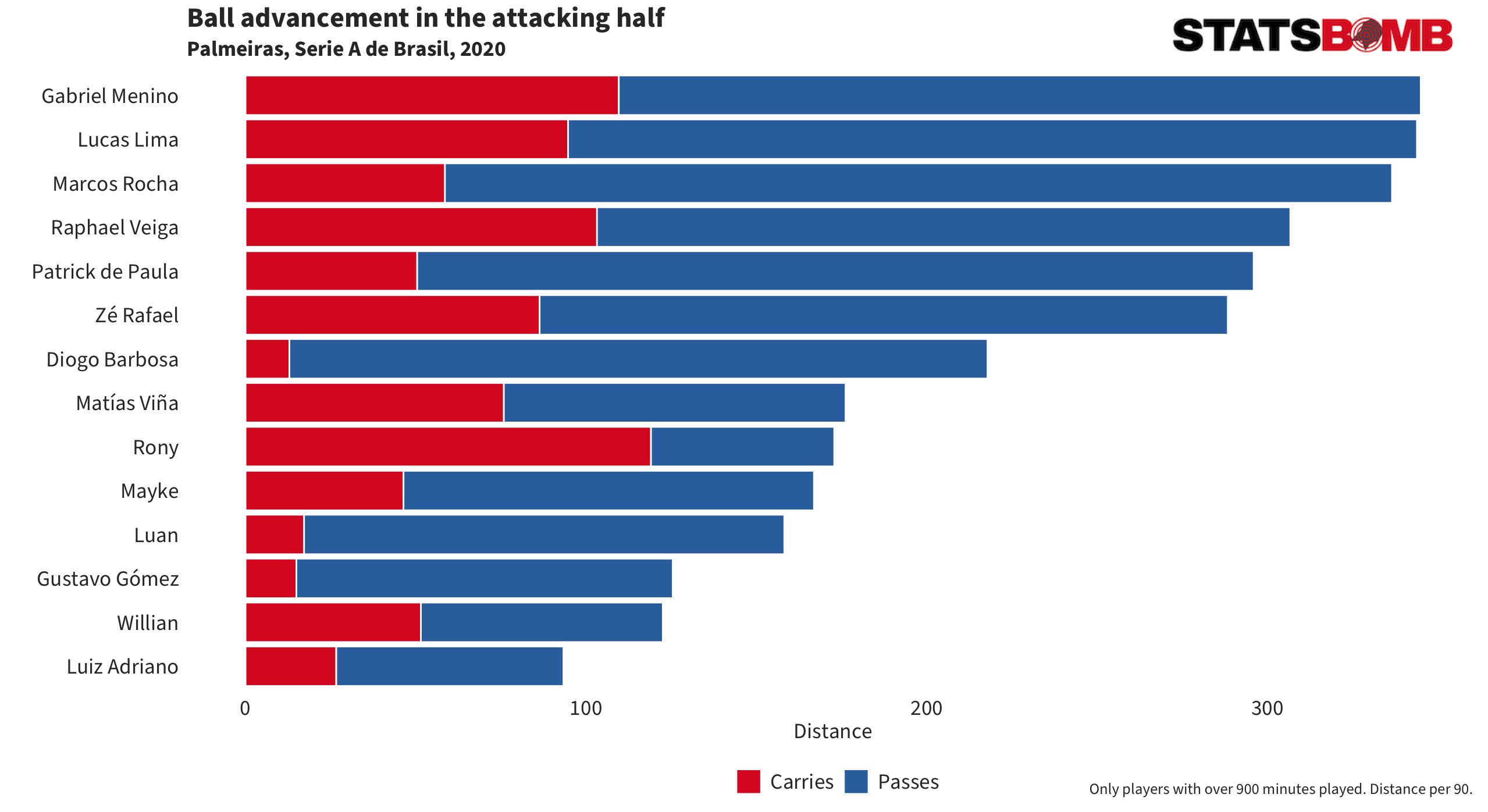 Menino also provides some output in the final third, with between 2.5 and 2.8 shots and key passes per 90 between the Libertadores and Serie A -- solid figures given the amount of minutes he has played at full-back in both competitions.
Menino also provides some output in the final third, with between 2.5 and 2.8 shots and key passes per 90 between the Libertadores and Serie A -- solid figures given the amount of minutes he has played at full-back in both competitions.
Marinho, Santos
Marinho is a wide forward by trade, but he is Santos’ primary shot-taker. 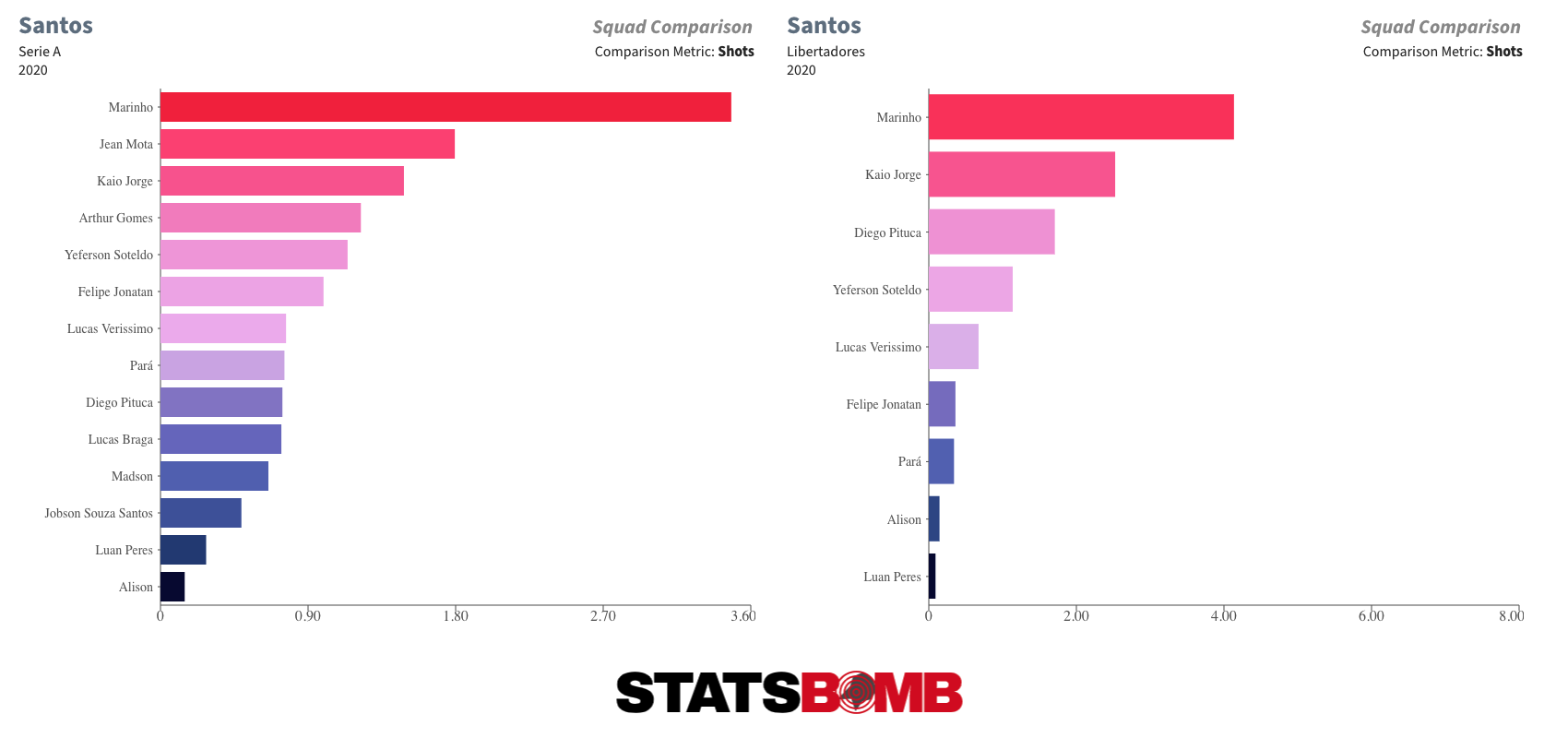 Eighteen-year old Kaio Jorge has a more collaborative and supporting role in the centre of the Santos attack -- although he has been more active inside the penalty area during the Libertadores run than he has in the Brazilian league -- and Marinho is the player who takes most advantage of the space created by his movement, cutting in diagonally from the right flank to get off shots.
Eighteen-year old Kaio Jorge has a more collaborative and supporting role in the centre of the Santos attack -- although he has been more active inside the penalty area during the Libertadores run than he has in the Brazilian league -- and Marinho is the player who takes most advantage of the space created by his movement, cutting in diagonally from the right flank to get off shots. 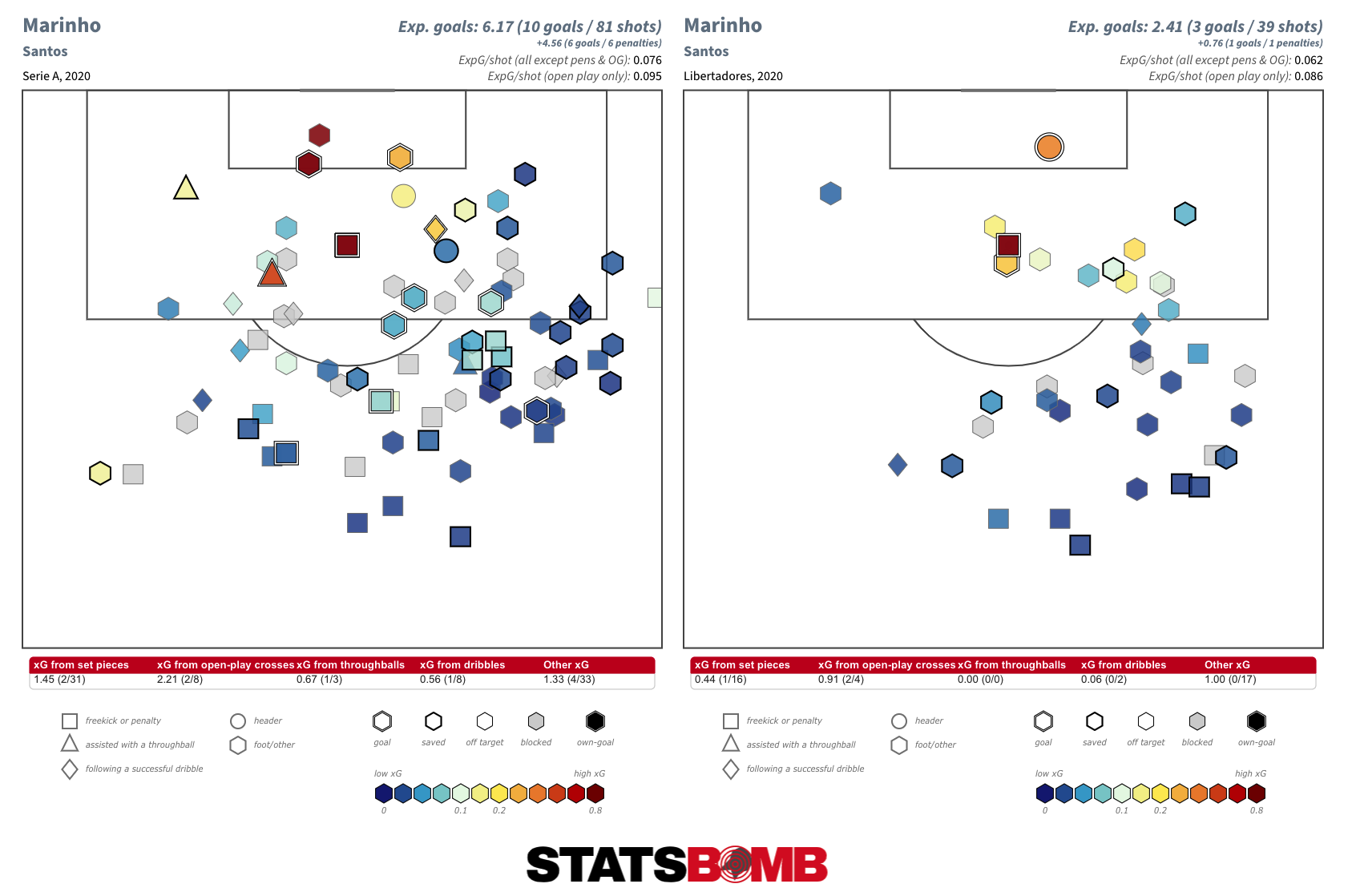 His shot locations do leave something to be desired. If he were still a young player with an opportunity to move on to Europe, it would be something to be worked on and refined. As it is, with a total of 13 non-penalty goals across the Libertadores and the league, the 30-year-old is in the best form of his career. At this stage, he likely is what he is, and this season it is definitely working out for him. Marinho is not an especially efficient player, but he is very active inside the final third and could have a decisive role to play in Saturday’s final.
His shot locations do leave something to be desired. If he were still a young player with an opportunity to move on to Europe, it would be something to be worked on and refined. As it is, with a total of 13 non-penalty goals across the Libertadores and the league, the 30-year-old is in the best form of his career. At this stage, he likely is what he is, and this season it is definitely working out for him. Marinho is not an especially efficient player, but he is very active inside the final third and could have a decisive role to play in Saturday’s final.
Fraser Forster in 2016.
The first player based outside of England (in, er... Scotland) to be called-up for an England major tournament squad since Owen Hargreaves (Bayern Munich) and David Beckham (Real Madrid) for the 2006 World Cup.
With the recent trend of young English players turning their noses up at the perceived lack of available pathways at Premier League clubs, or seeking a cultural experience on different shores, there’s no denying that this generation of players are not shy of trying their hand away from home and it's highly likely Gareth Southgate's squad for this summer's Euros will contain at least one non-domestic based player.
Jadon Sancho’s 2017 move to Borussia Dortmund made him the poster boy for this movement, and he’s the obvious place to start in our round-up of young Lions that have landed in the German Bundesliga.
A rising star that went supernova is the only way to describe his 2019-20 season as Sancho contributed 32 non-penalty goals + assists (17G + 15A) at a rate of 1.21 per 90. Only Timo Werner (33 goals + assists) and, of course, Lionel Messi (39) contributed more in the big-5 leagues, and this was from a 20-year-old. The resultant hype was completely justified but expecting Sancho to repeat that was always going to be a big ask (for somebody not called Lionel Messi, at least).
To re-align expectations ahead of this season, one could point out that Sancho’s expected contribution numbers – his expected goals plus expected assists – for last season were behind, on a per 90 basis, those of Serge Gnabry, Christopher Nkunku, and Kevin Volland, to name just three in the Bundesliga.
All this to say, England's Bundesliga Beau has been having a tougher time of it in this campaign, netting just 2 goals and 5 assists in his 1287 minutes up to now. Let’s be clear, that’s still pretty good: it shakes out at a rate of 0.49 goals + assists per 90 - a goal or assist every 2 games. But, for a player many regard as having a talent worthy of gracing the pinnacle of the game, it’s not quite good enough.
Let’s look at the underlying numbers. This season is the first time in Sancho’s Dortmund career that he hasn’t overperformed on his expected numbers by quite a margin.
In 2018-19, he netted 25 G+A from 14.35 xG+xA. In 2019-20, it was 32 from 18.26. This season it’s 7 from 7.97. That’s comparing apples and oranges though, given the differences in playing time between the seasons. At a per 90 rate, his expected goal and assist numbers have remained strong across all three seasons: 0.49 in 18/19, 0.69 in 19/20, and 0.56 in 20/21. Whilst bearing in mind that 0.56 xG+xA per 90 is very impressive, it's still a noticeable drop on last season and suggests there's something going on besides the surface-level decline.

It's worth posing the question as to whether Sancho's issues are symptomatic of a bigger collective issue within Dortmund as a team, but no dice. Sort of. There is some symmetry between Sancho underperforming his expected numbers that Dortmund are also guilty of this season, but whilst Dortmund have improved their chance creation this season, Sancho’s output has receded. Let’s look into why.
His shot maps from the past three seasons reveal what might be going wrong in a goal scoring sense. There’s one type of chance that Sancho was getting previously that he hasn’t been this season: the high-probability, open-goal tap ins from ~6 yards out.
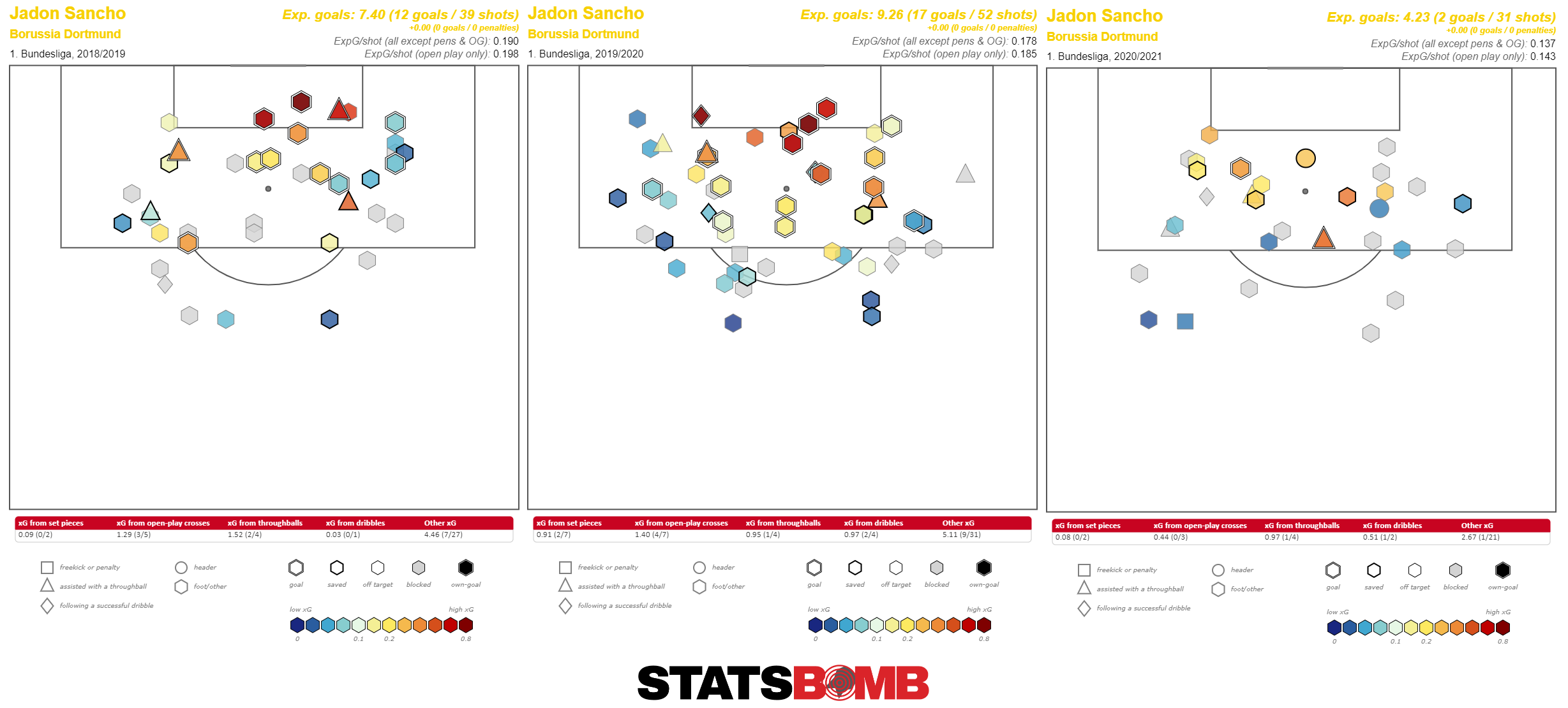
What is also obvious from the shot maps is that he just isn’t hitting the target as often this season. His Shooting % - the percentage of shots that are on target – is down from 54% last season to 23% this. Needless to say, that alone will cost you goals.
There are also issues creatively. His expected assist numbers in open play have dropped from a 1-in-3 expected-assister (0.30 OPxA) to a 1-in-5 expected-assister (0.19OPxA).
Drilling down, this appears to be an issue with his final ball. His dribbling numbers are up this season compared to last, as are his Open Play Passes Into the Box (3.57 per 90 up from 2.19), suggesting there's nothing wrong with Sancho's ability to progress the ball into dangerous areas. However, his passes completed inside the box have dropped from 1.09 per 90 in 19/20 to 0.49 per 90 this season. Once inside those dangerous areas, it's not coming off for him.
It could be that the increase in Successful Dribbles and Open Play Passes Into The Box but decline in goal-contributions are because Sancho’s playing a bigger role earlier in the attacking phase and he just hasn't been required to lay on the chances or apply the finishing touch as much as he was last season. Well, that theory gets debunked too when looking at the xGChain – a model that attributes the xG value of the final shot to all players involved in the entire possession - of Dortmund’s squad over the last two seasons.

Sancho was consistently involved in Dortmund’s most-productive attacking moves in 2019/20, whereas he’s far less involved this time. So, either Dortmund aren’t moving the ball through Sancho as much or Sancho is being more wasteful with the ball.
The data would appear to suggest the latter. His pass completion % (I know, I know) is down from 84% to 79%, his Dispossessed rate is up, and so are the number of Turnovers he's registering.
Overall, it's been a much tougher campaign for the starlet this time out, but it needs stressing that this is in the context of his very, very high standards. It’ll be interesting to see whether his form picks up at all under new Dortmund interim coach Edin Terzic, following Lucien Favre’s sacking.
Sharing the Dortmund dressing room with Sancho is Jude Bellingham, who's enjoying another positive campaign.
In case you need reminding, Bellingham banked 32.0 English Championship 90s last season at the age of 16(!). He can’t drink or drive, but he can outclass experienced professionals twice his age and look comfortable in a physically demanding league. Those who watched him last season will know that the amount of first team minutes was in no way premature, nor was the transfer and size of fee that sealed his move to Dortmund, and nor are the steady stream of minutes he’s now getting in the centre of one of the most talented teams in the world.
A mix of starts and appearances off the bench has seen him feature in 7.8 90s - about 40% of the league minutes available so far - and he’s already making an impression in the Bundesliga. Bellingham famously wears the #22 shirt because he can play in all of the ‘4’, ‘8’, or ‘10’ midfield roles and his Jude-of-all-trades skillset has been on display: contributing in breaking up opposition attacks, playing combination passes in buildup, carrying the ball through the centre of the pitch, or making runs beyond the defensive line to get on the end of chances.
With the extreme caveats that he’s only featured in <8 games worth of minutes so far and will have enjoyed the sub-effect benefits of having fresh legs off the bench, here’s how his output this season compares with his output at Birmingham last season.
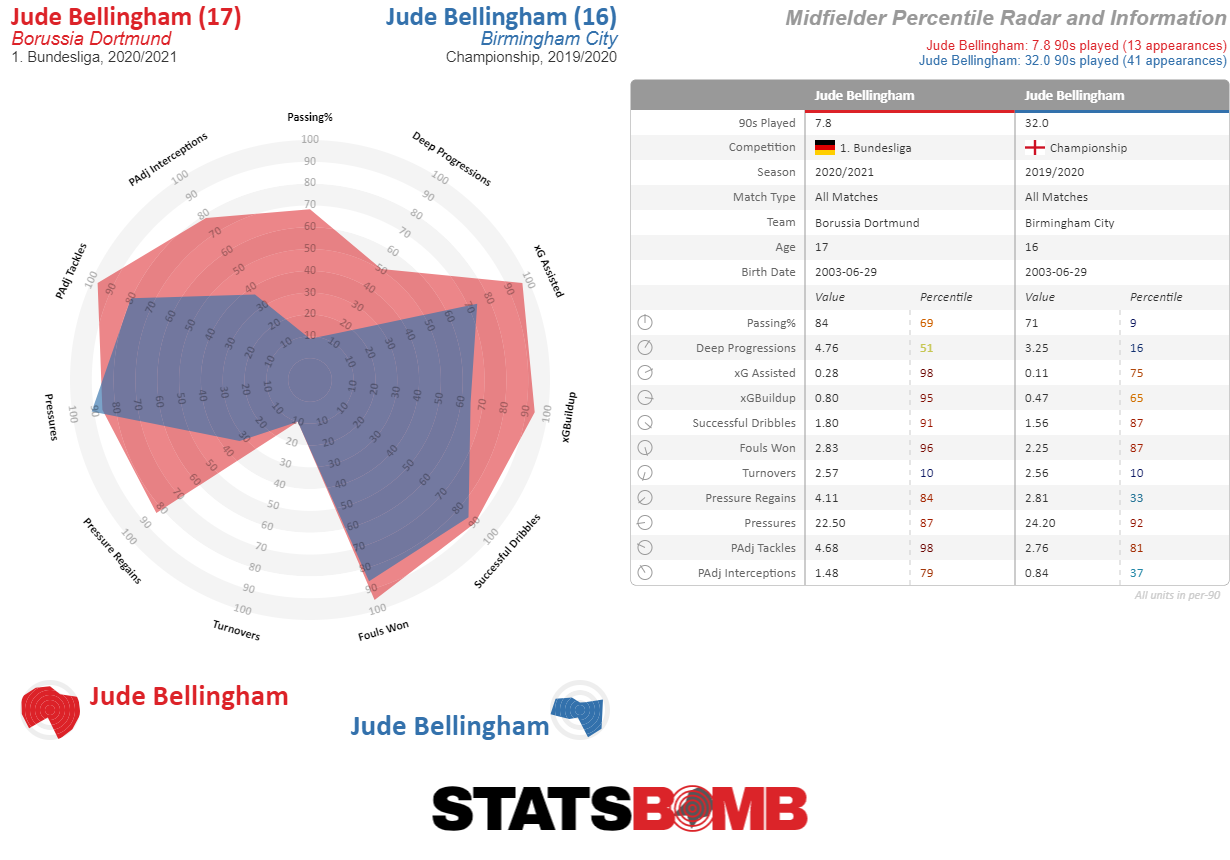
Stepping foot on the pitch for a club of Dortmund’s pedigree at his age would be a good enough indicator of his talent, but Bellingham has already been having a positive influence on the team and making a valuable contribution in every third. Add in the fact that he made his England Under-21 debut in September and his senior England debut in November, it’s been another season of rapid progression for the youngster and there’s half of it still to play. Not bad for a kid who turned 17 in June.
As if one 2003-born Englishman getting regular Bundesliga minutes at a German giant wasn’t enough, Jamal Musiala makes it two having muscled his way into the Bayern Munich first team setup this season.
Moving to Bayern’s youth setup from Chelsea in the summer of 2019, Musiala became the Bavarian behemoth’s youngest ever Bundesliga player when he came off the bench against Freiburg at the end of the 2019-20 season, aged 17 years and 115 days. It’s said that even Bayern are surprised by the speed at which he has progressed since joining the club: in just over a year, Musiala has moved through Bayern’s under-17’s, under-19’s, and reserve team to join the first team.
This season has been another leap in his rapid progression. Musiala has made 13 Bundesliga appearances – 2 starts, 11 off the bench – and has accrued 405 minutes by the mid-way point in the season. Like Bellingham, these aren’t token minutes geared at giving them experience and game time, Musiala has also made telling contributions to Bayern’s season already, his technical ability and impressive work ethic out of possession showing him to be already capable of contributing at this level. It’s a similar story in the England youth setup, with him making his Under-21’s debut in November. Some of his teammates and opponents in that game were five years his senior.
His first goal, becoming Bayern’s youngest ever goal scorer in the process, came on the opening day in the 8-0 thrashing of Schalke 04, cutting in from the left flank to finish clinically inside the near post from 16-yards, but his most impressive moment so far came in the top of the table clash against RB Leipzig on December 1st.
Having made his first start for the club versus Werder Bremen two weeks prior, Musiala was trusted to be first sub off the bench on 24 minutes after an injury to Javi Martínez, coming on ahead of a more direct replacement in Marc Roca. He made his mark within 5 minutes of coming on, bringing the scores level with another technically-accomplished finish from the edge of the area.

A series of impressive cameos and goal scoring contributions have justified Hansi Flick’s trust in throwing him into the first team so quickly and it leaves him in a good position to continue picking up valuable development time on the pitch and take part in a title race in the second half of the season.
Last but not least: Ryan Sessegnon.
With Spurs seemingly viewing Sessegnon's long-term future at left-back, as opposed to a more advanced role, a move to a club that would a) play him there but b) allow him to harness his innate attacking instincts was key for his development. It looks like he's found that at Hoffenheim.
On the surface, it’s so far, so good. He’s getting the game time he desired when making the move, playing 891 minutes – 54% of the available minutes in the Bundesliga - and his performances have been productive too, netting two goals in trademark style: calm, close-range finishes from the left-hand channel of the box after making a run inside from the wing. Sessegnon's form was so good in November that he won the club's player of the month award.
Means a lot to have been voted by the fans as the @tsghoffenheim Player of the Month and appreciate all the support I've been given since joining. Enjoying being a part of the team and will keep working hard to achieve our goals for this season. Vielen Dank! 🙏🏿 💙 #TSG pic.twitter.com/jpkFvbpaI4
— Ryan Sessegnon (@RyanSessegnon) December 2, 2020
The regular gametime in his long-term position has been crucial to Sessegnon's progression after an injury-hit first season at Spurs. Playing at left back in the Bundesliga will develop his defensive game through being tested by the calibre of wide players found in a top 5 league, but Hoffenheim's style of play also allows him to continue to influence the game in the final third. His touch map shows that he has the license to play his natural game, get up and down the flank and come inside to attack the box when Hoffenheim are in the attacking phase.

Things are looking rosy for the latest set of English imports to the Bundesliga. There's plenty of reason to keep a close eye on their development and progress in the home stretch of the campaign.
Join us at StatsBomb Evolve on March 17th 2021 to discover how we're going to change the football industry, including the launch of our new data product, StatsBomb 360. To find out more, click here.

